Paul van Yperen's Blog, page 191
July 12, 2020
Mogens Enger
Mogens Enger (1894-1918) was a Danish actor and director in the German silent cinema. In 1918 he died at the age of 24 because of the Spanish flu.
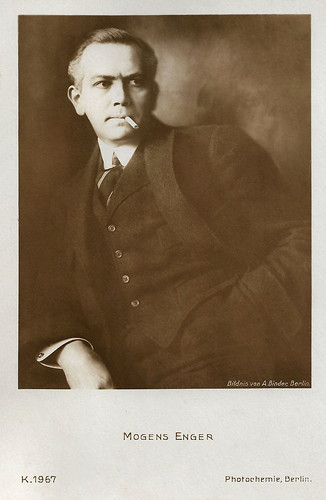
German postcard by Photochemie, no. K. 1967. Photo: Alex Binder, Berlin.
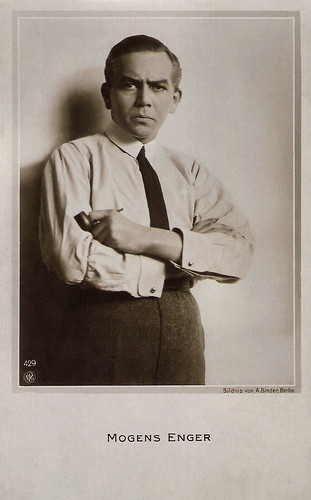
German postcard by NPG, no. 429. Photo: Alex Binder.
Detectives and crime police commissioners
Mogens Enger was born on 21 January 1894 in Copenhagen, Denmark. He was the son of bank manager Christian Enger.
Probably his film debut was as a detective in the crime film Det røde Alfabet/The Red Alphabet (Holger Rasmussen, 1915-1916) with Einar Bruun. Enger seems to have had a lead right away, judging the photos of this film on the site of the Danish Film Institute.
This was followed by a film for the Dania Biofilm Kompagni, Doktor Mors/Doctor Mors (unknown director, 1916) starring Poul Reumert. However, the usually well-informed site Danske film lists Doktor Mors as being from 1914.
Between 1915 and 1918 Enger was active in the German silent cinema. As crime films were popular in Germany during the First World War, Enger would often if not always play detectives and crime police commissioners.
He first acted in William Kahn's Der Fall Klerk/The Klerk case, shot in 1915, and released in Berlin in February 1916, at the Berlin Tauentzien-Palast. Enger immediately got the lead in this film. The film dealt with a man (Enger) suspected of murdering his father (Emil Rameau), but X-Rays clear this suspicion.
Enger subsequently became the hero as a detective in two Harry Piel crime films, Das geheimnisvolle Telephon/The mysterious phone (Harry Piel, 1916) and Unter heißer Zone/Under hot zone (Harry Piel, 1916) with Victor Janson and Martha Novelly.
After this he acted as the male lead opposite Hella Moja in three films by Otto Rippert made for Decla: Der Schwur der Renate Rabenau/The oath of Renate Rabenau (1916-17), Wenn die Lawinen stürzen/When the avalanches fall (1916-17), and Wer küßt mich?/Who kisses me? (1916-17).
Other films from 1916 with Enger were Wahn und Wahnsinn (Carl Schönfeld, 1916), Und das Blatt wendet sich/And the tide is turning (Preben Rist, 1916) with Henny Porten , Die Nicht sterben sollen/Those who shouldn't die (dir. unknown, 1916), and the Danish film Natekspressens Hemmelighed/The Secret of the Night Express (dir. unknown, 1916) again with Enger as a detective.
In 1917 he could be seen for Eiko in Blinder Lärm/Blind noise (dir. unknown, 1917) with Hanne Brinkmann , Die Bronzeschale/The bronze bowl (Rudolf Del Zopp, 1917) with Sybil Smolova , Eine Perle auf dunklem Grunde/A pearl on a dark background (Rudolf Del Zopp, 1917), Der Giftbecher/The poison cup (Fred Stranz, 1917), Der Fall Routt/The Routt Case (William Kahn, 1917), and the Danish spy film I Spionklør/In Spy claws (dir. unknown, 1917).
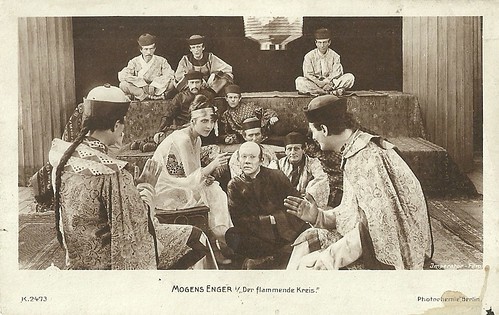
German postcard by Photochemie, Berlin, no. K. 2473. Photo: Imperator Film. Mogens Enger in Der flammende Kreis/The flaming circle (Siegfried Dessauer, 1918).
The pandemic of the Spanish Flu
In 1917 Mogens Enger joined the company Imperator-Film with a series of films starring himself, first the war propaganda film Hoch klingt das Lied vom U-Boot-Mann/Das Heldenleben des Erfinders der U-Boote Wilhelm Bauer/The song of the submarine man sounds high (Kurt Matull, 1917) with Enger as the inventor of the German submarine.
From Das verrufene Schloss Greifenstein/Ben Kabara (Siegfried Dessauer, 1917), Enger could be seen in crime films as crime police commissioner Ernst. Die Spur im Schnee/Der Schatten im Fenster/The trail in the snow (Siegfried Dessauer, Kurt Matull, 1917) with Hanne Brinkmann , and Das Geheimnis der Wetterfahne/The secret of the weather vane (Kurt Matull, 1917) with Victor Janson, followed with Enger as Detective Commissioner Ernst.
Enger directed himself in a two-part film: Marineleutnant von Brinken. 1. - Der Schuldschein des Pandola/Pandola's promissory note (Mogens Enger, 1917) and Marineleutnant von Brinken. II - Das Goldtal/The gold valley (Mogens Enger, 1918).
In 1918 he also acted in Der eiserne Käfig/The iron cage (Siegfried Dessauer, 1918), Der König der Nacht/The king of the night (Siegfried Dessauer, 1918), Der flammende Kreis/The flaming circle (Siegfried Dessauer, 1918), Falsches Geld/Wrong money (Kurt Matull?, Siegfried Dessauer, 1918), Der Fakir/The faki (Siegfried Dessauer, 1918), and Kinder der Liebe I./Children of love I. (Siegfried Dessauer, Mogens Enger, 1919) with Charlotte Böcklin.
During the shooting of Kinder der Liebe I., Mogens Enger died on 9 October 1918, at the age of only 24. He was a victim of the third wave of the pandemic of the Spanish Flu. Siegfried Dessauer had to finish the film.
Mogens Enger was married to Gertrud Enger, born Wittrup. In 1919 she remarried with director and actor Emil Johannes Zuergius Nissen.
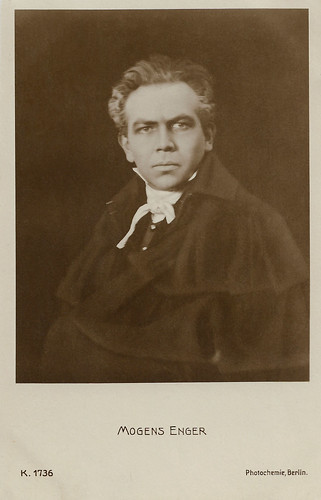
German postcard by Photochemie, Berlin, no. K. 1736.
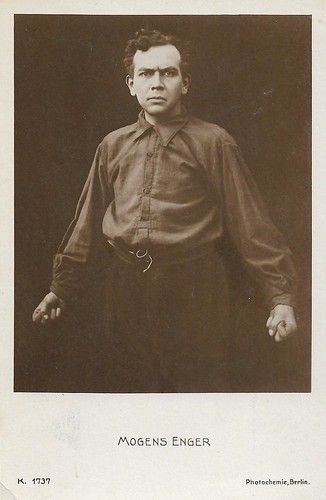
German postcard by Photochemie, Berlin, no K. 1737.
Sources: DFI, Early German Film Database, Filmportal.de, Wikipedia (German), and .

German postcard by Photochemie, no. K. 1967. Photo: Alex Binder, Berlin.

German postcard by NPG, no. 429. Photo: Alex Binder.
Detectives and crime police commissioners
Mogens Enger was born on 21 January 1894 in Copenhagen, Denmark. He was the son of bank manager Christian Enger.
Probably his film debut was as a detective in the crime film Det røde Alfabet/The Red Alphabet (Holger Rasmussen, 1915-1916) with Einar Bruun. Enger seems to have had a lead right away, judging the photos of this film on the site of the Danish Film Institute.
This was followed by a film for the Dania Biofilm Kompagni, Doktor Mors/Doctor Mors (unknown director, 1916) starring Poul Reumert. However, the usually well-informed site Danske film lists Doktor Mors as being from 1914.
Between 1915 and 1918 Enger was active in the German silent cinema. As crime films were popular in Germany during the First World War, Enger would often if not always play detectives and crime police commissioners.
He first acted in William Kahn's Der Fall Klerk/The Klerk case, shot in 1915, and released in Berlin in February 1916, at the Berlin Tauentzien-Palast. Enger immediately got the lead in this film. The film dealt with a man (Enger) suspected of murdering his father (Emil Rameau), but X-Rays clear this suspicion.
Enger subsequently became the hero as a detective in two Harry Piel crime films, Das geheimnisvolle Telephon/The mysterious phone (Harry Piel, 1916) and Unter heißer Zone/Under hot zone (Harry Piel, 1916) with Victor Janson and Martha Novelly.
After this he acted as the male lead opposite Hella Moja in three films by Otto Rippert made for Decla: Der Schwur der Renate Rabenau/The oath of Renate Rabenau (1916-17), Wenn die Lawinen stürzen/When the avalanches fall (1916-17), and Wer küßt mich?/Who kisses me? (1916-17).
Other films from 1916 with Enger were Wahn und Wahnsinn (Carl Schönfeld, 1916), Und das Blatt wendet sich/And the tide is turning (Preben Rist, 1916) with Henny Porten , Die Nicht sterben sollen/Those who shouldn't die (dir. unknown, 1916), and the Danish film Natekspressens Hemmelighed/The Secret of the Night Express (dir. unknown, 1916) again with Enger as a detective.
In 1917 he could be seen for Eiko in Blinder Lärm/Blind noise (dir. unknown, 1917) with Hanne Brinkmann , Die Bronzeschale/The bronze bowl (Rudolf Del Zopp, 1917) with Sybil Smolova , Eine Perle auf dunklem Grunde/A pearl on a dark background (Rudolf Del Zopp, 1917), Der Giftbecher/The poison cup (Fred Stranz, 1917), Der Fall Routt/The Routt Case (William Kahn, 1917), and the Danish spy film I Spionklør/In Spy claws (dir. unknown, 1917).

German postcard by Photochemie, Berlin, no. K. 2473. Photo: Imperator Film. Mogens Enger in Der flammende Kreis/The flaming circle (Siegfried Dessauer, 1918).
The pandemic of the Spanish Flu
In 1917 Mogens Enger joined the company Imperator-Film with a series of films starring himself, first the war propaganda film Hoch klingt das Lied vom U-Boot-Mann/Das Heldenleben des Erfinders der U-Boote Wilhelm Bauer/The song of the submarine man sounds high (Kurt Matull, 1917) with Enger as the inventor of the German submarine.
From Das verrufene Schloss Greifenstein/Ben Kabara (Siegfried Dessauer, 1917), Enger could be seen in crime films as crime police commissioner Ernst. Die Spur im Schnee/Der Schatten im Fenster/The trail in the snow (Siegfried Dessauer, Kurt Matull, 1917) with Hanne Brinkmann , and Das Geheimnis der Wetterfahne/The secret of the weather vane (Kurt Matull, 1917) with Victor Janson, followed with Enger as Detective Commissioner Ernst.
Enger directed himself in a two-part film: Marineleutnant von Brinken. 1. - Der Schuldschein des Pandola/Pandola's promissory note (Mogens Enger, 1917) and Marineleutnant von Brinken. II - Das Goldtal/The gold valley (Mogens Enger, 1918).
In 1918 he also acted in Der eiserne Käfig/The iron cage (Siegfried Dessauer, 1918), Der König der Nacht/The king of the night (Siegfried Dessauer, 1918), Der flammende Kreis/The flaming circle (Siegfried Dessauer, 1918), Falsches Geld/Wrong money (Kurt Matull?, Siegfried Dessauer, 1918), Der Fakir/The faki (Siegfried Dessauer, 1918), and Kinder der Liebe I./Children of love I. (Siegfried Dessauer, Mogens Enger, 1919) with Charlotte Böcklin.
During the shooting of Kinder der Liebe I., Mogens Enger died on 9 October 1918, at the age of only 24. He was a victim of the third wave of the pandemic of the Spanish Flu. Siegfried Dessauer had to finish the film.
Mogens Enger was married to Gertrud Enger, born Wittrup. In 1919 she remarried with director and actor Emil Johannes Zuergius Nissen.

German postcard by Photochemie, Berlin, no. K. 1736.

German postcard by Photochemie, Berlin, no K. 1737.
Sources: DFI, Early German Film Database, Filmportal.de, Wikipedia (German), and .
Published on July 12, 2020 22:00
July 11, 2020
Recently acquired: La Novela Semanal Cinematográfica, Part 2
Today the second and last part of our post about the postcards published by the Spanish magazine 'La Novela Semanal Cinematográfica'. Yesterday we posted 25 cards, today the second series of 25 plus one. Again it's a combination of Hollywood and European stars of the early 1920s, including several German silent film stars this time. The complete series must have counted circa 460 cards*.
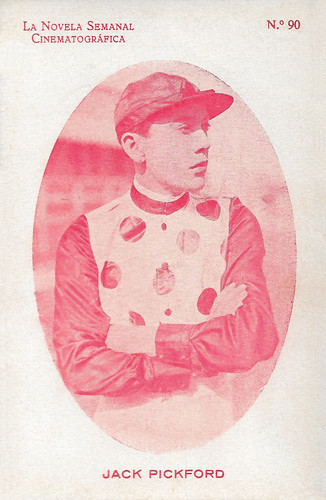
Spanish card by La Novela Semanal Cinematográfica, no. 90.
Jack Pickford (1896-1933) was a Canadian-born American actor, film director, and producer. He was the younger brother of Mary Pickford . While Jack also appeared in numerous films as the 'All American boy next door' and was a fairly popular performer, he was overshadowed by his sister's success. Also, by the late 1920s, his career had begun to decline due to alcohol, drugs, scandals, and chronic depression.
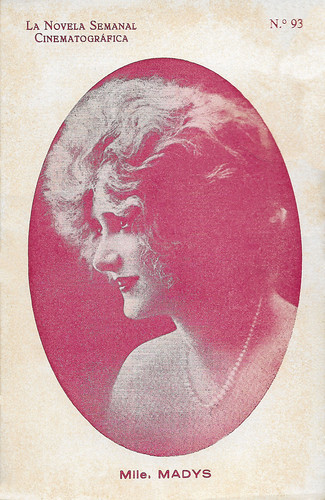
Spanish card by La Novela Semanal Cinematográfica, no. 93.
Marguerite 'Marg' Madys (1899–1986) was a French actress, born Alice Marguerite Blandin. She had a rich career in 1920s French silent cinema, acting in e.g. the serial L'Enfant-Roi (Jean Kemm, 1923), based on a fictive story to save the French dauphin from the guillotine.
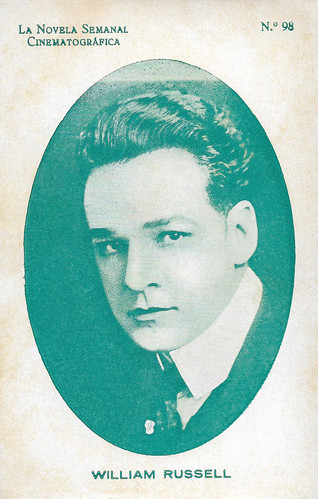
Spanish card by La Novela Semanal Cinematográfica, no. 98.
Willam Russell (1884-1929) was an American popular actor of the silent screen. He became a star in Western comedies. Russell died already at age 44 in 1929.
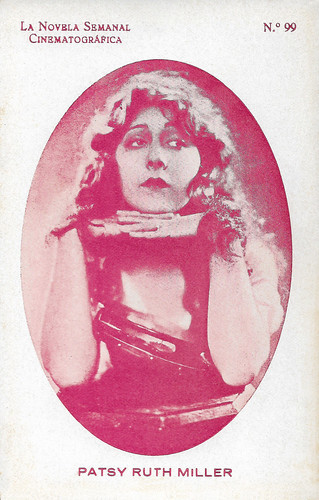
Spanish card by La Novela Semanal Cinematográfica, no. 99.
Patsy Ruth Miller (1904-1995) was an American film actress who played Esmeralda in the silent version of The Hunchback of Notre Dame (1923) opposite Lon Chaney . After a few early talkies, she retired in 1931. She later became known as a prize-winning writer.
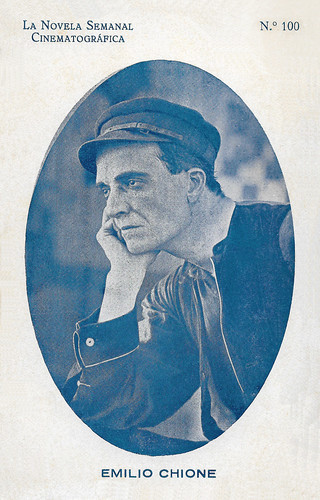
Spanish card by La Novela Semanal Cinematográfica, no. 100.
Emilio Ghione (1879-1930) was an Italian silent film actor, director, and screenwriter. He is best known for writing, directing, and starring in the Za La Mort series of adventure films, in which he played a likable French apache and 'honest outlaw.'
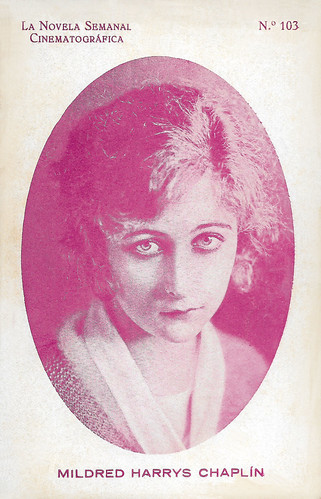
Spanish card by La Novela Semanal Cinematográfica, no. 103.
American film actress Mildred Harris (1901-1944) began her career in the film industry as a child actress when she was 11 years old. She was also the first wife of Charlie Chaplin .
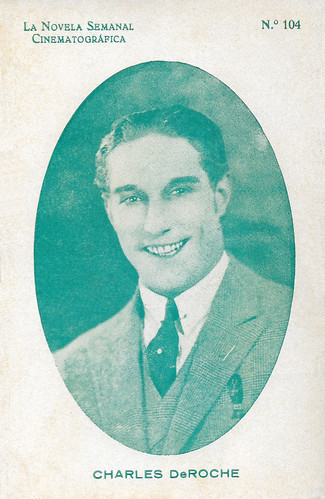
Spanish card by La Novela Semanal Cinematográfica, no. 104.
Charles de Rochefort (1887-1952) was a star of the French silent cinema. He appeared in 34 films between 1911 and 1932. In 1923 he went to the US and as Charles De Roche, he made several films in Hollywood. After his return to France, he became a film director of sound films.
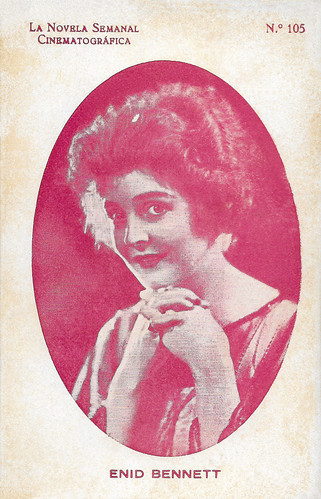
Spanish postcard by La Novela Semanal Cinematografica, no. 105.
Enid Bennett (1893-1969) was an Australian-born silent film actress, mostly active in the American cinema. She peaked in the late 1910s and early 1920s with films such as Robin Hood (1922), starring Douglas Fairbanks , and The Sea Hawk (1924). In the sound era, she played Jackie Cooper's mother in the Oscar-winning film Skippy (1931). She was the wife of director Fred Niblo and after his death of director Sidney Franklin.
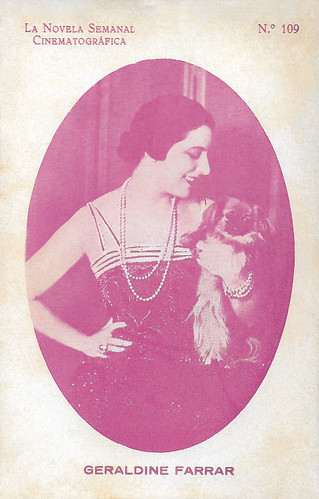
Spanish card by La Novela Semanal Cinematográfica, no. 109.
American soprano opera singer and film actress Geraldine Farrar (1882-1967) was noted for her glamorous beauty, acting ability, and the timbre of her voice. Barely 20, she was already the toast of Berlin. Later at the Met in New York, she had a large following among young women, who were nicknamed ‘Gerry-flappers’. Farrar also starred in more than a dozen silent films from 1915 to 1920. She was married to and co-starred with Dutch matinee idol Lou Tellegen .
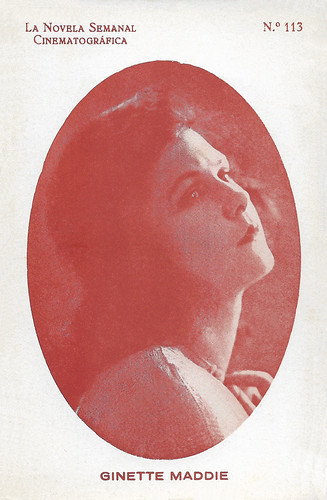
Spanish card by La Novela Semanal Cinematográfica, no. 113.
Ginette Maddie (1898-1980) was a French actress who acted in French and German silent films. Between 1922 and 1958, she appeared in 20 films with such notable directors as Alfred Machin and Julien Duvivier.
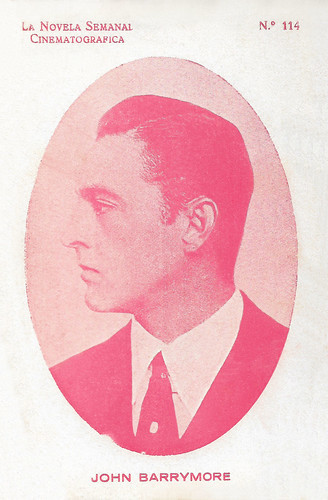
Spanish postcard by La Novela Semanal Cinematografica, no. 114.
John Barrymore (1882-1942) was an American stage and screen actor whose rise to superstardom and subsequent decline is one of the legendary tragedies of Hollywood. A member of the most famous generation of the most famous theatrical family in America, he was also its most acclaimed star. He excelled in high drama, in productions of 'Justice' (1916), 'Richard III' (1920) and 'Hamlet' (1922). After a success as Hamlet in London in 1925, Barrymore left the stage for 14 years and instead focused entirely on films.
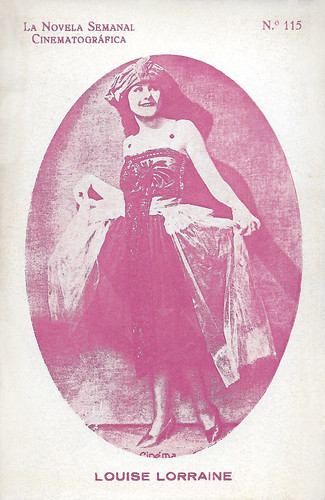
Spanish card by La Novela Semanal Cinematográfica, no. 115.
Louise Lorraine (1904-1981) was an American film actress, who started out in two-reel comedies for independent studios, then spent time at MGM and Universal. She became very popular in action-filled silent serials and may be best remembered for being the third actress to portray Jane, in the serial The Adventures of Tarzan (1921). In 1930, she retired from the film industry.
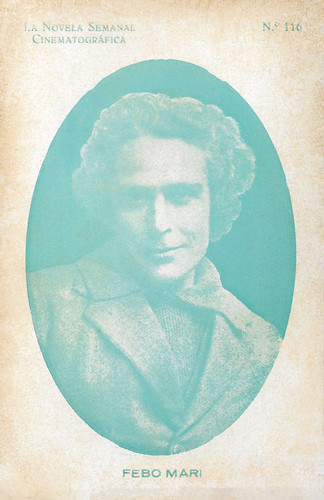
Spanish postcard by La Novela Semanal Cinematográfica, no. 116.
Febo Mari (1881-1939) was an Italian actor, director, and writer of the stage, screen, and radio, who peaked in the 1910s with films such as Il fuoco (1915), Cenere (1916) and Il fauno (1917).
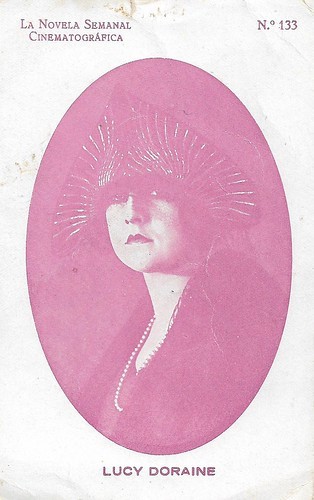
Spanish postcard by La Novela Semanal Cinematográfica, no. 133.
Despite her French name, Lucy Doraine (1898-1989) was a major Austrian-Hungarian actress in the Austrian and German cinema of the 1920s. When she moved to Hollywood, the revolution of the sound film finished her career.
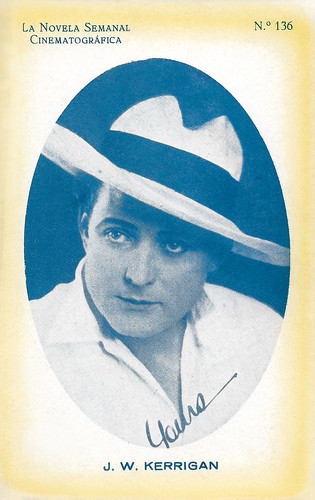
Spanish card by La Novela Semanal Cinematográfica, no. 136.
J. (Jack) Warren Kerrigan (1879-1947) was an American actor of the silent screen. From 1910, he had a most active career first in shorts at Essanay, American at Victor, then in features at Universal. After a gap in the early 1920s, he came back with a bang in James Cruze's The Covered Wagon (1923) but stopped acting in 1924 after a car accident.
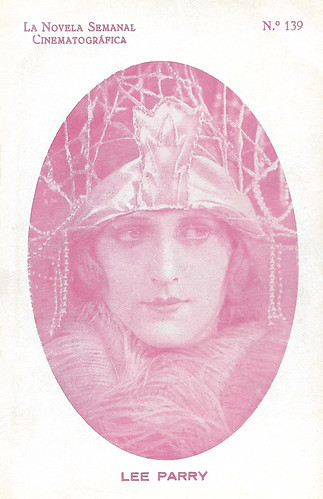
Spanish postcard by La Novela Semanal Cinematográfica, no. 139.
Lee Parry (1901-1977) was a glamorous German film actress of the silent and the early sound era. She often starred in films by her husband Richard Eichberg. She appeared in 48 films between 1919 and 1939.
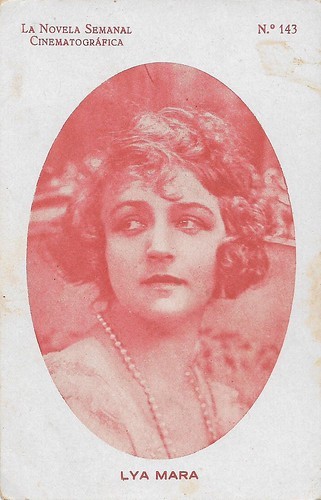
Spanish postcard by La Novela Semanal Cinematográfica, no. 143.
Lya Mara (1897-1969) was one of the biggest stars of the German silent cinema. Her stardom was even the subject of a novel, which was published in 100 episodes between 1927 and 1928. Her career virtually ended after the arrival of sound film.
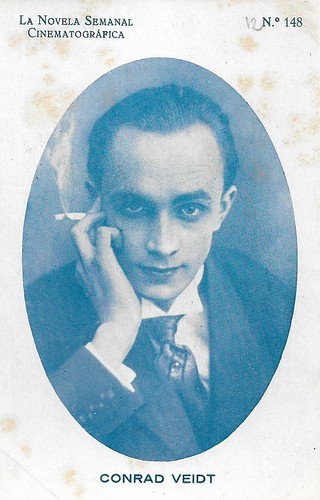
Spanish postcard by La Novela Semanal Cinematografica, no. 148.
Conrad Veidt (1893–1943) was the 'most highly strung and romantically handsome of the German expressionist actors'. From 1916 until his death, he appeared in over 100 films, including such classics as Das Cabinet des Dr. Caligari (1920) as the sleep-walking killer Cesare, and Casablanca (1942) as Nazi Major Heinrich Strasser. He played in the 'first gay film', Anders als die Andern (1919) and his starring role in The Man Who Laughs (1928) was the inspiration for Batman's greatest enemy, The Joker.
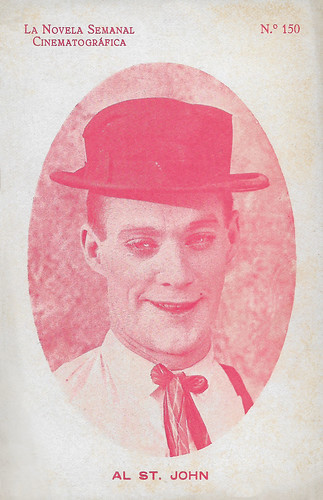
Spanish card by La Novela Semanal Cinematográfica, no. 150.
Al St. John (1892-1963) was an early American film comedian, and nephew of Roscoe 'Fatty' Arbuckle , with whom he often appeared. He played in dozens of Mack Sennett's early Keystone comedies and worked with Charlie Chaplin , Buster Keaton , and Mabel Normand. He would eventually create and star in his own vehicles for other studios. In the sound era, he was the sidekick of B-Western heroes like Bob Steele and Buster Crabbe. He played the scruffy comedy relief character 'Fuzzy Q. Jones' in the Billy the Kid series (1940-1946), and the Lone Rider series (1941-1943). From 1912 to 1952, Al St. John acted in 346 films.
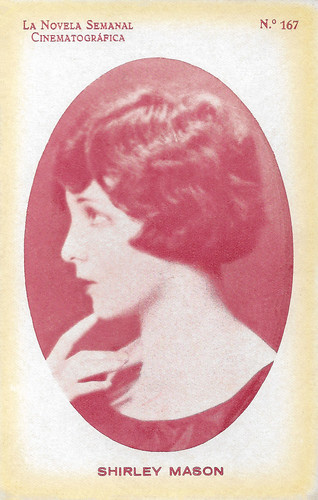
Spanish card by La Novela Semanal Cinematográfica, no. 167.
Shirley Mason (1901-1979) was an American actress of the silent era. She was a sister of Viola Dana . She made her film debut at the age of 10. Between 1910 and 1929, she made more than 110 films.
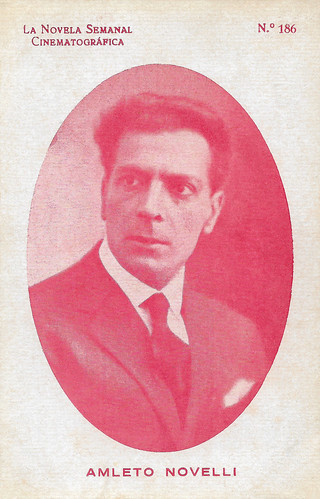
Spanish postcard by La Novela Semanal Cinematografica, no. 186.
Amleto Novelli (1885-1924) was a famous actor in Italian silent cinema, as well in epic and historical cinema as in diva films.
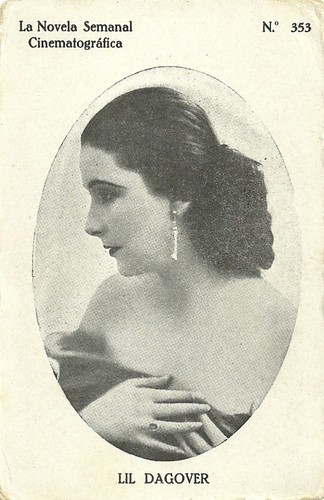
Spanish postcard by La Novela Semanal Cinematografica, no. 353.
German, but Dutch-born film actress Lil Dagover (1887-1980) was an exotic, dark beauty, who featured prominently during the golden age of the German silent cinema. She had her breakthrough as the prey of Dr. Caligari's monster in the classic expressionist film Das Cabinet des Dr. Caligari (1920) but gradually her fine and evanescent beauty changed and she turned into a 'Salondame', a lady of the screen. Her career would span nearly six decades.
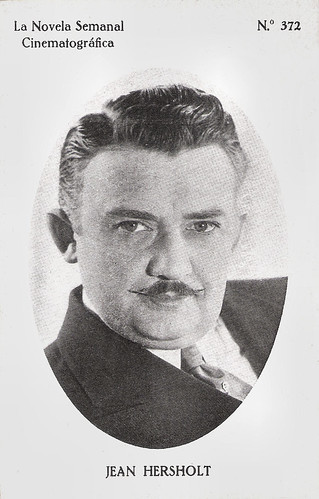
Spanish card by La Novela Semanal Cinematográfica, no. 372.
Jean Hersholt (1886-1956) was a Danish-born actor who lived in the United States, where he appeared in 75 silent films and 65 sound films and directed four films. He was best known for his villain role in Erich von Stroheim 's classic Greed (1924) and as Shirley Temple' s grandfather in Heidi (1937). For 17 years he starred on American radio in 'Dr. Christian'.
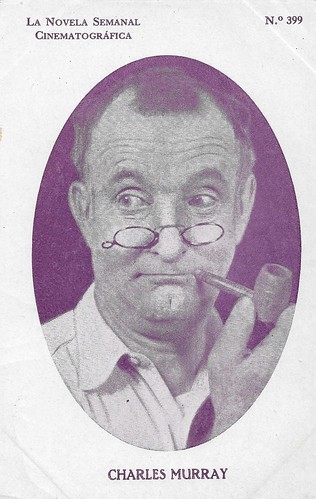
Spanish postcard by La Novela Semanal Cinematográfica, no. 399.
American comedian Charles Murray (1872-1941) worked with George Sydney on a series of comedies around the Jewish Nate Cohen and the Irish-Catholic Patrick Kelly, two business partners who are constantly fighting. Murray appeared in 283 films between 1912 and 1938, and also directed 5 films.
* Troy Kirk's The Movie Card Website contains a list of the La Novela Semanal Cinematográfica cards, which goes as far as number 455.

Spanish card by La Novela Semanal Cinematográfica, no. 90.
Jack Pickford (1896-1933) was a Canadian-born American actor, film director, and producer. He was the younger brother of Mary Pickford . While Jack also appeared in numerous films as the 'All American boy next door' and was a fairly popular performer, he was overshadowed by his sister's success. Also, by the late 1920s, his career had begun to decline due to alcohol, drugs, scandals, and chronic depression.

Spanish card by La Novela Semanal Cinematográfica, no. 93.
Marguerite 'Marg' Madys (1899–1986) was a French actress, born Alice Marguerite Blandin. She had a rich career in 1920s French silent cinema, acting in e.g. the serial L'Enfant-Roi (Jean Kemm, 1923), based on a fictive story to save the French dauphin from the guillotine.

Spanish card by La Novela Semanal Cinematográfica, no. 98.
Willam Russell (1884-1929) was an American popular actor of the silent screen. He became a star in Western comedies. Russell died already at age 44 in 1929.

Spanish card by La Novela Semanal Cinematográfica, no. 99.
Patsy Ruth Miller (1904-1995) was an American film actress who played Esmeralda in the silent version of The Hunchback of Notre Dame (1923) opposite Lon Chaney . After a few early talkies, she retired in 1931. She later became known as a prize-winning writer.

Spanish card by La Novela Semanal Cinematográfica, no. 100.
Emilio Ghione (1879-1930) was an Italian silent film actor, director, and screenwriter. He is best known for writing, directing, and starring in the Za La Mort series of adventure films, in which he played a likable French apache and 'honest outlaw.'

Spanish card by La Novela Semanal Cinematográfica, no. 103.
American film actress Mildred Harris (1901-1944) began her career in the film industry as a child actress when she was 11 years old. She was also the first wife of Charlie Chaplin .

Spanish card by La Novela Semanal Cinematográfica, no. 104.
Charles de Rochefort (1887-1952) was a star of the French silent cinema. He appeared in 34 films between 1911 and 1932. In 1923 he went to the US and as Charles De Roche, he made several films in Hollywood. After his return to France, he became a film director of sound films.

Spanish postcard by La Novela Semanal Cinematografica, no. 105.
Enid Bennett (1893-1969) was an Australian-born silent film actress, mostly active in the American cinema. She peaked in the late 1910s and early 1920s with films such as Robin Hood (1922), starring Douglas Fairbanks , and The Sea Hawk (1924). In the sound era, she played Jackie Cooper's mother in the Oscar-winning film Skippy (1931). She was the wife of director Fred Niblo and after his death of director Sidney Franklin.

Spanish card by La Novela Semanal Cinematográfica, no. 109.
American soprano opera singer and film actress Geraldine Farrar (1882-1967) was noted for her glamorous beauty, acting ability, and the timbre of her voice. Barely 20, she was already the toast of Berlin. Later at the Met in New York, she had a large following among young women, who were nicknamed ‘Gerry-flappers’. Farrar also starred in more than a dozen silent films from 1915 to 1920. She was married to and co-starred with Dutch matinee idol Lou Tellegen .

Spanish card by La Novela Semanal Cinematográfica, no. 113.
Ginette Maddie (1898-1980) was a French actress who acted in French and German silent films. Between 1922 and 1958, she appeared in 20 films with such notable directors as Alfred Machin and Julien Duvivier.

Spanish postcard by La Novela Semanal Cinematografica, no. 114.
John Barrymore (1882-1942) was an American stage and screen actor whose rise to superstardom and subsequent decline is one of the legendary tragedies of Hollywood. A member of the most famous generation of the most famous theatrical family in America, he was also its most acclaimed star. He excelled in high drama, in productions of 'Justice' (1916), 'Richard III' (1920) and 'Hamlet' (1922). After a success as Hamlet in London in 1925, Barrymore left the stage for 14 years and instead focused entirely on films.

Spanish card by La Novela Semanal Cinematográfica, no. 115.
Louise Lorraine (1904-1981) was an American film actress, who started out in two-reel comedies for independent studios, then spent time at MGM and Universal. She became very popular in action-filled silent serials and may be best remembered for being the third actress to portray Jane, in the serial The Adventures of Tarzan (1921). In 1930, she retired from the film industry.

Spanish postcard by La Novela Semanal Cinematográfica, no. 116.
Febo Mari (1881-1939) was an Italian actor, director, and writer of the stage, screen, and radio, who peaked in the 1910s with films such as Il fuoco (1915), Cenere (1916) and Il fauno (1917).

Spanish postcard by La Novela Semanal Cinematográfica, no. 133.
Despite her French name, Lucy Doraine (1898-1989) was a major Austrian-Hungarian actress in the Austrian and German cinema of the 1920s. When she moved to Hollywood, the revolution of the sound film finished her career.

Spanish card by La Novela Semanal Cinematográfica, no. 136.
J. (Jack) Warren Kerrigan (1879-1947) was an American actor of the silent screen. From 1910, he had a most active career first in shorts at Essanay, American at Victor, then in features at Universal. After a gap in the early 1920s, he came back with a bang in James Cruze's The Covered Wagon (1923) but stopped acting in 1924 after a car accident.

Spanish postcard by La Novela Semanal Cinematográfica, no. 139.
Lee Parry (1901-1977) was a glamorous German film actress of the silent and the early sound era. She often starred in films by her husband Richard Eichberg. She appeared in 48 films between 1919 and 1939.

Spanish postcard by La Novela Semanal Cinematográfica, no. 143.
Lya Mara (1897-1969) was one of the biggest stars of the German silent cinema. Her stardom was even the subject of a novel, which was published in 100 episodes between 1927 and 1928. Her career virtually ended after the arrival of sound film.

Spanish postcard by La Novela Semanal Cinematografica, no. 148.
Conrad Veidt (1893–1943) was the 'most highly strung and romantically handsome of the German expressionist actors'. From 1916 until his death, he appeared in over 100 films, including such classics as Das Cabinet des Dr. Caligari (1920) as the sleep-walking killer Cesare, and Casablanca (1942) as Nazi Major Heinrich Strasser. He played in the 'first gay film', Anders als die Andern (1919) and his starring role in The Man Who Laughs (1928) was the inspiration for Batman's greatest enemy, The Joker.

Spanish card by La Novela Semanal Cinematográfica, no. 150.
Al St. John (1892-1963) was an early American film comedian, and nephew of Roscoe 'Fatty' Arbuckle , with whom he often appeared. He played in dozens of Mack Sennett's early Keystone comedies and worked with Charlie Chaplin , Buster Keaton , and Mabel Normand. He would eventually create and star in his own vehicles for other studios. In the sound era, he was the sidekick of B-Western heroes like Bob Steele and Buster Crabbe. He played the scruffy comedy relief character 'Fuzzy Q. Jones' in the Billy the Kid series (1940-1946), and the Lone Rider series (1941-1943). From 1912 to 1952, Al St. John acted in 346 films.

Spanish card by La Novela Semanal Cinematográfica, no. 167.
Shirley Mason (1901-1979) was an American actress of the silent era. She was a sister of Viola Dana . She made her film debut at the age of 10. Between 1910 and 1929, she made more than 110 films.

Spanish postcard by La Novela Semanal Cinematografica, no. 186.
Amleto Novelli (1885-1924) was a famous actor in Italian silent cinema, as well in epic and historical cinema as in diva films.

Spanish postcard by La Novela Semanal Cinematografica, no. 353.
German, but Dutch-born film actress Lil Dagover (1887-1980) was an exotic, dark beauty, who featured prominently during the golden age of the German silent cinema. She had her breakthrough as the prey of Dr. Caligari's monster in the classic expressionist film Das Cabinet des Dr. Caligari (1920) but gradually her fine and evanescent beauty changed and she turned into a 'Salondame', a lady of the screen. Her career would span nearly six decades.

Spanish card by La Novela Semanal Cinematográfica, no. 372.
Jean Hersholt (1886-1956) was a Danish-born actor who lived in the United States, where he appeared in 75 silent films and 65 sound films and directed four films. He was best known for his villain role in Erich von Stroheim 's classic Greed (1924) and as Shirley Temple' s grandfather in Heidi (1937). For 17 years he starred on American radio in 'Dr. Christian'.

Spanish postcard by La Novela Semanal Cinematográfica, no. 399.
American comedian Charles Murray (1872-1941) worked with George Sydney on a series of comedies around the Jewish Nate Cohen and the Irish-Catholic Patrick Kelly, two business partners who are constantly fighting. Murray appeared in 283 films between 1912 and 1938, and also directed 5 films.
* Troy Kirk's The Movie Card Website contains a list of the La Novela Semanal Cinematográfica cards, which goes as far as number 455.
Published on July 11, 2020 22:00
July 10, 2020
Recently acquired: La Novela Semanal Cinematográfica, Part 1
We found a series of vintage Spanish cards with pictures of silent film stars - in blue, brown, purple, pink, and green. Not exactly a common style, now nor then. And all the pictures are oval-formed, to top it off. These blank-backed cards were published in Barcelona by Francisco Mario Bistagne, editor of 'La Novela Semanal Cinematográfica'. This magazine was very popular in Spain from November 1922, when the first number appeared, until August 1932, when it stopped being published. Interestingly, the cards show that Italian stars must have been still popular in Spain at the time, and there are also many cards of forgotten stars whose postcards are now hard to find. Ivo and I selected 50 cards which we will publish in two posts. The second post will follow tomorrow.
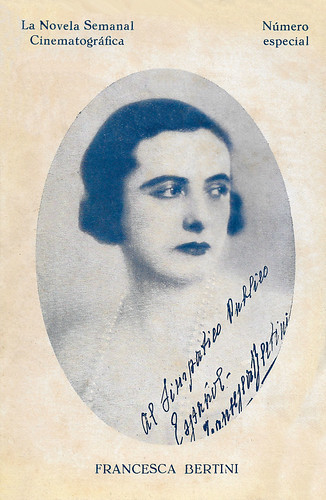
Spanish postcard by La Novela Semanal Cinematográfica, Número especial (special number).
Majestic diva of the Italian silent cinema Francesca Bertini (1892-1985) was one of the first European film stars. During the first quarter of the twentieth century, she often played the 'femme fatale', with men devouring eyes, glamorous attire, clenched fists, and in opulent settings.
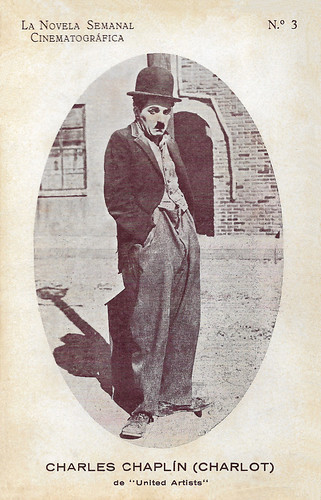
Spanish postcard by La Novela Semanal Cinematográfica, no. 3. Photo: United Artists (but the film was produced by First National). Charles Chaplin in A Dog's Life (Charles Chaplin, 1918). Charlot was the Spanish nickname for Chaplin.
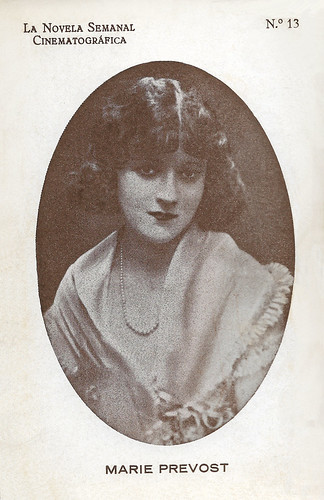
Spanish postcard by La Novela Semanal Cinematográfica, no. 13.
Marie Prevost (1898-1937) was a Canadian-born, American silent screen actress. She was excellent in such comedies as Ernst Lubitsch 's The Marriage Circle (1924). The end of her life was filled with tragedies.
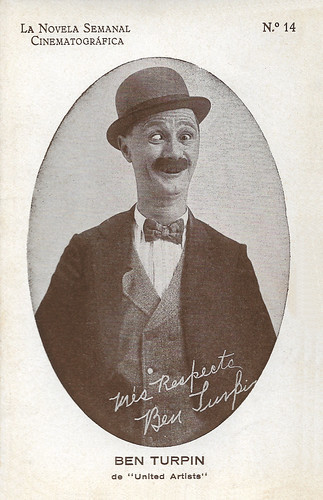
Spanish card by La Novela Semanal Cinematográfica, no. 14. Photo: United Artists.
Cross-eyed silent comedian Ben Turpin (1869-1940) was not born that way. Supposedly his right eye slipped out of alignment while playing the role of the similarly afflicted Happy Hooligan in vaudeville and it never adjusted. Ironically, it was this disability that would enhance his comic value and make him a top name in the silent film era. Turpin's true forte was impersonating the most dashingly romantic and sophisticated stars of the day and turning them into clumsy oafs. He also invented a Hollywood tradition by being the first actor to receive a pie in his face.
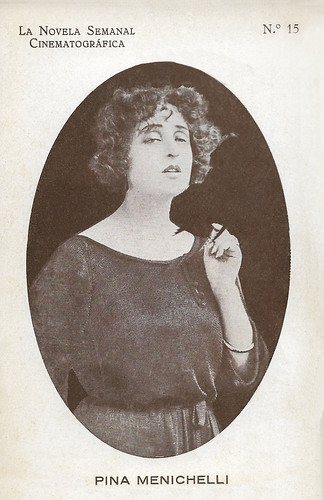
Spanish card by La Novela Semanal Cinematográfica, no. 15.
Fascinating and enigmatic Pina Menichelli (1890-1984) was the most bizarre Italian diva of the silent era. With her contorted postures and disdainful expression, she impersonated the striking femme fatale.
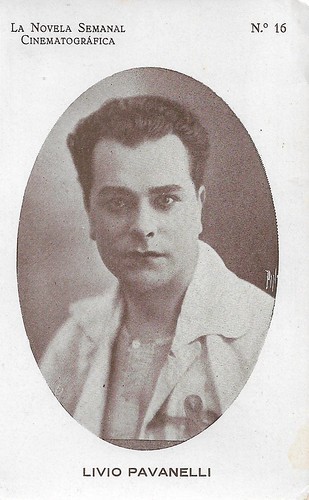
Spanish postcard by La Novela Semanal Cinematográfica, no. 16. Photo Pinto, Rome.
Livio Pavanelli (1881-1958) was an Italian actor of the Italian and in particular German silent cinema. He also worked in Italian sound cinema as an actor and as a production manager. He directed four Italian films, both in the silent and the sound era.
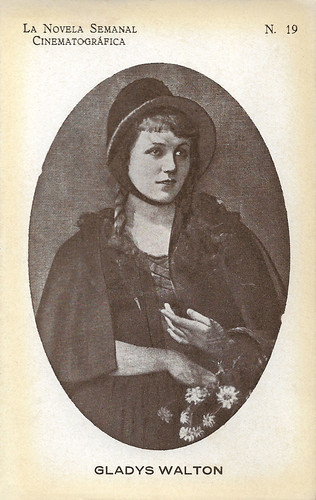
Spanish postcard by La Novela Semanal Cinematográfica, no. 19.
Gladys Walton (1903-1993) was an American actress, who peaked in the American silent film of the 1920s. She was a flapper in such films such as The Girl Who Ran Wild (1922), and The Wise Kid (1922).
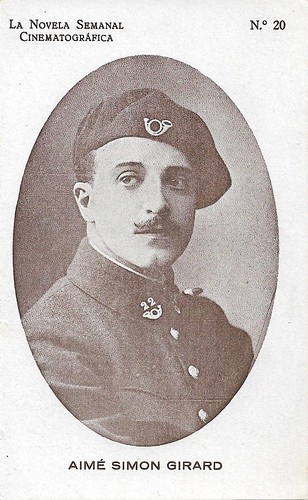
Spanish postcard by La Novela Semanal Cinematográfica, no. 20.
Aimé Simon-Girard (1889-1950) was a French film actor and operetta singer. He mostly played in French costume films of the 1920s and 1930s.
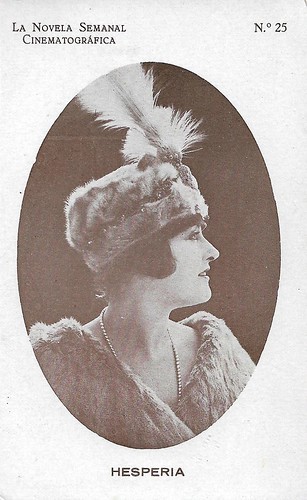
Spanish postcard by La Novela Semanal Cinematográfica, no. 25.
Hesperia (1885-1959), was one of the Italian divas of the silent screen. She often worked with director Baldassarre Negroni, who later became her husband.
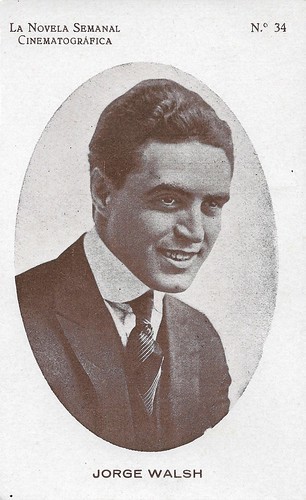
Spanish postcard by La Novela Semanal Cinematográfica, no. 34.
George Walsh (1889-1981) was an American film actor, who despite a successful career in silent cinema is best remembered for the part that was taken off from him: the title role in Ben-Hur (1925).
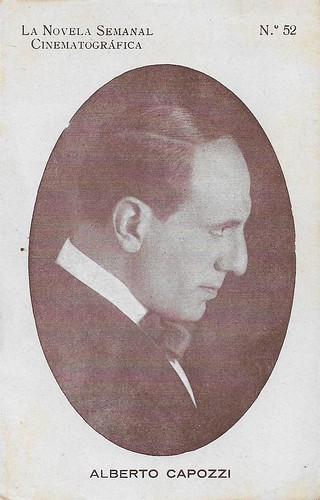
Spanish card by La Novela Semanal Cinemátografica, no. 52.
Alberto Capozzi (1886-1945) was an Italian film and stage actor who had an enormous career in Italian cinema in the 1910s and early 1920s. Afterward, he pursued a career abroad in Austria and as a sound dubber in France. He returned to film acting in Italian cinema in the early 1940s.
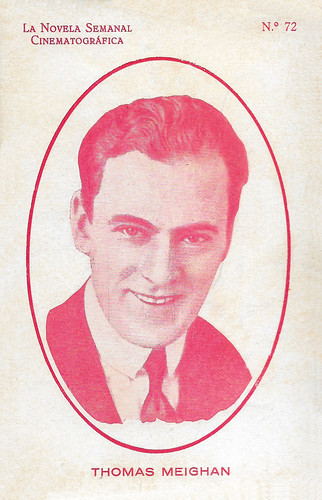
Spanish postcard by La Novela Semanal Cinematografica, no. 72.
Thomas Meighan (1879-1936) was an American stage and screen actor. He starred in seven silent films by William C. de Mille and five others by his brother, Cecil B. DeMille.
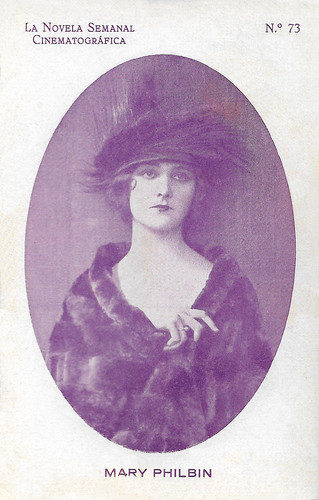
Spanish card by La Novela Semanal Cinematográfica, no. 73.
Mary Philbin (1902-1993) was an American film actress of the silent film era, who is best known for playing the roles of Christine Daaé in The Phantom of the Opera (Rupert Julian, 1925) opposite Lon Chaney , and as Dea in The Man Who Laughs (Paul Leni, 1928), opposite Conrad Veidt .
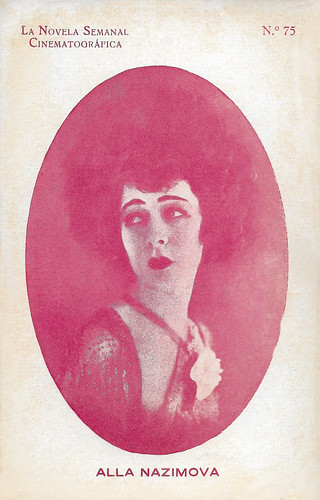
Spanish postcard by La Novela Semanal Cinematografica, no. 75.
Alla Nazimova (1879–1945) was a grand, highly flamboyant star of the American silent cinema. The Russian-born film and theatre actress, screenwriter, and film producer was widely known as just Nazimova. On Broadway, she was noted for her work in the classic plays of Ibsen, Chekhov, and Turgenev. Her efforts at silent film production were less successful, but a few sound-film performances survive as a record of her art.
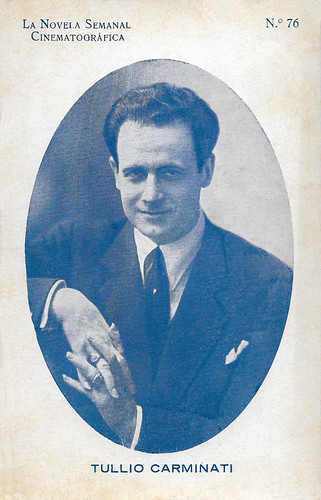
Spanish card by La Novela Semanal Cinematográfica, no. 76.
Tullio Carminati (1895-1971) was an Italian stage and film actor with a longstanding career from the 1910s to the 1960s. He played in Italian, German, American, British, and French films and on Italian, American, and British stages.
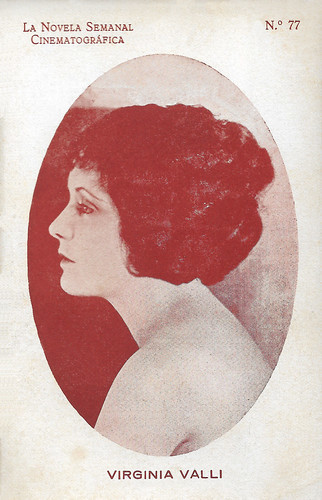
Spanish card by La Novela Semanal Cinematográfica, no. 77.
Virginia Valli (1895–1968) was an American stage and film actress whose motion picture career started in the silent film era and lasted until the beginning of the sound film era of the 1930s.
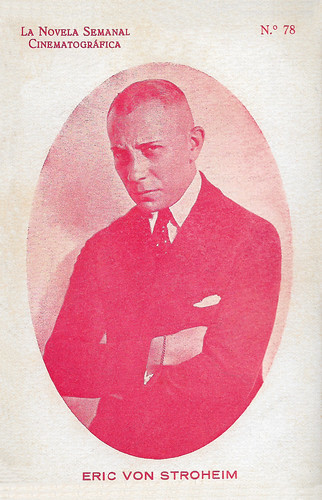
Spanish card by La Novela Semanal Cinematográfica, no. 78.
Was Austrian-born Erich von Stroheim (1885-1957) a Hollywood movie star or a European film star? (Who cares!) As the sadistic, monocled Prussian officer in both American and French films, he became ‘The Man You Love to Hate’. But maybe he is best known as one of the greatest and influential directors of the silent era, known for his extravaganza and the uncompromising accuracy of detail in his monumental films.
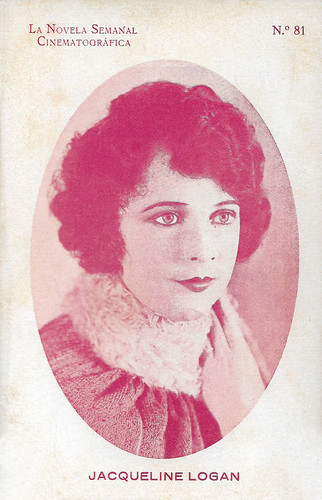
Spanish card by La Novela Semanal Cinematográfica, no. 81.
Jacqueline Logan (1901-1983) was an American actress of the silent screen. Her most famous part is that of Mary Magdalene in the biblical epic The King of Kings (1927) by Cecil B. DeMille.
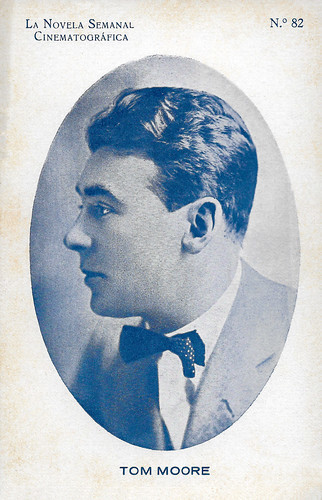
Spanish card by La Novela Semanal Cinemátografica, no. 82.
Tom Moore (1883-1955) was an Irish-American actor and director. From 1908 to 1954, he appeared in at least 186 films. Frequently cast as the romantic lead, he starred in silent films as well as in some of the first sound films.
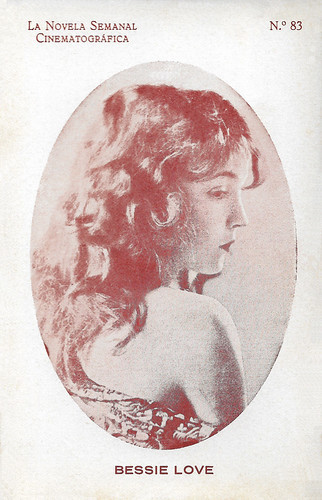
Spanish postcard by La Novela Semanal Cinematografica, no. 83.
American actress Bessie Love (1898-1986) was introduced to the cinema by D.W. Griffith. He also gave the actress her screen name. She played innocent young girls and wholesome leading ladies in silent films and early talkies. Her acting career spanned eight decades, and her role in The Broadway Melody (1929) earned her a nomination for the Oscar for Best Actress.
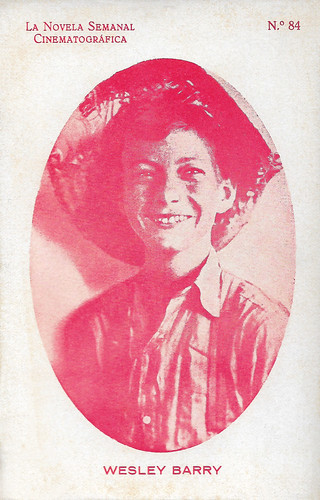
Spanish card by La Novela Semanal Cinematográfica, no. 84.
Wesley Barry (1907-1994) was an adorable child actor in silent films who was known for his face full of freckles. He later became a producer and director of both film and television. As a director, he was sometimes billed as Wesley E. Barry.
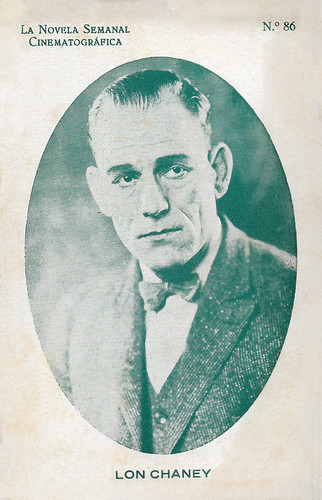
Spanish postcard by La Novela Semanal Cinematografica, no. 86.
American stage and film actor, director, and screenwriter Lon Chaney (1883-1930) is regarded as one of the most versatile and powerful actors of early cinema. Between 1912 and 1930 he played more the 150 widely diverse roles. He is renowned for his characterizations of tortured, often grotesque and afflicted characters, and his groundbreaking artistry with makeup. ‘The Man of a Thousand Faces’ starred in such silent horror films as The Hunchback of Notre Dame (1923) and The Phantom of the Opera (1925).
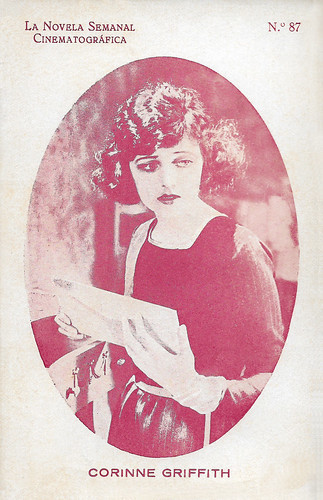
Spanish postcard by La Novela Semanal Cinematografica, no. 87.
Corinne Griffith (1894–1979) was an American film actress, producer, and author. Dubbed 'The Orchid Lady of the Screen', she was one of the most popular film actresses of the 1920s and widely considered the most beautiful actress of the silent screen. While she started out at Vitagraph in 1916, she became a very popular actress at First National Pictures. Griffith was nominated for the Academy Award for Best Actress for her performance in Frank Lloyd's The Divine Lady, a 1929 American Vitaphone sound film with a synchronised musical score, sound effects, and some synchronised singing, but no spoken dialogue. Griffith played the female lead of Lady Hamilton, opposite Victor Varconi as Horatio Nelson. When sound film set in, Griffith stopped acting and became a successful writer and businesswoman.
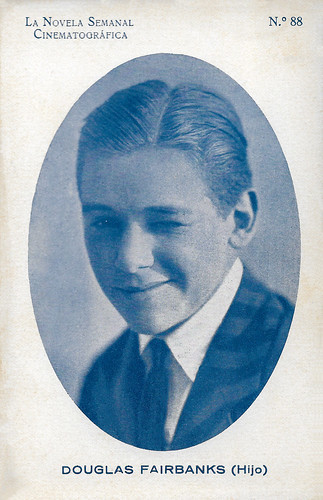
Spanish card by La Novela Semanal Cinematográfica, no. 88.
Handsome and distinguished, Douglas Fairbanks Jr. (1909-2000) was much more than the son of his superstar father. He was a bright, multi-talent, who excelled in sports and sculpting, was involved in the business, and was knighted for his war efforts as a lieutenant. And he acted in approximately 100 films or TV shows.
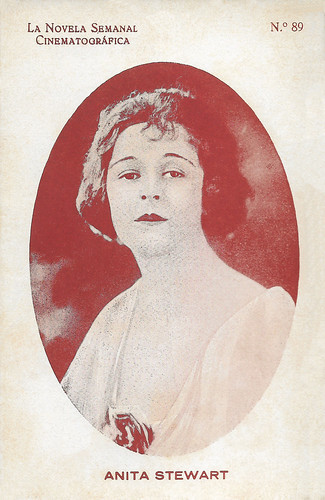
Spanish card by La Novela Semanal Cinematográfica, no. 89.
Anita Stewart (1895-1961) was an American actress who achieved success during the silent period. From 1911 on, she worked with director Ralph Ince for Vitagraph, later she had her own film company at Metro. The advent of the sound film ended her career.
To be continued tomorrow.

Spanish postcard by La Novela Semanal Cinematográfica, Número especial (special number).
Majestic diva of the Italian silent cinema Francesca Bertini (1892-1985) was one of the first European film stars. During the first quarter of the twentieth century, she often played the 'femme fatale', with men devouring eyes, glamorous attire, clenched fists, and in opulent settings.

Spanish postcard by La Novela Semanal Cinematográfica, no. 3. Photo: United Artists (but the film was produced by First National). Charles Chaplin in A Dog's Life (Charles Chaplin, 1918). Charlot was the Spanish nickname for Chaplin.

Spanish postcard by La Novela Semanal Cinematográfica, no. 13.
Marie Prevost (1898-1937) was a Canadian-born, American silent screen actress. She was excellent in such comedies as Ernst Lubitsch 's The Marriage Circle (1924). The end of her life was filled with tragedies.

Spanish card by La Novela Semanal Cinematográfica, no. 14. Photo: United Artists.
Cross-eyed silent comedian Ben Turpin (1869-1940) was not born that way. Supposedly his right eye slipped out of alignment while playing the role of the similarly afflicted Happy Hooligan in vaudeville and it never adjusted. Ironically, it was this disability that would enhance his comic value and make him a top name in the silent film era. Turpin's true forte was impersonating the most dashingly romantic and sophisticated stars of the day and turning them into clumsy oafs. He also invented a Hollywood tradition by being the first actor to receive a pie in his face.

Spanish card by La Novela Semanal Cinematográfica, no. 15.
Fascinating and enigmatic Pina Menichelli (1890-1984) was the most bizarre Italian diva of the silent era. With her contorted postures and disdainful expression, she impersonated the striking femme fatale.

Spanish postcard by La Novela Semanal Cinematográfica, no. 16. Photo Pinto, Rome.
Livio Pavanelli (1881-1958) was an Italian actor of the Italian and in particular German silent cinema. He also worked in Italian sound cinema as an actor and as a production manager. He directed four Italian films, both in the silent and the sound era.

Spanish postcard by La Novela Semanal Cinematográfica, no. 19.
Gladys Walton (1903-1993) was an American actress, who peaked in the American silent film of the 1920s. She was a flapper in such films such as The Girl Who Ran Wild (1922), and The Wise Kid (1922).

Spanish postcard by La Novela Semanal Cinematográfica, no. 20.
Aimé Simon-Girard (1889-1950) was a French film actor and operetta singer. He mostly played in French costume films of the 1920s and 1930s.

Spanish postcard by La Novela Semanal Cinematográfica, no. 25.
Hesperia (1885-1959), was one of the Italian divas of the silent screen. She often worked with director Baldassarre Negroni, who later became her husband.

Spanish postcard by La Novela Semanal Cinematográfica, no. 34.
George Walsh (1889-1981) was an American film actor, who despite a successful career in silent cinema is best remembered for the part that was taken off from him: the title role in Ben-Hur (1925).

Spanish card by La Novela Semanal Cinemátografica, no. 52.
Alberto Capozzi (1886-1945) was an Italian film and stage actor who had an enormous career in Italian cinema in the 1910s and early 1920s. Afterward, he pursued a career abroad in Austria and as a sound dubber in France. He returned to film acting in Italian cinema in the early 1940s.

Spanish postcard by La Novela Semanal Cinematografica, no. 72.
Thomas Meighan (1879-1936) was an American stage and screen actor. He starred in seven silent films by William C. de Mille and five others by his brother, Cecil B. DeMille.

Spanish card by La Novela Semanal Cinematográfica, no. 73.
Mary Philbin (1902-1993) was an American film actress of the silent film era, who is best known for playing the roles of Christine Daaé in The Phantom of the Opera (Rupert Julian, 1925) opposite Lon Chaney , and as Dea in The Man Who Laughs (Paul Leni, 1928), opposite Conrad Veidt .

Spanish postcard by La Novela Semanal Cinematografica, no. 75.
Alla Nazimova (1879–1945) was a grand, highly flamboyant star of the American silent cinema. The Russian-born film and theatre actress, screenwriter, and film producer was widely known as just Nazimova. On Broadway, she was noted for her work in the classic plays of Ibsen, Chekhov, and Turgenev. Her efforts at silent film production were less successful, but a few sound-film performances survive as a record of her art.

Spanish card by La Novela Semanal Cinematográfica, no. 76.
Tullio Carminati (1895-1971) was an Italian stage and film actor with a longstanding career from the 1910s to the 1960s. He played in Italian, German, American, British, and French films and on Italian, American, and British stages.

Spanish card by La Novela Semanal Cinematográfica, no. 77.
Virginia Valli (1895–1968) was an American stage and film actress whose motion picture career started in the silent film era and lasted until the beginning of the sound film era of the 1930s.

Spanish card by La Novela Semanal Cinematográfica, no. 78.
Was Austrian-born Erich von Stroheim (1885-1957) a Hollywood movie star or a European film star? (Who cares!) As the sadistic, monocled Prussian officer in both American and French films, he became ‘The Man You Love to Hate’. But maybe he is best known as one of the greatest and influential directors of the silent era, known for his extravaganza and the uncompromising accuracy of detail in his monumental films.

Spanish card by La Novela Semanal Cinematográfica, no. 81.
Jacqueline Logan (1901-1983) was an American actress of the silent screen. Her most famous part is that of Mary Magdalene in the biblical epic The King of Kings (1927) by Cecil B. DeMille.

Spanish card by La Novela Semanal Cinemátografica, no. 82.
Tom Moore (1883-1955) was an Irish-American actor and director. From 1908 to 1954, he appeared in at least 186 films. Frequently cast as the romantic lead, he starred in silent films as well as in some of the first sound films.

Spanish postcard by La Novela Semanal Cinematografica, no. 83.
American actress Bessie Love (1898-1986) was introduced to the cinema by D.W. Griffith. He also gave the actress her screen name. She played innocent young girls and wholesome leading ladies in silent films and early talkies. Her acting career spanned eight decades, and her role in The Broadway Melody (1929) earned her a nomination for the Oscar for Best Actress.

Spanish card by La Novela Semanal Cinematográfica, no. 84.
Wesley Barry (1907-1994) was an adorable child actor in silent films who was known for his face full of freckles. He later became a producer and director of both film and television. As a director, he was sometimes billed as Wesley E. Barry.

Spanish postcard by La Novela Semanal Cinematografica, no. 86.
American stage and film actor, director, and screenwriter Lon Chaney (1883-1930) is regarded as one of the most versatile and powerful actors of early cinema. Between 1912 and 1930 he played more the 150 widely diverse roles. He is renowned for his characterizations of tortured, often grotesque and afflicted characters, and his groundbreaking artistry with makeup. ‘The Man of a Thousand Faces’ starred in such silent horror films as The Hunchback of Notre Dame (1923) and The Phantom of the Opera (1925).

Spanish postcard by La Novela Semanal Cinematografica, no. 87.
Corinne Griffith (1894–1979) was an American film actress, producer, and author. Dubbed 'The Orchid Lady of the Screen', she was one of the most popular film actresses of the 1920s and widely considered the most beautiful actress of the silent screen. While she started out at Vitagraph in 1916, she became a very popular actress at First National Pictures. Griffith was nominated for the Academy Award for Best Actress for her performance in Frank Lloyd's The Divine Lady, a 1929 American Vitaphone sound film with a synchronised musical score, sound effects, and some synchronised singing, but no spoken dialogue. Griffith played the female lead of Lady Hamilton, opposite Victor Varconi as Horatio Nelson. When sound film set in, Griffith stopped acting and became a successful writer and businesswoman.

Spanish card by La Novela Semanal Cinematográfica, no. 88.
Handsome and distinguished, Douglas Fairbanks Jr. (1909-2000) was much more than the son of his superstar father. He was a bright, multi-talent, who excelled in sports and sculpting, was involved in the business, and was knighted for his war efforts as a lieutenant. And he acted in approximately 100 films or TV shows.

Spanish card by La Novela Semanal Cinematográfica, no. 89.
Anita Stewart (1895-1961) was an American actress who achieved success during the silent period. From 1911 on, she worked with director Ralph Ince for Vitagraph, later she had her own film company at Metro. The advent of the sound film ended her career.
To be continued tomorrow.
Published on July 10, 2020 22:00
July 9, 2020
Fred Thomson
Handsome Fred Thomson (1890–1928) was an American silent film cowboy, who rivaled Tom Mix in popularity in the mid-1920s. He was the no. 2 box office star for 1926 and 1927 and played the legendary Jesse James and Kit Carson. In 1928, he suddenly died of tetanus, only 38 years old. He should not be confused with silent film director Frederick A. Thomson.
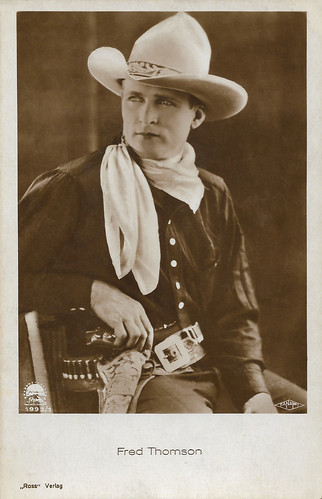
German postcard by Ross Verlag, no. 1993/1, 1927-1928. Photo: Paramount.
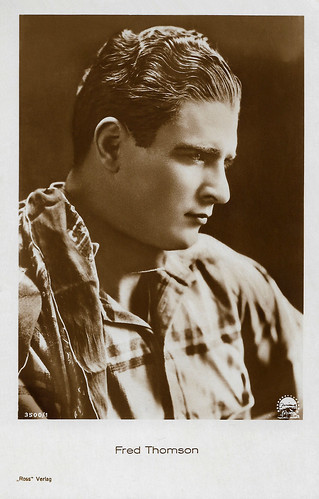
German postcard by Ross Verlag, no. 3500/1, 1928-1929. Photo: Paramount.
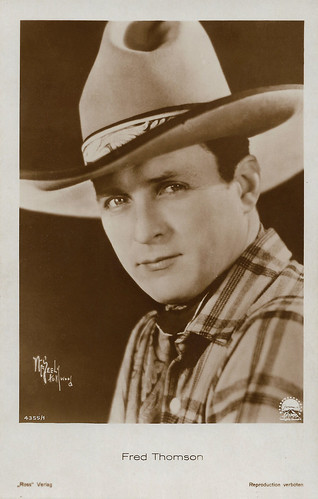
German postcard by Ross Verlag, no. 4355/1, 1929-1930. Photo: Walter F. Seely, Hollywood / Paramount.
Discovered by Mary Pickford
Frederick Clifton Thomson was born in Pasadena, California to Clara and Williell Thomson, a Presbyterian minister.
Fred attended the Princeton Theological Seminary from 1910 till 1913 and won the All-Around Champion title given out by the Amateur Athletic Union in 1910, 1911, and 1913.
Initially interested in the ministry, he became a pastor in both Washington, DC, and in Los Angeles, and subsequently married his college sweetheart, Gail Jepson, in 1913. Three years later, Gail died of tuberculosis. Following her tragic death in 1916, he left his fellowship and enlisted in the military.
During World War I, Thomson served as a U.S. Army chaplain in the 143rd Field Artillery Regiment, known informally as 'the Mary Pickford Regiment'. While playing football, he broke his leg. Mary Pickford visited the patients in the hospital ward with her friend, screenwriter Frances Marion. (Other sources write that Fred was assigned as technical advisor for a Mary Pickford war film, Johanna Enlists (William Desmond Taylor, 1918), and thus he met Pickford's friend Marion.) Anyway, Thomson and Marion fell in love, and in 1919, after the war was over, they married with Pickford as the maid of honour.
Initially interested in directing, Thomson ended up acting in one of Frances' films, the drama Just Around the Corner (Frances Marion, 1921). The film was a success. Next, he had a co-starring role in a Pickford film, the drama The Love Light (1921), which was also directed and written by Frances.
In 1923, Thomson starred in his own action serial for Universal, The Eagle's Talons (Duke Worne, 1923), in which he performed his own stunts. Signed by Joseph P. Kennedy's studio Film Booking Offices of America, he made his debut for FBO in The Mask of Lopez (Albert S. Rogell, 1924). Thomson became a superstar at FBO: he was the no. 2 box office star for 1926 and 1927.
His April 1925 contract paid him $10,000 a week (equivalent to approximately $145,787 in 2019 dollars) and also gave Thomson his own independent production unit at the studio. In 1927, Kennedy—sensing that Thomson had reached the peak of his popularity and seeing a financial opportunity for FBO—arranged a four-picture deal with Paramount Pictures, one of the major Hollywood studios. The deal essentially ceded Thomson to the rival studio. For guaranteeing $75,000 in the financing, Thomson would star in Paramount productions. In return, Paramount would return the $75,000 in financing plus an additional $100,000 and pay Thomson $15,000 a week, wiping Thomson's salary off of FBO's books.
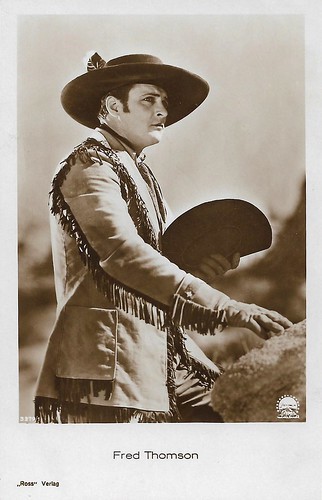
German postcard by Ross Verlag, no. 3379/1, 1928-1929. Photo: Paramount.
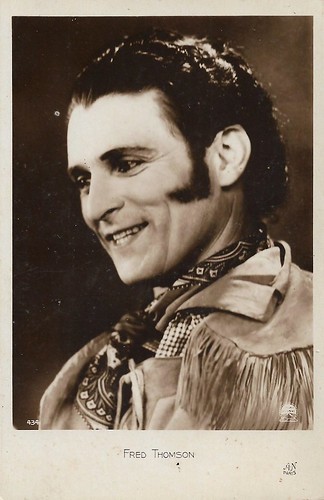
French postcard by A.N., Paris, no. 434. Photo: Paramount.
The legendary Silver King
Paramount's exhibition circuit was more prestigious than FBO's, and its cinemas, many located in larger cities, charged a premium for a ticket. In addition, Paramount boosted the price of a Fred Thomson picture to cover the backend deal with FBO and Thomson's hefty salary.
The new production arrangement meant that Thomson fans in rural theatres that were the core of FBO's audience often had to wait months for a chance to see a new Thomson picture, if it was even released to backwater cinemas, or were forced go to a larger city where the film was playing on the Paramount circuit.
Some critics found that the Thomson Westerns, which essentially were "B-pictures", were not suited for the high-end, more expensive cinemas they were being shown in. As a result, the Thomson-Paramount Westerns such as Jesse James (Lloyd Ingraham, 1927) and The Sunset Legion (Lloyd Ingraham, Alfred L. Werker, 1928) proved not to be as profitable.
In early December 1928, Thomson stepped on a nail while working in his stables. Contracting tetanus, which his doctors initially misdiagnosed, he died in Los Angeles on Christmas Day 1928. His final Western was Kit Carson (Lloyd Ingraham, Alfred L. Werker, 1928)
He was survived by his widow, screenwriter Frances Marion, and their children Richard Thomson (adopted) and Frederick C. Thomson. Because of her memories of Fred, Frances Marion could not live anymore on Enchanted Hill, their 160-acre estate in Beverly Hills with a house designed by Wallace Neff. So she sold everything, including Thomson's horse Silver King, the co-star of his films. In 1997, Paul Allen, co-founder of Microsoft, bought the estate, up till then lovingly kept, bulldozed all of it, and basically didn't do anything else with it.
Silver King was legendary. It was a white Palomino horse seventeen hands high. Al Rogell, who directed Thomson's first seven Western films, told about Silver King: "He did all of the work...everything in the early pictures — the mouth work, the jumps, the chases, the falls, quick stops — and could untie knots, lift bars, etc. He could wink one eye, nod his head yes or no, push a person with his head. Thomson trained him to do certain things and expected him to perform them."
Only three of Thomson's films have survived to the present day: Just Around the Corner is in the collection of the Library of Congress; The Love Light, starring Mary Pickford , has been released on VHS and DVD; and Thundering Hoofs has been released on VHS. In Thundering Hoofs, Thomson performs a dangerous jump from a moving stagecoach to one of the horses pulling the coach. He fell and suffered a compound fracture of his right thigh. Yakima Canutt completed the stunt. Production of the film was delayed for weeks while Thomson recovered from his injury. Canutt told the story in the episode 'Hazard of the Game' in Kevin Brownlow's fascinating TV series Hollywood (1980), produced by Thames Television.
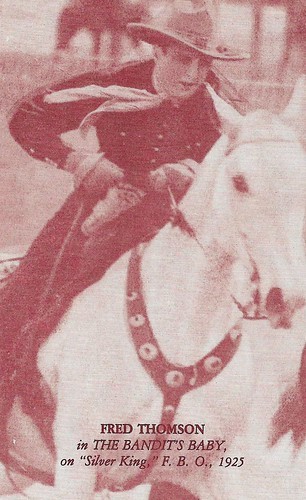
American postcard. Photo: F.B.O. Fred Thomson riding his horse Silver King in The Bandit's Baby (James P. Hogan, 1925).
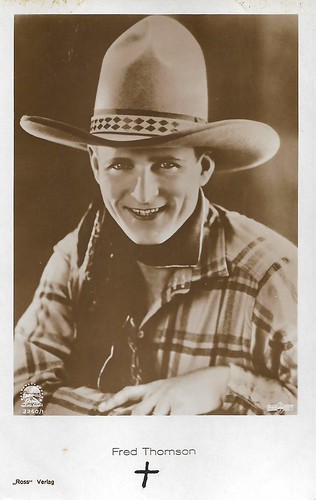
German postcard by Ross Verlag, no. 3260/1, 1928-1929. Photo: Paramount. Thomson is marked dead at the postcard.
Sources: (IMDb), Steve Vaught (Paradise Leased), Hollywood (Thames Television 1980), Wikipedia, and .

German postcard by Ross Verlag, no. 1993/1, 1927-1928. Photo: Paramount.

German postcard by Ross Verlag, no. 3500/1, 1928-1929. Photo: Paramount.

German postcard by Ross Verlag, no. 4355/1, 1929-1930. Photo: Walter F. Seely, Hollywood / Paramount.
Discovered by Mary Pickford
Frederick Clifton Thomson was born in Pasadena, California to Clara and Williell Thomson, a Presbyterian minister.
Fred attended the Princeton Theological Seminary from 1910 till 1913 and won the All-Around Champion title given out by the Amateur Athletic Union in 1910, 1911, and 1913.
Initially interested in the ministry, he became a pastor in both Washington, DC, and in Los Angeles, and subsequently married his college sweetheart, Gail Jepson, in 1913. Three years later, Gail died of tuberculosis. Following her tragic death in 1916, he left his fellowship and enlisted in the military.
During World War I, Thomson served as a U.S. Army chaplain in the 143rd Field Artillery Regiment, known informally as 'the Mary Pickford Regiment'. While playing football, he broke his leg. Mary Pickford visited the patients in the hospital ward with her friend, screenwriter Frances Marion. (Other sources write that Fred was assigned as technical advisor for a Mary Pickford war film, Johanna Enlists (William Desmond Taylor, 1918), and thus he met Pickford's friend Marion.) Anyway, Thomson and Marion fell in love, and in 1919, after the war was over, they married with Pickford as the maid of honour.
Initially interested in directing, Thomson ended up acting in one of Frances' films, the drama Just Around the Corner (Frances Marion, 1921). The film was a success. Next, he had a co-starring role in a Pickford film, the drama The Love Light (1921), which was also directed and written by Frances.
In 1923, Thomson starred in his own action serial for Universal, The Eagle's Talons (Duke Worne, 1923), in which he performed his own stunts. Signed by Joseph P. Kennedy's studio Film Booking Offices of America, he made his debut for FBO in The Mask of Lopez (Albert S. Rogell, 1924). Thomson became a superstar at FBO: he was the no. 2 box office star for 1926 and 1927.
His April 1925 contract paid him $10,000 a week (equivalent to approximately $145,787 in 2019 dollars) and also gave Thomson his own independent production unit at the studio. In 1927, Kennedy—sensing that Thomson had reached the peak of his popularity and seeing a financial opportunity for FBO—arranged a four-picture deal with Paramount Pictures, one of the major Hollywood studios. The deal essentially ceded Thomson to the rival studio. For guaranteeing $75,000 in the financing, Thomson would star in Paramount productions. In return, Paramount would return the $75,000 in financing plus an additional $100,000 and pay Thomson $15,000 a week, wiping Thomson's salary off of FBO's books.

German postcard by Ross Verlag, no. 3379/1, 1928-1929. Photo: Paramount.

French postcard by A.N., Paris, no. 434. Photo: Paramount.
The legendary Silver King
Paramount's exhibition circuit was more prestigious than FBO's, and its cinemas, many located in larger cities, charged a premium for a ticket. In addition, Paramount boosted the price of a Fred Thomson picture to cover the backend deal with FBO and Thomson's hefty salary.
The new production arrangement meant that Thomson fans in rural theatres that were the core of FBO's audience often had to wait months for a chance to see a new Thomson picture, if it was even released to backwater cinemas, or were forced go to a larger city where the film was playing on the Paramount circuit.
Some critics found that the Thomson Westerns, which essentially were "B-pictures", were not suited for the high-end, more expensive cinemas they were being shown in. As a result, the Thomson-Paramount Westerns such as Jesse James (Lloyd Ingraham, 1927) and The Sunset Legion (Lloyd Ingraham, Alfred L. Werker, 1928) proved not to be as profitable.
In early December 1928, Thomson stepped on a nail while working in his stables. Contracting tetanus, which his doctors initially misdiagnosed, he died in Los Angeles on Christmas Day 1928. His final Western was Kit Carson (Lloyd Ingraham, Alfred L. Werker, 1928)
He was survived by his widow, screenwriter Frances Marion, and their children Richard Thomson (adopted) and Frederick C. Thomson. Because of her memories of Fred, Frances Marion could not live anymore on Enchanted Hill, their 160-acre estate in Beverly Hills with a house designed by Wallace Neff. So she sold everything, including Thomson's horse Silver King, the co-star of his films. In 1997, Paul Allen, co-founder of Microsoft, bought the estate, up till then lovingly kept, bulldozed all of it, and basically didn't do anything else with it.
Silver King was legendary. It was a white Palomino horse seventeen hands high. Al Rogell, who directed Thomson's first seven Western films, told about Silver King: "He did all of the work...everything in the early pictures — the mouth work, the jumps, the chases, the falls, quick stops — and could untie knots, lift bars, etc. He could wink one eye, nod his head yes or no, push a person with his head. Thomson trained him to do certain things and expected him to perform them."
Only three of Thomson's films have survived to the present day: Just Around the Corner is in the collection of the Library of Congress; The Love Light, starring Mary Pickford , has been released on VHS and DVD; and Thundering Hoofs has been released on VHS. In Thundering Hoofs, Thomson performs a dangerous jump from a moving stagecoach to one of the horses pulling the coach. He fell and suffered a compound fracture of his right thigh. Yakima Canutt completed the stunt. Production of the film was delayed for weeks while Thomson recovered from his injury. Canutt told the story in the episode 'Hazard of the Game' in Kevin Brownlow's fascinating TV series Hollywood (1980), produced by Thames Television.

American postcard. Photo: F.B.O. Fred Thomson riding his horse Silver King in The Bandit's Baby (James P. Hogan, 1925).

German postcard by Ross Verlag, no. 3260/1, 1928-1929. Photo: Paramount. Thomson is marked dead at the postcard.
Sources: (IMDb), Steve Vaught (Paradise Leased), Hollywood (Thames Television 1980), Wikipedia, and .
Published on July 09, 2020 22:00
July 8, 2020
Photo by Ernst Sandau
One of the Berlin studios which photographed film stars for the postcards of Ross Verlag was Atelier Sandau. Between 1919 and 1939, Ernst Sandau portrayed many actors in his studio at Unter den Linden, but he also made fashion photos for such women magazines as >die neue linie<. During the Third Reich, he changed his subject to Ritterkreuzträger (Knight Cross Holders). For this post, we selected 20 Ross Verlag postcards for which Sandau made the photographs between 1919 and 1940.
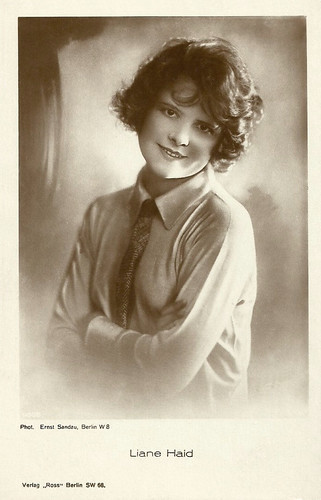
German postcard by Ross Verlag, Berlin, no. 480/1, 1919-1924. Photo: Ernst Sandau, Berlin.
Prima ballerina, dancer, singer, and actress Liane Haid (1895-2000) was the first film star of Austria. She was the epitome of the Süßes Wiener Mädel (Sweet Viennese Girl), and from the mid-1910s on she made close to a hundred films.
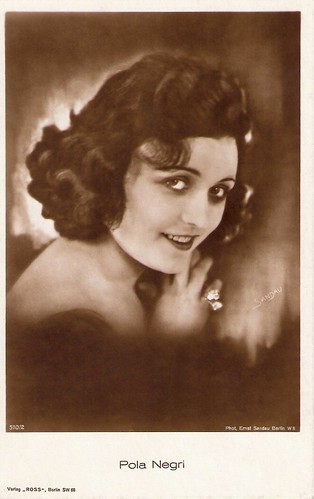
German postcard by Ross Verlag, no. 510/2, 1919-1924. Photo: Ernst Sandau, Berlin.
A postcard from Pola Negri 's (1897-1987) German years before she moved to Hollywood. In the late 1910s and the 1920s, she achieved notoriety as a femme fatale in silent films in Poland, Berlin, and Hollywood. Negri was an overnight sensation in Ernst Lubitsch's Madame du Barry/Passion (1919). Her vamp roles were so popular that she was a direct rival of Theda Bara, and lived in a Hollywood palace, modelled after the White House.
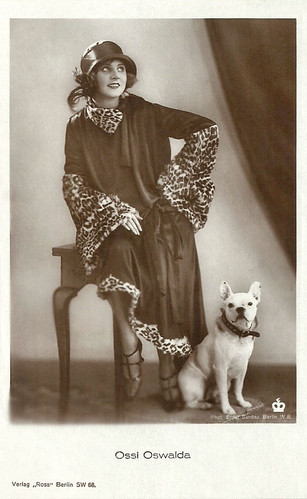
German postcard by Ross Verlag, Berlin. Photo: Ernst Sandau, Berlin.
Ossi Oswalda (1895-1947) was one of the most popular comediennes of the German silent cinema. Her popularity at the time earned her the nickname 'The German Mary Pickford'.
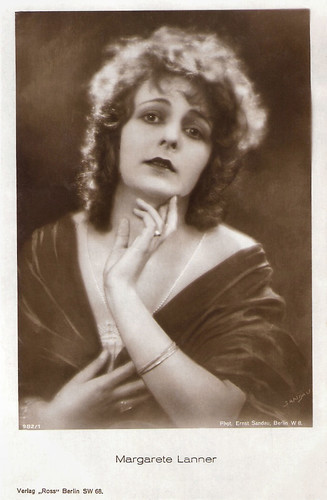
German postcard by Ross Verlag, no. 982/1, 1925-1926. Photo: Ernst Sandau, Berlin.
Margarete Lanner (1896–1981) was a German stage and film actress. She appeared in around 30 films during the silent era in a mixture of leading and supporting roles. She had a small part in Fritz Lang's classic Metropolis (1927).
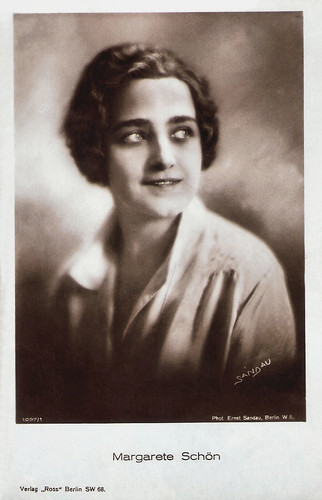
German postcard by Ross Verlag, no. 1097/1, 1927-1928. Photo: Ernst Sandau, Berlin.
Margarete Schön (1895-1985) is best known for her role as Kriemhild, the beautiful but revengeful princess of Burgundy in Fritz Lang’s silent epic Die Nibelungen (1924). The career of this German stage and film actress spanned nearly fifty years.
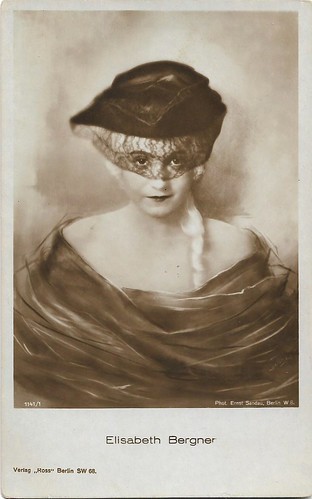
German postcard by Ross Verlag, no. 1141/1, 1927-1928. Photo: Ernst Sandau, Berlin.
The profoundly sensitive acting of Austrian-British actress Elisabeth Bergner (1897-1986) influenced the German cinema of the 1920s and 1930s. She specialised in a bisexual type that she portrayed in Der Geiger von Florenz and in other film and stage roles. Nazism forced her to go in exile, but she worked successfully in the West End and on Broadway.
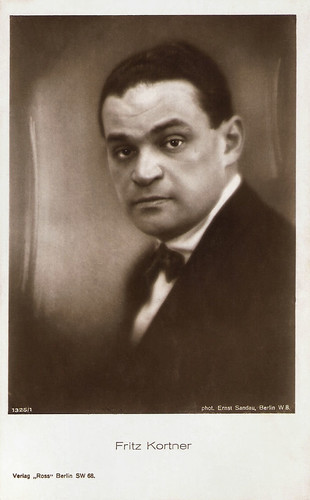
German postcard by Ross Verlag, no. 1325/1, 1927-1928. Photo: Ernst Sandau, Berlin.
Austrian-born stage and film actor and theatre director Fritz Kortner (1892-1970) was one of the best-known character actors of the German silent cinema. His specialty was playing sinister and threatening roles.
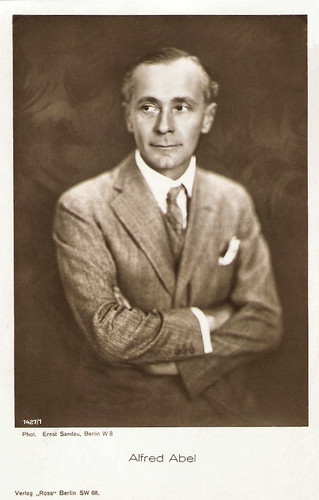
German postcard by Ross Verlag, Berlin, no. 1427/1, 1927-1928. Photo: Ernst Sandau.
Alfred Abel (1879-1937) played in over 140 silent and sound films between 1913 and 1938. He is best known as the industrial Fredersen in Fritz Lang's Metropolis (1927).
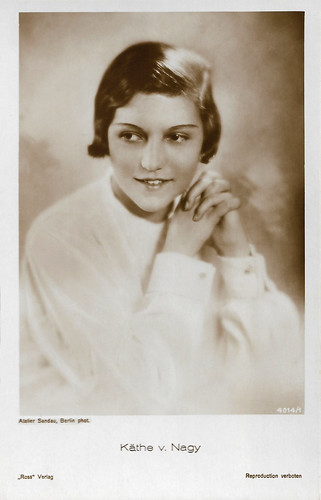
German postcard by Ross Verlag, no. 4014/1, 1929-1930. Photo: Atelier Sandau, Berlin.
Hungarian actress Käthe von Nagy (1904-1973) started as the ‘Backfish’ of German films of the late 1920s. In the early 1930s, she became a fashionable and charming star of the German and French cinema.
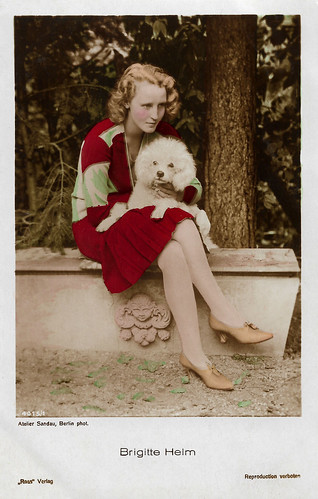
German postcard by Ross Verlag, no. 4015/1, 1929-1930. Photo: Atelier Sandau, Berlin. Collection: Geoffrey Donaldson Institute.
German actress Brigitte Helm (1908-1996) is still famous for her dual role as Maria and her double the evil Maria, the Maschinenmensch, in the silent SF classic Metropolis (Fritz Lang, 1927). After Metropolis she made a string of over 30 films in which she almost always had the starring role. She easily made the transition to sound films, before she abruptly retired in 1935.
Father and Son
Ernst Sandau was the son of another photographer named Ernst Sandau. His father was born in 1880 in Linköping in Sweden and his original name was allegedly Ernst Sigfrid Pettersson, which he changed around 1895. Sandau senior was a royal Swedish court photographer and a civil engineer.
Ernst Senior came to Berlin around 1905 and established himself there as a portrait photographer. From about 1910, he ran his studio in the house Unter den Linden 19, where Erich Sellin had worked before him. Later the Atelier Sandau was in Unter den Linden 41, in which photographer Tita Binz later also worked.
After his death in 1918, Ernst Sandau's photo studio in Berlin was taken over by photographer Suse Byk.
Ernst Junior had also become a photographer. He focused on fashion and worked for such women magazines as >die neue linie<. Like Tita Binz , Ernst Jr. also got work orders from Ross Verlag.
He started there around 1919. The last Ross Verlag postcards with his pictures date from ca. 1940. In this period, he also portrayed Ritterkreuzträger (Knight Cross Holders). Little is known further about Ernst Sandau's life.
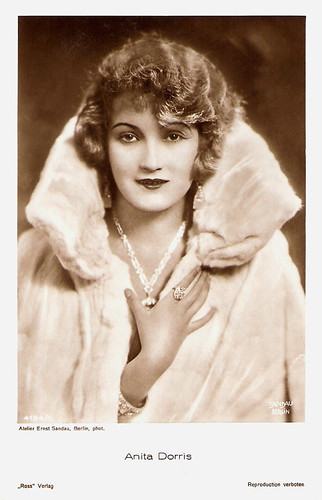
German postcard by Ross Verlag, no. 4194/1, 1929-1930. Photo: Atelier Ernst Sandau, Berlin.
Beautiful German leading lady Anita Dorris (1903-1993) started as a stage actress in 1921, after which some 15 silent films followed. Dorris was beloved in the late 1920s and smoothly made the passage to sound. In 1930, however, she married Austrian film director E. W. Emo and withdrew from the cinema. Her daughter, Maria Emo, would also become a well-known stage and film actress.
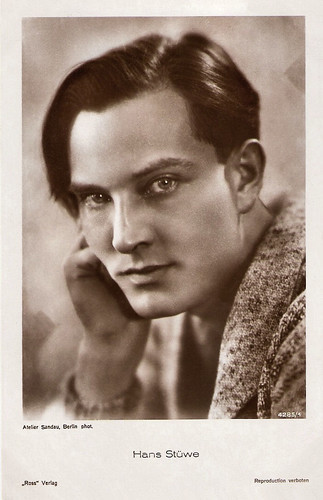
German postcard by Ross Verlag, no. 4285/1. 1929-1930. Photo: Atelier Sandau, Berlin.
Hans Stüwe (1901-1976) was a German singer and opera director. From 1926 on he was also a big film star in Germany. Four times he was the film partner of Ufa diva Zarah Leander.
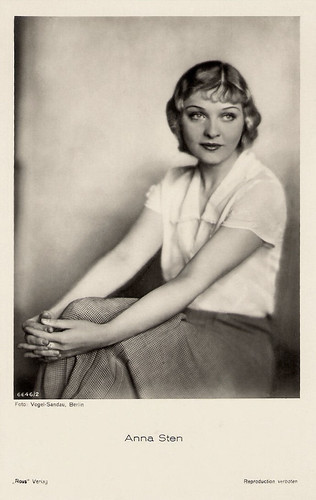
German postcard by Ross Verlag, no. 6646/2, 1931-1932. Photo: Vogel-Sandau, Berlin.
Strikingly beautiful Anna Sten (1908-1993) was a Ukrainian-born actress, who became the most famous, or rather, the most notorious of the many ‘new Greta Garbos’ of the 1930s.
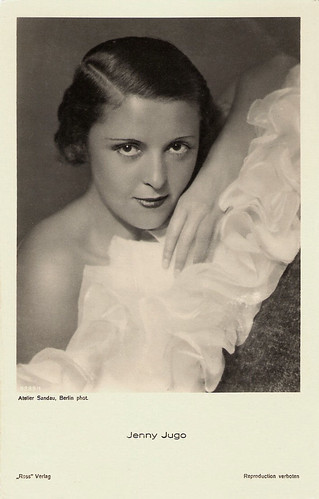
German postcard by Ross Verlag, no. 9289/1, 1935-1936. Photo: Atelier Sandau, Berlin.
Pretty Austrian actress Jenny Jugo (1904-2001) starred between 1931 and 1942 in eleven smart and charming comedies directed by Erich Engel.
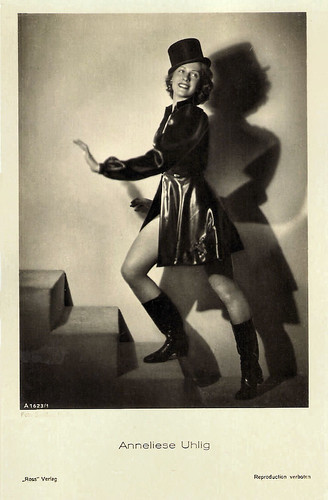
German postcard by Ross Verlag, no. A 1623/1, 1937-1938. Photo: Sandau.
Classic beauty Anneliese Uhlig (1918) was an elegant and enchanting femme fatale of Ufa crime films of the 1940s, who unwillingly bewitched Joseph Goebbels. After the war, the German actress worked also internationally as a journalist, theatre producer, and university teacher and became an American citizen.
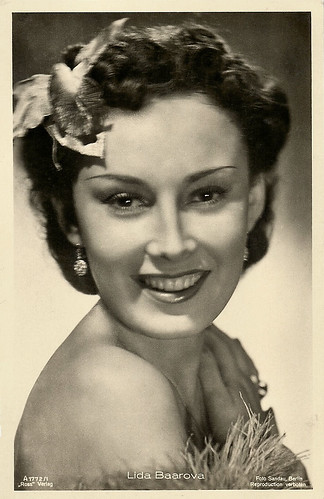
German postcard by Ross Verlag, no. A 1772/1, 1937-1938. Photo: Sandau, Berlin. Collection: Didier Hanson.
Beautiful Lída Baarová (1914–2000) was a glamorous Czech film star who worked in Prague, Berlin, and Rome. A dangerous affair with Joseph Goebbels, the propaganda minister of the Third Reich, first enhanced and later seriously damaged her career.
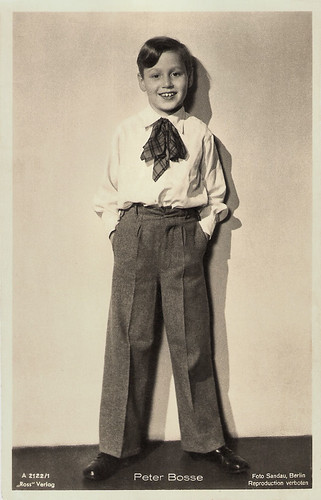
German postcard by Ross Verlag, no. A 2122/1, 1939-1940. Photo: Sandau, Berlin.
Actor, presenter, and journalist Peter Bosse (1931-2018) was a popular child star of the German cinema in the 1930s. The boy with his cheeky face made 28 films.
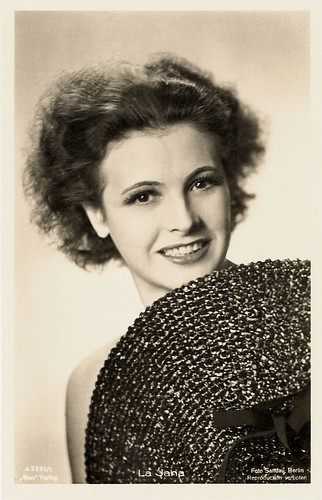
German postcard by Ross Verlag, no. A 2231/1, 1939-1940. Photo: Sandau, Berlin.
Sexy German dancer and film actress La Jana (1905-1940) was the most popular showgirl of Berlin in the 1930s. She appeared in 25 European films, often dancing in exotic costumes. In 1940, she suddenly died of pneumonia and pleurisy.
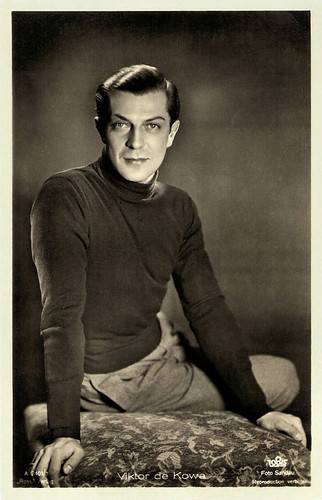
German postcard by Ross Verlag, no. A 2401/1, 1939-1940. Photo: Tobis / Sandau.
Viktor de Kowa (1904-1973) was a German actor, singer, director, and comedy writer. In the 1930s he became one of the most prominent and beloved comedy actors of the German cinema.
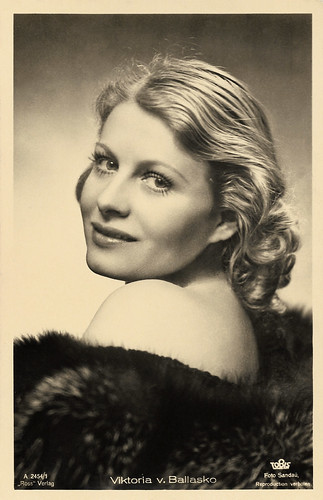
German postcard by Ross Verlag, no. A 2454/1, 1939-1940. Photo: Sandau / Tobis.
Austrian actress Viktoria von Ballasko (1909-1976) was a leading lady of the German cinema of the 1930s and 1940s. She also worked as a writer.
Sources: Johannes Christoph Moderegger (Modefotografie in Deutschland 1929-1955 - German), Wikipedia (German), and Pantorijn.

German postcard by Ross Verlag, Berlin, no. 480/1, 1919-1924. Photo: Ernst Sandau, Berlin.
Prima ballerina, dancer, singer, and actress Liane Haid (1895-2000) was the first film star of Austria. She was the epitome of the Süßes Wiener Mädel (Sweet Viennese Girl), and from the mid-1910s on she made close to a hundred films.

German postcard by Ross Verlag, no. 510/2, 1919-1924. Photo: Ernst Sandau, Berlin.
A postcard from Pola Negri 's (1897-1987) German years before she moved to Hollywood. In the late 1910s and the 1920s, she achieved notoriety as a femme fatale in silent films in Poland, Berlin, and Hollywood. Negri was an overnight sensation in Ernst Lubitsch's Madame du Barry/Passion (1919). Her vamp roles were so popular that she was a direct rival of Theda Bara, and lived in a Hollywood palace, modelled after the White House.

German postcard by Ross Verlag, Berlin. Photo: Ernst Sandau, Berlin.
Ossi Oswalda (1895-1947) was one of the most popular comediennes of the German silent cinema. Her popularity at the time earned her the nickname 'The German Mary Pickford'.

German postcard by Ross Verlag, no. 982/1, 1925-1926. Photo: Ernst Sandau, Berlin.
Margarete Lanner (1896–1981) was a German stage and film actress. She appeared in around 30 films during the silent era in a mixture of leading and supporting roles. She had a small part in Fritz Lang's classic Metropolis (1927).

German postcard by Ross Verlag, no. 1097/1, 1927-1928. Photo: Ernst Sandau, Berlin.
Margarete Schön (1895-1985) is best known for her role as Kriemhild, the beautiful but revengeful princess of Burgundy in Fritz Lang’s silent epic Die Nibelungen (1924). The career of this German stage and film actress spanned nearly fifty years.

German postcard by Ross Verlag, no. 1141/1, 1927-1928. Photo: Ernst Sandau, Berlin.
The profoundly sensitive acting of Austrian-British actress Elisabeth Bergner (1897-1986) influenced the German cinema of the 1920s and 1930s. She specialised in a bisexual type that she portrayed in Der Geiger von Florenz and in other film and stage roles. Nazism forced her to go in exile, but she worked successfully in the West End and on Broadway.

German postcard by Ross Verlag, no. 1325/1, 1927-1928. Photo: Ernst Sandau, Berlin.
Austrian-born stage and film actor and theatre director Fritz Kortner (1892-1970) was one of the best-known character actors of the German silent cinema. His specialty was playing sinister and threatening roles.

German postcard by Ross Verlag, Berlin, no. 1427/1, 1927-1928. Photo: Ernst Sandau.
Alfred Abel (1879-1937) played in over 140 silent and sound films between 1913 and 1938. He is best known as the industrial Fredersen in Fritz Lang's Metropolis (1927).

German postcard by Ross Verlag, no. 4014/1, 1929-1930. Photo: Atelier Sandau, Berlin.
Hungarian actress Käthe von Nagy (1904-1973) started as the ‘Backfish’ of German films of the late 1920s. In the early 1930s, she became a fashionable and charming star of the German and French cinema.

German postcard by Ross Verlag, no. 4015/1, 1929-1930. Photo: Atelier Sandau, Berlin. Collection: Geoffrey Donaldson Institute.
German actress Brigitte Helm (1908-1996) is still famous for her dual role as Maria and her double the evil Maria, the Maschinenmensch, in the silent SF classic Metropolis (Fritz Lang, 1927). After Metropolis she made a string of over 30 films in which she almost always had the starring role. She easily made the transition to sound films, before she abruptly retired in 1935.
Father and Son
Ernst Sandau was the son of another photographer named Ernst Sandau. His father was born in 1880 in Linköping in Sweden and his original name was allegedly Ernst Sigfrid Pettersson, which he changed around 1895. Sandau senior was a royal Swedish court photographer and a civil engineer.
Ernst Senior came to Berlin around 1905 and established himself there as a portrait photographer. From about 1910, he ran his studio in the house Unter den Linden 19, where Erich Sellin had worked before him. Later the Atelier Sandau was in Unter den Linden 41, in which photographer Tita Binz later also worked.
After his death in 1918, Ernst Sandau's photo studio in Berlin was taken over by photographer Suse Byk.
Ernst Junior had also become a photographer. He focused on fashion and worked for such women magazines as >die neue linie<. Like Tita Binz , Ernst Jr. also got work orders from Ross Verlag.
He started there around 1919. The last Ross Verlag postcards with his pictures date from ca. 1940. In this period, he also portrayed Ritterkreuzträger (Knight Cross Holders). Little is known further about Ernst Sandau's life.

German postcard by Ross Verlag, no. 4194/1, 1929-1930. Photo: Atelier Ernst Sandau, Berlin.
Beautiful German leading lady Anita Dorris (1903-1993) started as a stage actress in 1921, after which some 15 silent films followed. Dorris was beloved in the late 1920s and smoothly made the passage to sound. In 1930, however, she married Austrian film director E. W. Emo and withdrew from the cinema. Her daughter, Maria Emo, would also become a well-known stage and film actress.

German postcard by Ross Verlag, no. 4285/1. 1929-1930. Photo: Atelier Sandau, Berlin.
Hans Stüwe (1901-1976) was a German singer and opera director. From 1926 on he was also a big film star in Germany. Four times he was the film partner of Ufa diva Zarah Leander.

German postcard by Ross Verlag, no. 6646/2, 1931-1932. Photo: Vogel-Sandau, Berlin.
Strikingly beautiful Anna Sten (1908-1993) was a Ukrainian-born actress, who became the most famous, or rather, the most notorious of the many ‘new Greta Garbos’ of the 1930s.

German postcard by Ross Verlag, no. 9289/1, 1935-1936. Photo: Atelier Sandau, Berlin.
Pretty Austrian actress Jenny Jugo (1904-2001) starred between 1931 and 1942 in eleven smart and charming comedies directed by Erich Engel.

German postcard by Ross Verlag, no. A 1623/1, 1937-1938. Photo: Sandau.
Classic beauty Anneliese Uhlig (1918) was an elegant and enchanting femme fatale of Ufa crime films of the 1940s, who unwillingly bewitched Joseph Goebbels. After the war, the German actress worked also internationally as a journalist, theatre producer, and university teacher and became an American citizen.

German postcard by Ross Verlag, no. A 1772/1, 1937-1938. Photo: Sandau, Berlin. Collection: Didier Hanson.
Beautiful Lída Baarová (1914–2000) was a glamorous Czech film star who worked in Prague, Berlin, and Rome. A dangerous affair with Joseph Goebbels, the propaganda minister of the Third Reich, first enhanced and later seriously damaged her career.

German postcard by Ross Verlag, no. A 2122/1, 1939-1940. Photo: Sandau, Berlin.
Actor, presenter, and journalist Peter Bosse (1931-2018) was a popular child star of the German cinema in the 1930s. The boy with his cheeky face made 28 films.

German postcard by Ross Verlag, no. A 2231/1, 1939-1940. Photo: Sandau, Berlin.
Sexy German dancer and film actress La Jana (1905-1940) was the most popular showgirl of Berlin in the 1930s. She appeared in 25 European films, often dancing in exotic costumes. In 1940, she suddenly died of pneumonia and pleurisy.

German postcard by Ross Verlag, no. A 2401/1, 1939-1940. Photo: Tobis / Sandau.
Viktor de Kowa (1904-1973) was a German actor, singer, director, and comedy writer. In the 1930s he became one of the most prominent and beloved comedy actors of the German cinema.

German postcard by Ross Verlag, no. A 2454/1, 1939-1940. Photo: Sandau / Tobis.
Austrian actress Viktoria von Ballasko (1909-1976) was a leading lady of the German cinema of the 1930s and 1940s. She also worked as a writer.
Sources: Johannes Christoph Moderegger (Modefotografie in Deutschland 1929-1955 - German), Wikipedia (German), and Pantorijn.
Published on July 08, 2020 22:00
July 7, 2020
La Jana
Sexy German dancer and film actress La Jana (1905-1940) is a mysterious legend of the German cinema. In the 1940s, she was the most popular showgirl of Berlin and she appeared in 25 European films, often dancing in exotic costumes. In 1940, Goebbels sent her on tour for the Wehrmacht and while dancing half-naked in the cold, La Jana got ill and died of pneumonia and pleurisy.
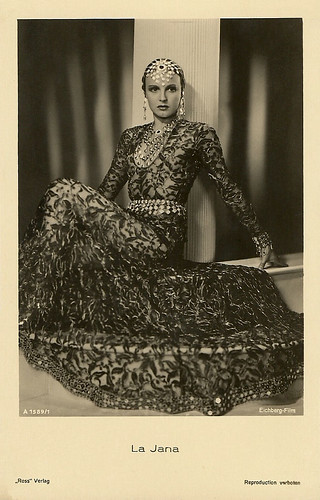
German postcard by Ross Verlag, no. A 1589/1, 1938-1939. Photo: Eichberg-Film. Collection: Didier Hanson.
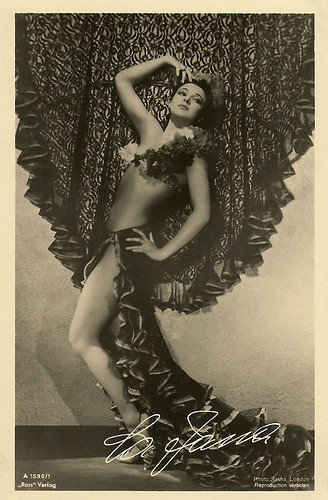
German postcard by Ross Verlag, no. A 1590/1, 1937-1938. Photo: Sasha, London. Collection: Didier Hanson.
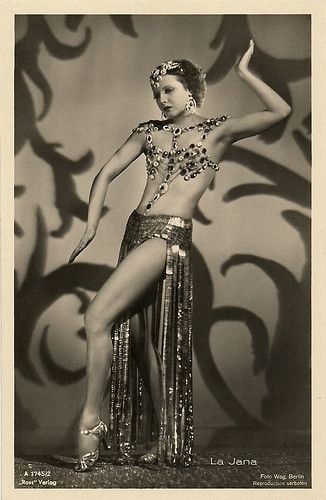
German postcard by Ross Verlag, no. A 1745/2, 1937-1938. Photo: Wog, Berlin. Collection: Didier Hanson.
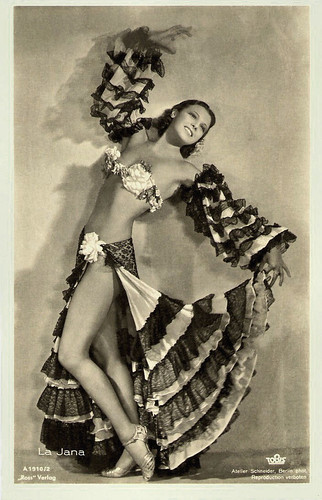
German postcard by Ross Verlag, no. A 1910/2, 1937-1938. Photo: Atelier Schneider, Berlin / Tobis.
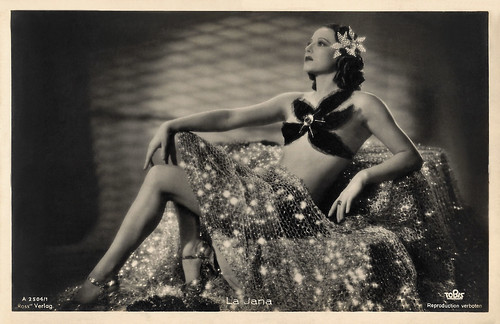
German postcard by Ross Verlag, no. A 2504/1, 1939-1940. Photo: Tobis. La Jana in Stern von Rio/Star of Rio (Karl Anton, 1940).
The most beautiful body I had seen in my life
La Jana was born as Henriette Margarethe Hiebel in Mauer near Wien (Vienna), Austria-Hungary, in 1905. ‘Henny’ was the second and youngest daughter of Heinrich and Anna Hiebel. Her older sister, Anny, was later trained as an opera singer. Her father was a gild master and the family moved to Frankfurt when Henny was only two years.
At the age of eight, she already appeared in the children's ballet of the Frankfurt Opera. Henny completed a dance training at the Opera Ballet in Frankfurt and became a dancer in cabarets and revues. In 1921, she performed her own improvisations in Trude Hesterberg’s cabaret Die wilde Bühne (The Wild Stage).
In Paris, she met Géza von Cziffra, who, according to his autobiography, brought her to Berlin, director Friedrich Zelnik and the cinema. He writes "... And there I saw her dance for the first time: this woman had the most beautiful body I had seen in my life. The girl, that moved here up and down in the stage lights (...) was boyishly built: slim hips, almost only a hint of breasts. She was a simple, friendly, approachable girl but she had as much interest for sex as Immanuel Kant."
There are at least three different versions of the discovery of La Jana. According to contemporary sources, La Jana was discovered in Cabaret Weinklause in Frankfurt by a nightclub owner from Paris and later returned as a dancer to Berlin. Another report says that La Jana was hired overnight as a substitute for Claire Bauroff, the ill star of a Revue in Dresden and that she later also received offers from Berlin.
However, in 1925 she made her first film appearance in Wege zu Kraft und Schönheit - Ein Film über moderne Körperkultur/Ways to Strength and Beauty (Nicholas Kaufmann, Wilhelm Prager, 1925). This film about the ‘modern body culture' was very much an artifact of the Naturist fad that swept Germany at the time.
Friedrich Zelnik engaged her for his production company the Deutsche Film Union (Defu), and employed her in silent films like Der Biberpelz/The Beaver Fur (Erich Schönfelder, 1928).
She also appeared in international silent films such as the Danish-German production Die weisse Geisha/The White Geisha (Valdemar Andersen, Karl Heiland, 1926), the Swedish production En perfekt gentleman/A Perfect Gentleman (Vilhelm Bryde, Gösta Ekman, 1927) in which she costarred with Gösta Ekman and Hans Albers , and the French-German-Belgian production Thérèse Raquin/Shadows of Fear (Jacques Feyder, 1928) based on the novel by Émile Zola.
La Jana became engaged in 1926 to actor Ulrich Bettac. In that year, she still used her civil name, Henny Hiebel and she moved to Berlin with her fiancé. A few years later, this relationship was resolved.
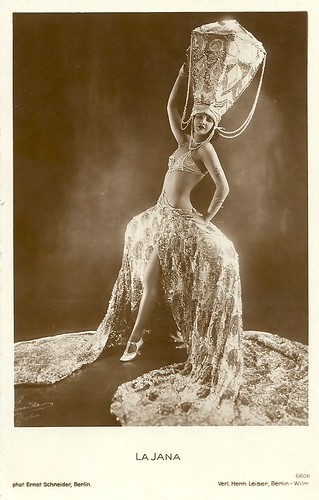
German postcard by Verlag Hermann Leiser, Berlin-Wilm., no. 6606. Photo: Ernst Schneider, Berlin. Collection: Didier Hanson.
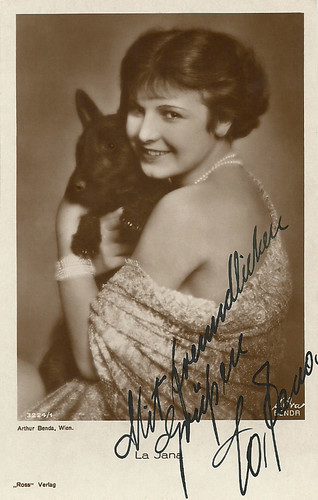
German postcard by Ross Verlag, no. 3224/1, 1928-1929. Photo: Arthur Benda, Wien. Collection: Didier Hanson.
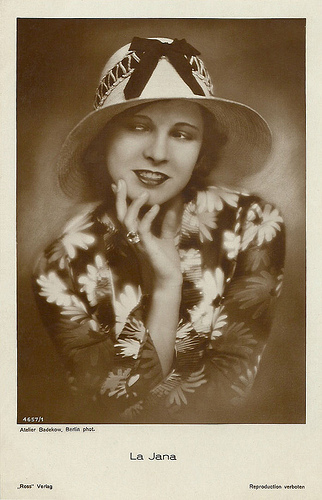
German postcard by Ross Verlag, no. 4657/1, 1929-1930. Photo: Atelier Badekow, Berlin. Collection: Didier Hanson.
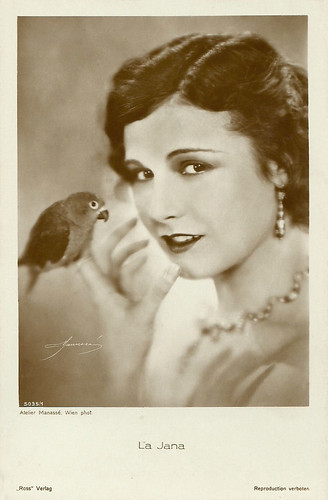
German postcard by Ross Verlag, no. 5035/1, 1930-1931. Photo: Atelier Manassé, Wien. Collection: Didier Hanson.
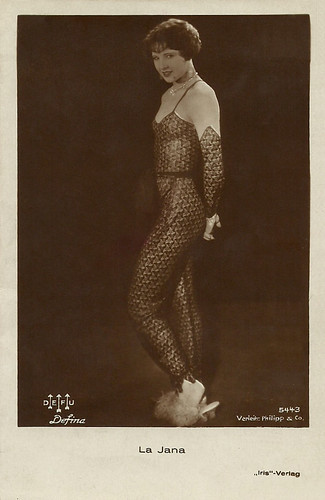
Austrian postcard by Iris-Verlag, no. 5443, 1938-1939. Photo: DEFU / Defina / Verleih Philipp & Co. Collection: Didier Hanson.
Served Half Naked, On A Silver Platter
La Jana danced in revues in Berlin, Stockholm (1933) and London (1934-1935) and she participated in the shows 'An und Aus' (To and From) by Herman Haller, 'Casanova' by Erik Charell and 'Die schöne Helena' (The beautiful Helen) by Max Reinhardt.
In the revue 'Casanova', La Jana was served half-naked, on a silver platter to the audience. The reaction of the public was accordingly: La Jana was the talk of Berlin.
In his autobiography, director Géza von Cziffra claims that La Jana had an affair with Kronprinz Wilhelm (Crown Prince William) but he dismisses rumors about an affair between La Jana and Joseph Goebbels.
The show 'Streamline' by Charles B. Cochran led La Jana in 1934 on a tour throughout England and Scotland. Upon her return to Germany in 1936, she made almost every year one or more films.
The sound film had underlined her dancing in an optimal way with the audible music and she had had success with her appearance in Der Schlemihl/The Unlucky Devil (Max Nosseck, 1931) as a dancer opposite Curt Bois.
The circus drama Truxa (Hans H. Zerlett, 1937) made La Jana in one stroke acquainted all over Germany. At IMDb , Jan Onderwater writes about her performance: "La Jana, here in her first major part, cannot dance but she is not that bad an actress as she is reputed to have been; with her half-naked body she is exotic and lovely to look at."
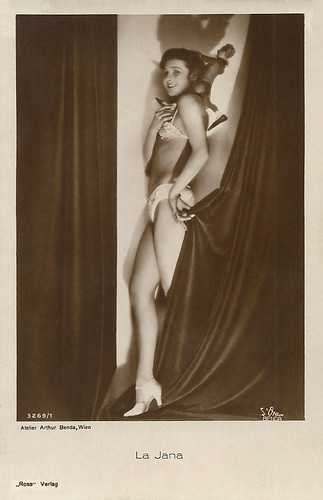
German postcard by Ross Verlag, no. 3269/1, 1928-1929. Photo: Atelier Arthur Benda, Wien. Collection: Didier Hanson.
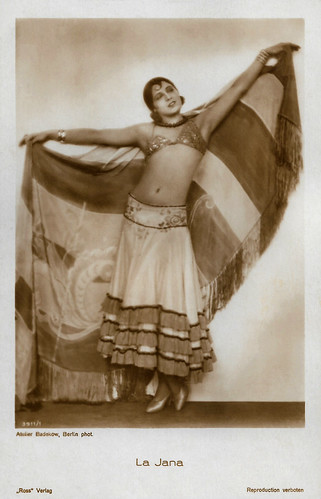
German postcard by Ross Verlag, no. 3911/1, 1928-1929. Photo: Badekow.
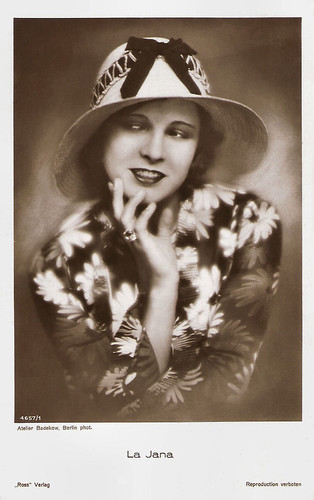
German postcard by Ross Verlag, no. 4657/1, 1929-1930. Photo: Atelier Badekow, Berlin.
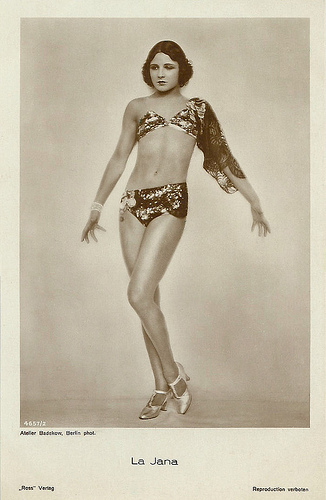
German postcard by Ross Verlag, no. 4657/2, 1929-1930. Photo: Atelier Badekow, Berlin. Collection: Didier Hanson.
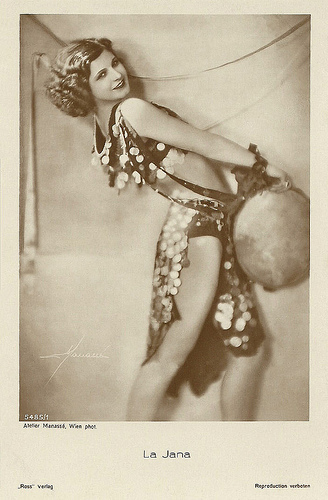
German postcard by Ross Verlag, no. 5485/1, 1930-1931. Photo: Atelier Manassé, Wien. Collection: Didier Hanson.
Contradicting the ideal vision of womanliness of the Third Reich
La Jana travelled to India for the films Der Tiger von Eschnapur/The Tiger of Eschnapur (Richard Eichberg, 1938) and Das indische Grabmal/The Indian Tomb (Richard Eichberg, 1938), co-starring with Frits van Dongen (aka Philip Dorn ) and Theo Lingen .
Millions of people admired the exotic magic of the film and La Jana. Filmportal.de analyzes: “although typifying the embodiment of the ‘non-Aryan’ woman, which clearly contradicted the ideal vision of womanliness of the Third Reich, she became for this same very reason the ideal projection of all the various desires of the public.”
Her next films films were the musical Es leuchten die Sterne/The Stars Shine (Hans H. Zerlett, 1938) and the crime film Menschen vom Variete/People from the Music Hall (Josef von Báky, 1939) with Hans Holt .
After she earlier had refused to go, Goebbels forced her on a tour for the Wehrmacht in 1939/1940. Her fame made her a sure crowd-puller. It was a cold winter and she wore little clothes on the stage. She became ill with pneumonia on both lungs in February 1940.
On 13 March 1940, La Jana died of pneumonia and pleurisy in a hospital in Berlin. She was only 35 and became a mysterious legend. She was dearly missed at the glamorous world premiere of her last film, Stern von Rio/Star of Rio (Karl Anton, 1940), at the Ufa Palast am Zoo in Berlin.
In 1954, fourteen years after her death, a person appeared who claimed to be La Jana's son. After Anny Bittlinski, La Jana's sister denied his story he was charged with forgery and fraud. There was also a rumour that La Jana helped Jews escape from Germany. The SS would have killed her for this and the pneumonia story would have been invented to conceal the murder.
Another rumour is about her name. ‘La Jana’ is supposed to originate from the Indian language, and to mean ‘The Flower-like’. In fact, La Jana is a purely invented name and has only superficial similarities with words from Sanskrit. How Henny Hiebel came to her artist's name is not recorded. Henny Hiebel and a partner performed for a time under the name The Charming Sisters. There are some Swedish autograph cards of her with the name Lary Jana. The mystery of La Jana remains.
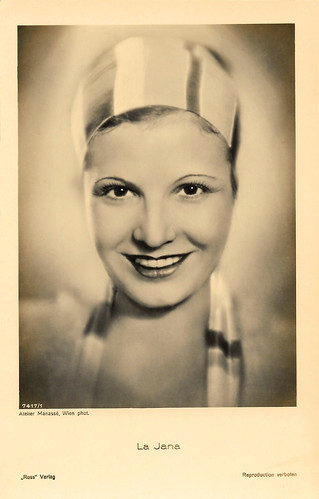
German postcard by Ross Verlag, no. 7417/1, 1932-1933. Photo: Atelier Manassé, Wien.
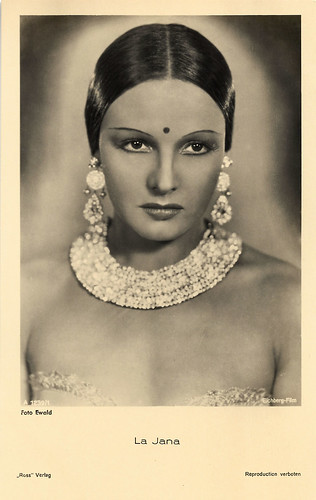
German postcard by Ross Verlag, no. A 1239/1, 1937-1938. Photo: Ewald / Eichberg-Film. La Jana in Das indische Grabmal/The Indian Tomb (Richard Eichberg, 1938).
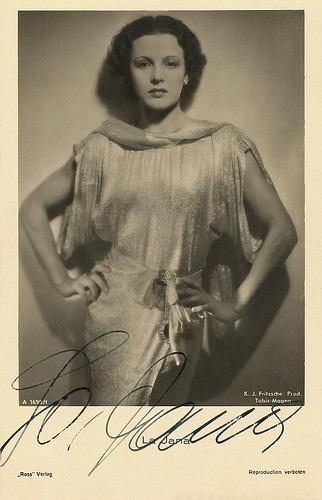
German postcard by Ross Verlag, no. A 1699/1, 1937-1938. Photo: K.J. Fritzsche Prod. / Tobis-Magna. Collection: Didier Hanson.

German postcard by Ross Verlag, no. A 2231/1, 1939-1940. Photo: Sandau, Berlin.
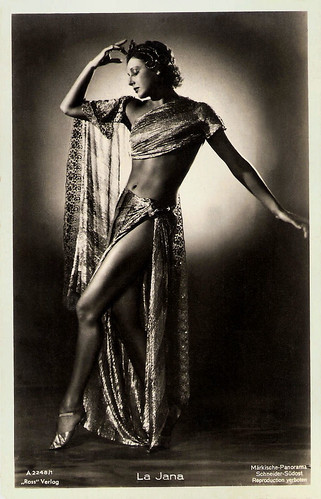
German postcard by Ross Verlag, no. A 2248/1, 1939-1940. Photo: Märkische / Panorama / Schneider, Südost. La Jana in Menschen vom Varieté/People from the variety show (Josef von Báky, 1939).
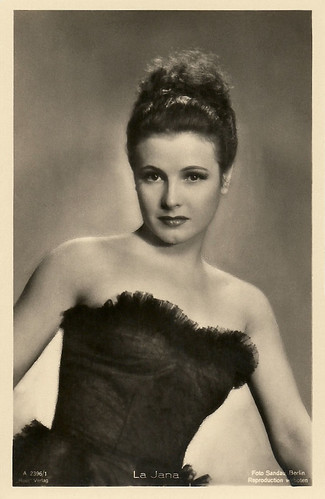
German postcard by Ross Verlag, no. A 2396/1, 1941-1944. Photo: Sandau, Berlin. Collection: Didier Hanson.
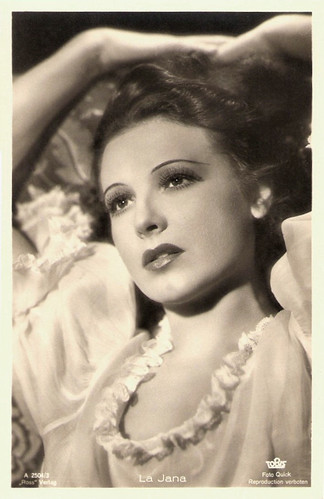
German postcard by Ross Verlag, no. A 2404/3, 1941-1944. Photo: Quick / Tobis.
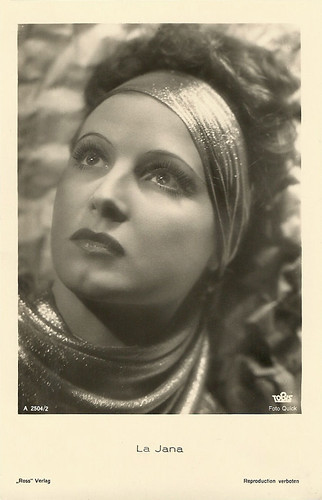
German postcard by Ross Verlag, no. A 2504/2, 1939-1940. Photo: Quick / Tobis. Collection: Didier Hanson.
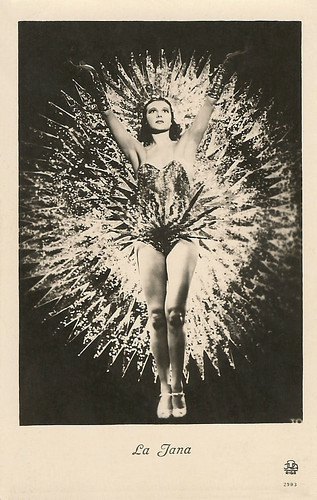
Latvian postcard by JDA, Riga, no. 2503. Photo: Tobis. Collection: Didier Hanson.
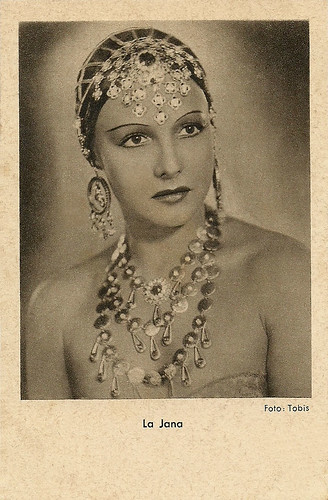
German postcard by Das Programm von Heute / Ross Verlag. Photo: Tobis. Collection: Didier Hanson.
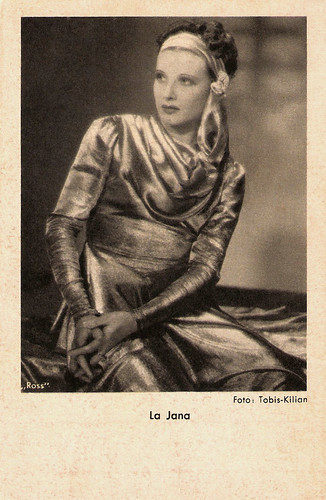
German postcard by Das Programm von Heute / Ross Verlag. Photo: Tobis / Kilian.
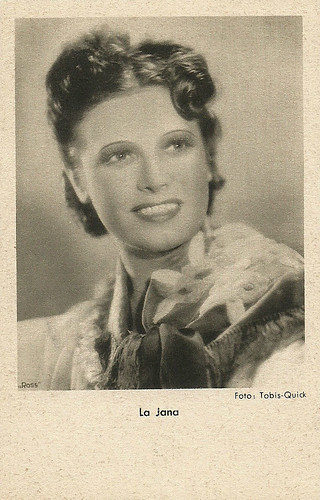
German postcard by Das Programm von Heute / Ross Verlag. Photo: Tobis / Quick. Collection: Didier Hanson.
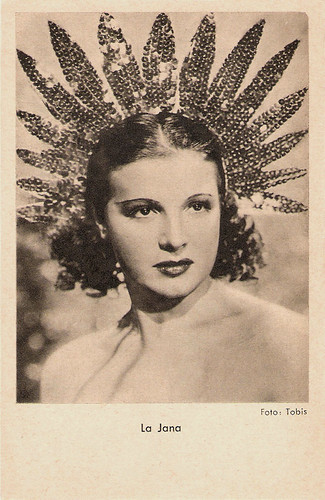
German postcard by Das Programm von Heute / Ross Verlag. Photo: Tobis.
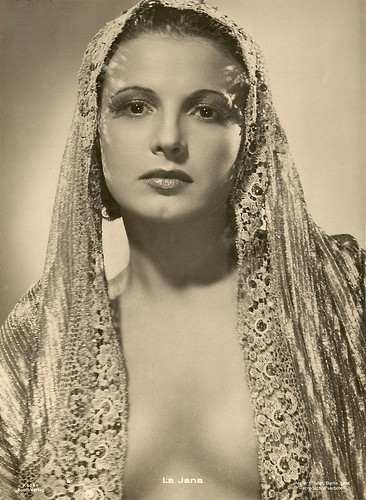
German postcard by Ross Verlag, no. K 1138. Photo: Atelier Binder, Berlin. Collection: Didier Hanson.
Sources: Thomas Staedeli (Cyranos), Jan Onderwater (IMDb), Operator 99 (Allure), Filmportal.de, Wikipedia (German), The Androom Archives, and .

German postcard by Ross Verlag, no. A 1589/1, 1938-1939. Photo: Eichberg-Film. Collection: Didier Hanson.

German postcard by Ross Verlag, no. A 1590/1, 1937-1938. Photo: Sasha, London. Collection: Didier Hanson.

German postcard by Ross Verlag, no. A 1745/2, 1937-1938. Photo: Wog, Berlin. Collection: Didier Hanson.

German postcard by Ross Verlag, no. A 1910/2, 1937-1938. Photo: Atelier Schneider, Berlin / Tobis.

German postcard by Ross Verlag, no. A 2504/1, 1939-1940. Photo: Tobis. La Jana in Stern von Rio/Star of Rio (Karl Anton, 1940).
The most beautiful body I had seen in my life
La Jana was born as Henriette Margarethe Hiebel in Mauer near Wien (Vienna), Austria-Hungary, in 1905. ‘Henny’ was the second and youngest daughter of Heinrich and Anna Hiebel. Her older sister, Anny, was later trained as an opera singer. Her father was a gild master and the family moved to Frankfurt when Henny was only two years.
At the age of eight, she already appeared in the children's ballet of the Frankfurt Opera. Henny completed a dance training at the Opera Ballet in Frankfurt and became a dancer in cabarets and revues. In 1921, she performed her own improvisations in Trude Hesterberg’s cabaret Die wilde Bühne (The Wild Stage).
In Paris, she met Géza von Cziffra, who, according to his autobiography, brought her to Berlin, director Friedrich Zelnik and the cinema. He writes "... And there I saw her dance for the first time: this woman had the most beautiful body I had seen in my life. The girl, that moved here up and down in the stage lights (...) was boyishly built: slim hips, almost only a hint of breasts. She was a simple, friendly, approachable girl but she had as much interest for sex as Immanuel Kant."
There are at least three different versions of the discovery of La Jana. According to contemporary sources, La Jana was discovered in Cabaret Weinklause in Frankfurt by a nightclub owner from Paris and later returned as a dancer to Berlin. Another report says that La Jana was hired overnight as a substitute for Claire Bauroff, the ill star of a Revue in Dresden and that she later also received offers from Berlin.
However, in 1925 she made her first film appearance in Wege zu Kraft und Schönheit - Ein Film über moderne Körperkultur/Ways to Strength and Beauty (Nicholas Kaufmann, Wilhelm Prager, 1925). This film about the ‘modern body culture' was very much an artifact of the Naturist fad that swept Germany at the time.
Friedrich Zelnik engaged her for his production company the Deutsche Film Union (Defu), and employed her in silent films like Der Biberpelz/The Beaver Fur (Erich Schönfelder, 1928).
She also appeared in international silent films such as the Danish-German production Die weisse Geisha/The White Geisha (Valdemar Andersen, Karl Heiland, 1926), the Swedish production En perfekt gentleman/A Perfect Gentleman (Vilhelm Bryde, Gösta Ekman, 1927) in which she costarred with Gösta Ekman and Hans Albers , and the French-German-Belgian production Thérèse Raquin/Shadows of Fear (Jacques Feyder, 1928) based on the novel by Émile Zola.
La Jana became engaged in 1926 to actor Ulrich Bettac. In that year, she still used her civil name, Henny Hiebel and she moved to Berlin with her fiancé. A few years later, this relationship was resolved.

German postcard by Verlag Hermann Leiser, Berlin-Wilm., no. 6606. Photo: Ernst Schneider, Berlin. Collection: Didier Hanson.

German postcard by Ross Verlag, no. 3224/1, 1928-1929. Photo: Arthur Benda, Wien. Collection: Didier Hanson.

German postcard by Ross Verlag, no. 4657/1, 1929-1930. Photo: Atelier Badekow, Berlin. Collection: Didier Hanson.

German postcard by Ross Verlag, no. 5035/1, 1930-1931. Photo: Atelier Manassé, Wien. Collection: Didier Hanson.

Austrian postcard by Iris-Verlag, no. 5443, 1938-1939. Photo: DEFU / Defina / Verleih Philipp & Co. Collection: Didier Hanson.
Served Half Naked, On A Silver Platter
La Jana danced in revues in Berlin, Stockholm (1933) and London (1934-1935) and she participated in the shows 'An und Aus' (To and From) by Herman Haller, 'Casanova' by Erik Charell and 'Die schöne Helena' (The beautiful Helen) by Max Reinhardt.
In the revue 'Casanova', La Jana was served half-naked, on a silver platter to the audience. The reaction of the public was accordingly: La Jana was the talk of Berlin.
In his autobiography, director Géza von Cziffra claims that La Jana had an affair with Kronprinz Wilhelm (Crown Prince William) but he dismisses rumors about an affair between La Jana and Joseph Goebbels.
The show 'Streamline' by Charles B. Cochran led La Jana in 1934 on a tour throughout England and Scotland. Upon her return to Germany in 1936, she made almost every year one or more films.
The sound film had underlined her dancing in an optimal way with the audible music and she had had success with her appearance in Der Schlemihl/The Unlucky Devil (Max Nosseck, 1931) as a dancer opposite Curt Bois.
The circus drama Truxa (Hans H. Zerlett, 1937) made La Jana in one stroke acquainted all over Germany. At IMDb , Jan Onderwater writes about her performance: "La Jana, here in her first major part, cannot dance but she is not that bad an actress as she is reputed to have been; with her half-naked body she is exotic and lovely to look at."

German postcard by Ross Verlag, no. 3269/1, 1928-1929. Photo: Atelier Arthur Benda, Wien. Collection: Didier Hanson.

German postcard by Ross Verlag, no. 3911/1, 1928-1929. Photo: Badekow.

German postcard by Ross Verlag, no. 4657/1, 1929-1930. Photo: Atelier Badekow, Berlin.

German postcard by Ross Verlag, no. 4657/2, 1929-1930. Photo: Atelier Badekow, Berlin. Collection: Didier Hanson.

German postcard by Ross Verlag, no. 5485/1, 1930-1931. Photo: Atelier Manassé, Wien. Collection: Didier Hanson.
Contradicting the ideal vision of womanliness of the Third Reich
La Jana travelled to India for the films Der Tiger von Eschnapur/The Tiger of Eschnapur (Richard Eichberg, 1938) and Das indische Grabmal/The Indian Tomb (Richard Eichberg, 1938), co-starring with Frits van Dongen (aka Philip Dorn ) and Theo Lingen .
Millions of people admired the exotic magic of the film and La Jana. Filmportal.de analyzes: “although typifying the embodiment of the ‘non-Aryan’ woman, which clearly contradicted the ideal vision of womanliness of the Third Reich, she became for this same very reason the ideal projection of all the various desires of the public.”
Her next films films were the musical Es leuchten die Sterne/The Stars Shine (Hans H. Zerlett, 1938) and the crime film Menschen vom Variete/People from the Music Hall (Josef von Báky, 1939) with Hans Holt .
After she earlier had refused to go, Goebbels forced her on a tour for the Wehrmacht in 1939/1940. Her fame made her a sure crowd-puller. It was a cold winter and she wore little clothes on the stage. She became ill with pneumonia on both lungs in February 1940.
On 13 March 1940, La Jana died of pneumonia and pleurisy in a hospital in Berlin. She was only 35 and became a mysterious legend. She was dearly missed at the glamorous world premiere of her last film, Stern von Rio/Star of Rio (Karl Anton, 1940), at the Ufa Palast am Zoo in Berlin.
In 1954, fourteen years after her death, a person appeared who claimed to be La Jana's son. After Anny Bittlinski, La Jana's sister denied his story he was charged with forgery and fraud. There was also a rumour that La Jana helped Jews escape from Germany. The SS would have killed her for this and the pneumonia story would have been invented to conceal the murder.
Another rumour is about her name. ‘La Jana’ is supposed to originate from the Indian language, and to mean ‘The Flower-like’. In fact, La Jana is a purely invented name and has only superficial similarities with words from Sanskrit. How Henny Hiebel came to her artist's name is not recorded. Henny Hiebel and a partner performed for a time under the name The Charming Sisters. There are some Swedish autograph cards of her with the name Lary Jana. The mystery of La Jana remains.

German postcard by Ross Verlag, no. 7417/1, 1932-1933. Photo: Atelier Manassé, Wien.

German postcard by Ross Verlag, no. A 1239/1, 1937-1938. Photo: Ewald / Eichberg-Film. La Jana in Das indische Grabmal/The Indian Tomb (Richard Eichberg, 1938).

German postcard by Ross Verlag, no. A 1699/1, 1937-1938. Photo: K.J. Fritzsche Prod. / Tobis-Magna. Collection: Didier Hanson.

German postcard by Ross Verlag, no. A 2231/1, 1939-1940. Photo: Sandau, Berlin.

German postcard by Ross Verlag, no. A 2248/1, 1939-1940. Photo: Märkische / Panorama / Schneider, Südost. La Jana in Menschen vom Varieté/People from the variety show (Josef von Báky, 1939).

German postcard by Ross Verlag, no. A 2396/1, 1941-1944. Photo: Sandau, Berlin. Collection: Didier Hanson.

German postcard by Ross Verlag, no. A 2404/3, 1941-1944. Photo: Quick / Tobis.

German postcard by Ross Verlag, no. A 2504/2, 1939-1940. Photo: Quick / Tobis. Collection: Didier Hanson.

Latvian postcard by JDA, Riga, no. 2503. Photo: Tobis. Collection: Didier Hanson.

German postcard by Das Programm von Heute / Ross Verlag. Photo: Tobis. Collection: Didier Hanson.

German postcard by Das Programm von Heute / Ross Verlag. Photo: Tobis / Kilian.

German postcard by Das Programm von Heute / Ross Verlag. Photo: Tobis / Quick. Collection: Didier Hanson.

German postcard by Das Programm von Heute / Ross Verlag. Photo: Tobis.

German postcard by Ross Verlag, no. K 1138. Photo: Atelier Binder, Berlin. Collection: Didier Hanson.
Sources: Thomas Staedeli (Cyranos), Jan Onderwater (IMDb), Operator 99 (Allure), Filmportal.de, Wikipedia (German), The Androom Archives, and .
Published on July 07, 2020 22:00
July 6, 2020
Les Trois Mousquetaires (1921), Part deux
The Pathé serial Les Trois Mousquetaires/The Three Musketeers (Henri Diamant Berger, 1921), is one of the great French films of the silent era. The second film adaptation of the famous adventure novel by Alexandre Dumas père had a mega-budget of 2,5 million French francs, and it showed also in the publicity materials. Last week we had a post on 21 postcards with film scenes, produced in 1921 by M. Le Deley, Paris for Pathé. Today a post on two postcard series with character portraits. The first was part of the Les Vedettes de l'Écran series by Editions Filma. The other, larger series of sepia postcards was published by Editions Cinémagazine.
Les Vedettes de l'Écran
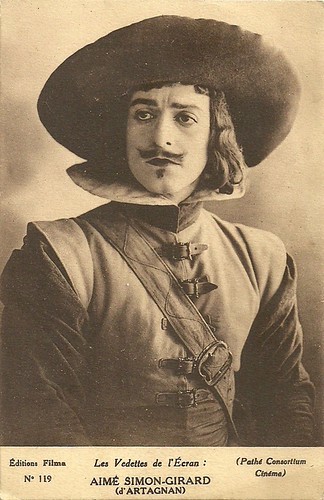
French postcard in the Les Vedettes de l'Écran series by Editions Filma, no. 119. Photo: Pathé Consortium Cinéma. Aimé Simon-Girard as D'Artagnan in Les trois mousquetaires/The Three Musketeers (Henri Diamant-Berger, 1921).
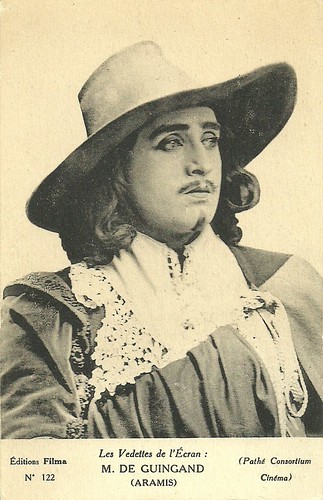
French postcard in the Les Vedettes de l'Écran series by Editions Filma, no. 122. Photo: Pathé Consortium Cinéma. Pierre de Guingand as Aramis in Les trois mousquetaires/The Three Musketeers (Henri Diamant-Berger, 1921).
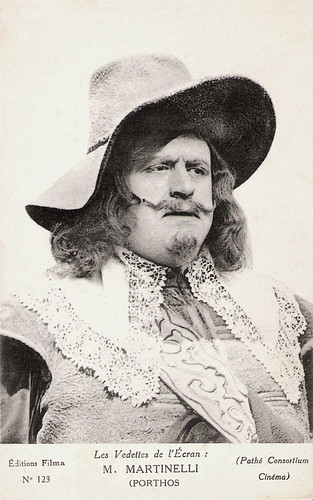
French postcard in the Les Vedettes de l'Écran series by Editions Filma, no. 123. Photo: Pathé Consortium Cinéma. Charles Martinelli as Porthos in Les Trois Mousquetaires/The Three Musketeers (Henri Diamant-Berger 1921).
Cinémagazine: Les Trois Mousquetaires
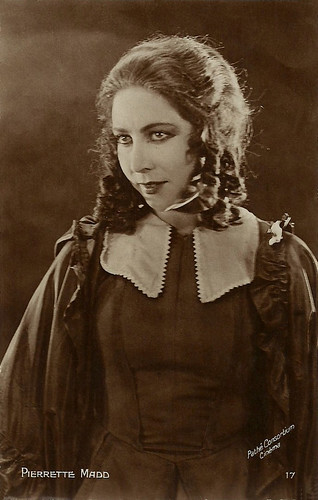
French postcard by Editions Cinémagazine, no. 17. Photo: Pathé Consortium Cinéma. Pierrette Madd as Constance Bonacieux in Les Trois Mousquetaires/The Three Musketeers (Henri Diamant-Berger 1921).
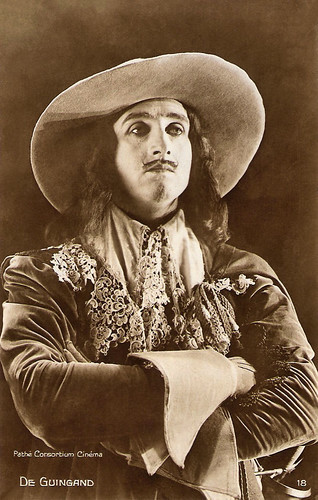
French postcard by Editions Cinémagazine no. 18. Photo: Pathé Consortium Cinéma. Pierre de Guingand as Aramis in Les Trois Mousquetaires/The Three Musketeers (Henri Diamant-Berger, 1921).
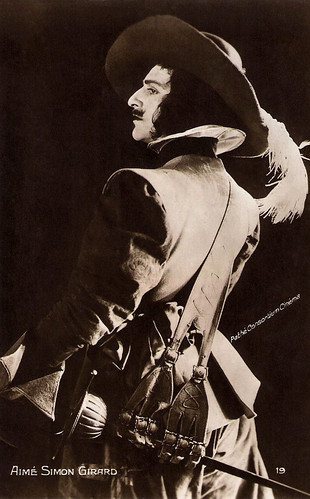
French postcard by Editions Cinémagazine, no. 19. Photo: Pathé Consortium Cinéma. Aimé Simon-Girard as D'Artagnan in Les Trois Mousquetaires/The Three Musketeers (Henri Diamant-Berger, 1921).
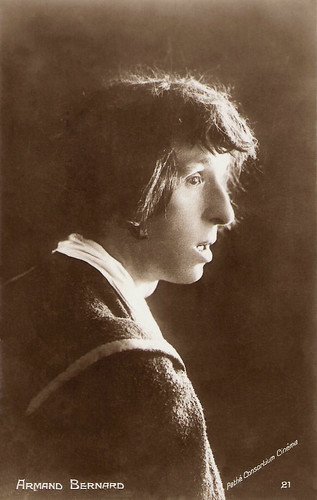
French postcard by Cinémagazine Edition, no. 21. Photo: Pathé Consortium Cinéma. Armand Bernard as Planchet in Les trois mousquetaires/The Three Musketeers (1921).
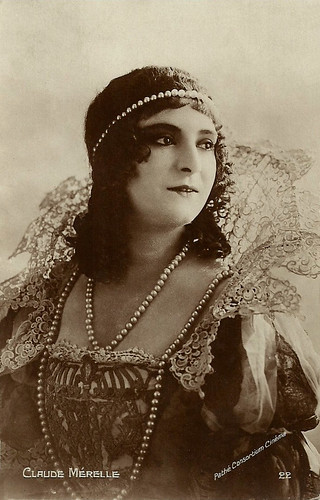
French postcard by Editions Cinémagazine, no. 22. Photo: Pathé Consortium Cinéma. Claude Mérelle as the evil Milady de Winter in Les trois mousquetaires/The Three Musketeers (Henri Diamant-Berger 1921).
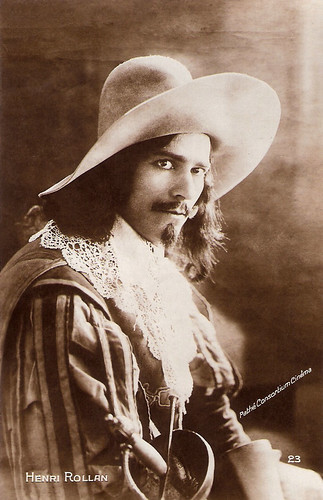
French postcard by Editions Cinémagazine no. 23. Photo: Pathé Consortium Cinéma. Henri Rollan as Athos in Les Trois Mousquetaires/The Three Musketeers (Henri Diamant-Berger, 1921).
Cinémagazine: Vingt ans après
In 1922, one year after the enormous success of Les Trois Mousquetaires/The Three Musketeers (1921), a sequel followed, Vingt ans après/The Return of the Musketeers (1922).
The sequel was also directed by Henri Diamant-Berger. And again, Cinémagazine and Pathé produced a beautiful series of sepia portrait postcards for Vingt ans après.
Vingt ans après was based on another novel by Alexandre Dumas père, which follows events in France during the Fronde, during the childhood reign of Louis XIV, and in England near the end of the English Civil War, leading up to the victory of Oliver Cromwell and the execution of King Charles I.
In Vingt ans après, D'Artagnan was not played by Aimé Simon-Girard this time. Jean Yonnel replaced him. The other three musketeers of the original cast returned: Henri Rollan as Athos, Pierre de Guingand as Aramis, and Charles Martinelli as Porthos.
Other actors who returned were Édouard de Max (Monsieur de Gondi), Armand Bernard (D'Artagnan's servant Planchet) and Pierrette Madd . In Les Trois Mousquetaires, she had played D'Artagnan's girlfriend Constance, who was murdered. In the sequel she returns as a man, Raoul, the Vicomte de Bragelonne, the son of Athos.
They were joined in Vingt ans après by amongst others Marguerite Moreno as Queen Anne of Austria, Jean Périer as Mazarin, Simone Vaudry as Henriette d'Angleterre, and Béatrice Bretty as a beautiful in-keeper.
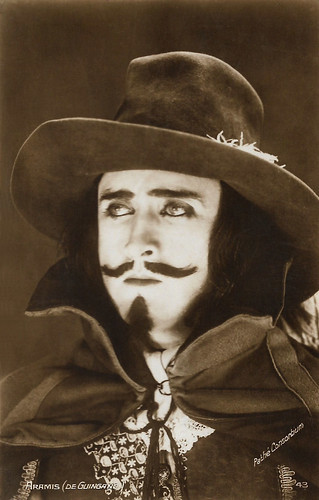
French postcard by Editions Cinémagazine no. 43. Photo: Pathé Consortium Cinéma. Pierre de Guingand as Aramis in Vingt ans après/The Return of the Musketeers (Henri Diamant-Berger, 1922).
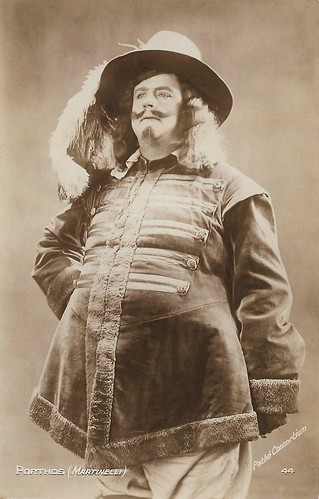
French postcard by Cinémagazine-Edition, no. 44. Photo: Pathé Consortium Cinéma. Charles Martinelli as Porthos in Vingt ans après/The Return of the Musketeers (Henri Diamant-Berger, 1922).
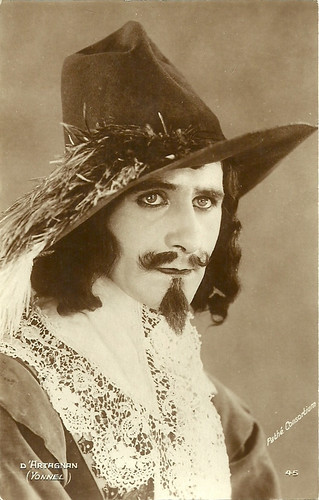
French postcard by Editions Cinémagazine, no. 45. Photo: Pathé Consortium. Jean Yonnel as D'Artagnan in Vingt ans après/The Return of the Musketeers (Henri Diamant-Berger, 1922).
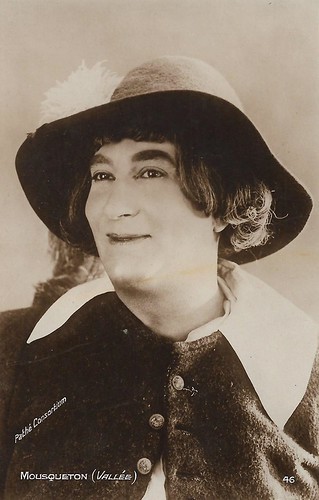
French postcard by Cinémagazine-Edition, no. 46. Photo: Pathé Consortium Cinéma. Marcel Vallée as Mousqueton in Vingt ans après/The Return of the Musketeers (Henri Diamant-Berger, 1921).
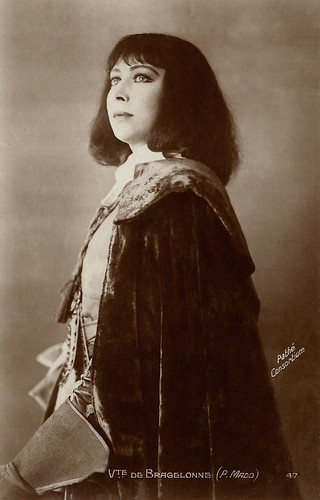
French postcard by Editions Cinémagazine, no. 47. Photo: Pathé Consortium. Pierrette Madd as Raoul, the Vicomte de Bragelonne in Vingt ans après/The Return of the Musketeers (Henri Diamant-Berger, 1922), the sequel to Les Trois mousquetaires/The Three Musketeers (Henri Diamant-Berger, 1921).
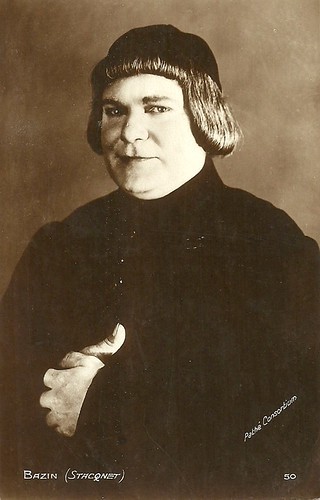
French postcard by Editions Cinémagazine, no. 50. Photo: Pathé Consortium Cinéma. Antoine Stacquet as Bazin, one of the aids of the musketeers, in Vingt ans après/The Return of the Musketeers (Henri Diamant-Berger, 1922).
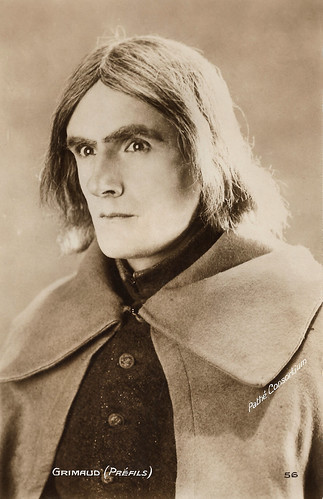
French postcard by Editions Cinémagazine, no. 56. Photo: Pathé Consortium Cinéma. Louis Pré Fils as Grimaud, one of the aids of the musketeers, in Vingt ans après/The Return of the Musketeers (Henri Diamant-Berger, 1922).
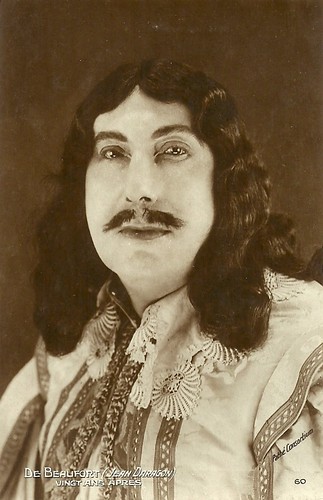
French postcard by Editions Cinémagazine, no. 60. Photo: Pathé Consortium Cinema. Jean Daragon as Duc de Beaufort in Vingt ans après/The Return of the Musketeers (Henri Diamant-Berger, 1922).
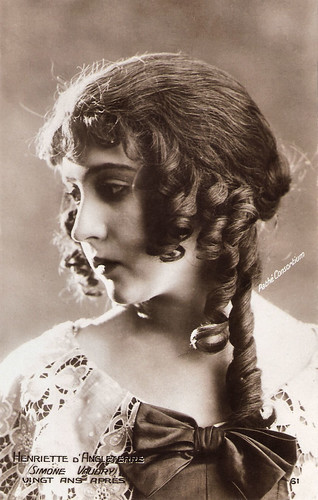
French postcard by Cinémagazine-Édition, Paris, no. 61. Photo: Pathé Consortium Cinéma. Simone Vaudry as Henriette d'Angleterre in Vingt ans après/The Return of the Musketeers (Henri Diamant-Berger, 1922).
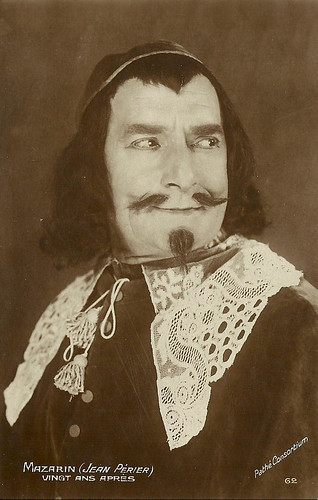
French postcard by Editions Cinémagazine-Edition, no. 62. Photo: Pathé Consortium Cinema. Jean Périer as Mazarin in Vingt ans après/The Return of the Musketeers (Henri Diamant-Berger, 1922). Collection: Didier Hanson.
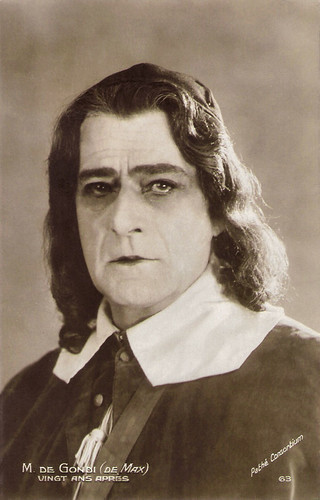
French postcard by Editions Cinémagazine, no. 63. Photo: Pathé Consortium. Édouard de Max as Monsieur de Gondi (and not as Richelieu as IMDb and Wikipedia claim) in Vingt ans après/The Return of the Musketeers (1922), Henri Diamant-Berger's sequel to his earlier film Les trois mousquetaires/The Three Musketeers (1921).
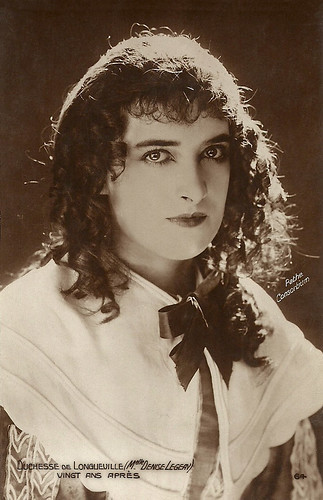
French postcard by Editions Cinémagazine-Edition, no. 64. Photo: Pathé Consortium Cinema. Denise Legeay as Anne Geneviève de Bourbon, Duchess of Longueville in Vingt ans après/The Return of the Musketeers (Henri Diamant-Berger, 1922).
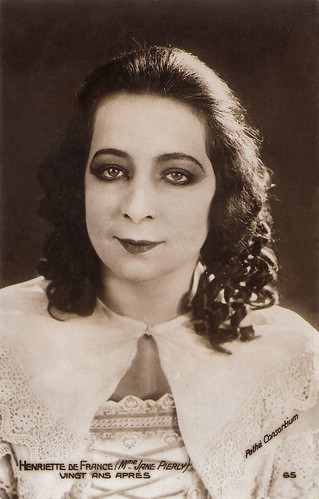
French postcard by Editions Cinémagazine no. 65. Photo: Pathé Consortium Cinéma. Jane Piérly as Henriette de France in Vingt ans après/The Return of the Musketeers (Henri Diamant-Berger, 1922).
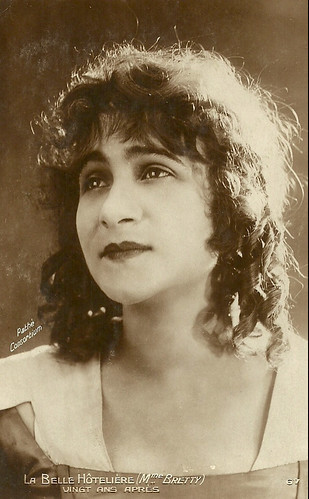
French postcard by Cinémagazine, no. 67. Photo: Pathé Consortium. Béatrice Bretty as the beautiful hotelier in Vingt ans après/The Return of the Musketeers (Henri Diamant-Berger, 1922).
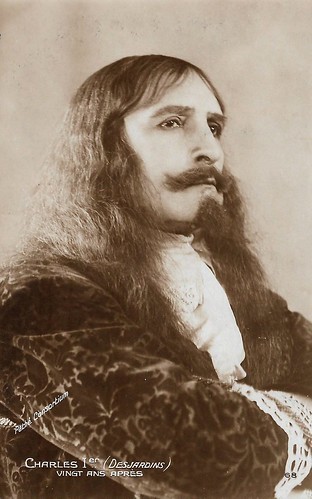
French postcard by Cinémagazine, no. 68. Photo: Pathé Consortium. Maxime Desjardins as the English King Charles I in Vingt ans après/The Return of the Musketeers (Henri Diamant-Berger, 1922).
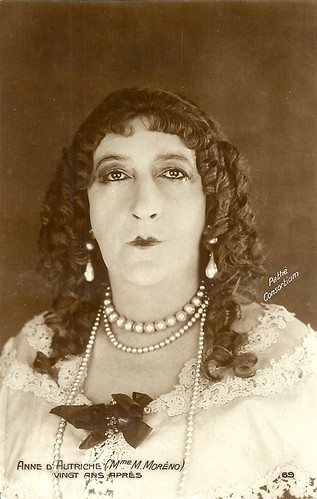
French postcard by Cinémagazine, no. 69. Photo: Pathé Consortium. Marguerite Moreno as Queen Anne of Austria, widow of King Charles XIII in Vingt ans après/The Return of the Musketeers (Henri Diamant-Berger, 1922).
Sources: Fondation Jerome Seydoux (French), Wikipedia (French) and IMDb.
Les Vedettes de l'Écran

French postcard in the Les Vedettes de l'Écran series by Editions Filma, no. 119. Photo: Pathé Consortium Cinéma. Aimé Simon-Girard as D'Artagnan in Les trois mousquetaires/The Three Musketeers (Henri Diamant-Berger, 1921).

French postcard in the Les Vedettes de l'Écran series by Editions Filma, no. 122. Photo: Pathé Consortium Cinéma. Pierre de Guingand as Aramis in Les trois mousquetaires/The Three Musketeers (Henri Diamant-Berger, 1921).

French postcard in the Les Vedettes de l'Écran series by Editions Filma, no. 123. Photo: Pathé Consortium Cinéma. Charles Martinelli as Porthos in Les Trois Mousquetaires/The Three Musketeers (Henri Diamant-Berger 1921).
Cinémagazine: Les Trois Mousquetaires

French postcard by Editions Cinémagazine, no. 17. Photo: Pathé Consortium Cinéma. Pierrette Madd as Constance Bonacieux in Les Trois Mousquetaires/The Three Musketeers (Henri Diamant-Berger 1921).

French postcard by Editions Cinémagazine no. 18. Photo: Pathé Consortium Cinéma. Pierre de Guingand as Aramis in Les Trois Mousquetaires/The Three Musketeers (Henri Diamant-Berger, 1921).

French postcard by Editions Cinémagazine, no. 19. Photo: Pathé Consortium Cinéma. Aimé Simon-Girard as D'Artagnan in Les Trois Mousquetaires/The Three Musketeers (Henri Diamant-Berger, 1921).

French postcard by Cinémagazine Edition, no. 21. Photo: Pathé Consortium Cinéma. Armand Bernard as Planchet in Les trois mousquetaires/The Three Musketeers (1921).

French postcard by Editions Cinémagazine, no. 22. Photo: Pathé Consortium Cinéma. Claude Mérelle as the evil Milady de Winter in Les trois mousquetaires/The Three Musketeers (Henri Diamant-Berger 1921).

French postcard by Editions Cinémagazine no. 23. Photo: Pathé Consortium Cinéma. Henri Rollan as Athos in Les Trois Mousquetaires/The Three Musketeers (Henri Diamant-Berger, 1921).
Cinémagazine: Vingt ans après
In 1922, one year after the enormous success of Les Trois Mousquetaires/The Three Musketeers (1921), a sequel followed, Vingt ans après/The Return of the Musketeers (1922).
The sequel was also directed by Henri Diamant-Berger. And again, Cinémagazine and Pathé produced a beautiful series of sepia portrait postcards for Vingt ans après.
Vingt ans après was based on another novel by Alexandre Dumas père, which follows events in France during the Fronde, during the childhood reign of Louis XIV, and in England near the end of the English Civil War, leading up to the victory of Oliver Cromwell and the execution of King Charles I.
In Vingt ans après, D'Artagnan was not played by Aimé Simon-Girard this time. Jean Yonnel replaced him. The other three musketeers of the original cast returned: Henri Rollan as Athos, Pierre de Guingand as Aramis, and Charles Martinelli as Porthos.
Other actors who returned were Édouard de Max (Monsieur de Gondi), Armand Bernard (D'Artagnan's servant Planchet) and Pierrette Madd . In Les Trois Mousquetaires, she had played D'Artagnan's girlfriend Constance, who was murdered. In the sequel she returns as a man, Raoul, the Vicomte de Bragelonne, the son of Athos.
They were joined in Vingt ans après by amongst others Marguerite Moreno as Queen Anne of Austria, Jean Périer as Mazarin, Simone Vaudry as Henriette d'Angleterre, and Béatrice Bretty as a beautiful in-keeper.

French postcard by Editions Cinémagazine no. 43. Photo: Pathé Consortium Cinéma. Pierre de Guingand as Aramis in Vingt ans après/The Return of the Musketeers (Henri Diamant-Berger, 1922).

French postcard by Cinémagazine-Edition, no. 44. Photo: Pathé Consortium Cinéma. Charles Martinelli as Porthos in Vingt ans après/The Return of the Musketeers (Henri Diamant-Berger, 1922).

French postcard by Editions Cinémagazine, no. 45. Photo: Pathé Consortium. Jean Yonnel as D'Artagnan in Vingt ans après/The Return of the Musketeers (Henri Diamant-Berger, 1922).

French postcard by Cinémagazine-Edition, no. 46. Photo: Pathé Consortium Cinéma. Marcel Vallée as Mousqueton in Vingt ans après/The Return of the Musketeers (Henri Diamant-Berger, 1921).

French postcard by Editions Cinémagazine, no. 47. Photo: Pathé Consortium. Pierrette Madd as Raoul, the Vicomte de Bragelonne in Vingt ans après/The Return of the Musketeers (Henri Diamant-Berger, 1922), the sequel to Les Trois mousquetaires/The Three Musketeers (Henri Diamant-Berger, 1921).

French postcard by Editions Cinémagazine, no. 50. Photo: Pathé Consortium Cinéma. Antoine Stacquet as Bazin, one of the aids of the musketeers, in Vingt ans après/The Return of the Musketeers (Henri Diamant-Berger, 1922).

French postcard by Editions Cinémagazine, no. 56. Photo: Pathé Consortium Cinéma. Louis Pré Fils as Grimaud, one of the aids of the musketeers, in Vingt ans après/The Return of the Musketeers (Henri Diamant-Berger, 1922).

French postcard by Editions Cinémagazine, no. 60. Photo: Pathé Consortium Cinema. Jean Daragon as Duc de Beaufort in Vingt ans après/The Return of the Musketeers (Henri Diamant-Berger, 1922).

French postcard by Cinémagazine-Édition, Paris, no. 61. Photo: Pathé Consortium Cinéma. Simone Vaudry as Henriette d'Angleterre in Vingt ans après/The Return of the Musketeers (Henri Diamant-Berger, 1922).

French postcard by Editions Cinémagazine-Edition, no. 62. Photo: Pathé Consortium Cinema. Jean Périer as Mazarin in Vingt ans après/The Return of the Musketeers (Henri Diamant-Berger, 1922). Collection: Didier Hanson.

French postcard by Editions Cinémagazine, no. 63. Photo: Pathé Consortium. Édouard de Max as Monsieur de Gondi (and not as Richelieu as IMDb and Wikipedia claim) in Vingt ans après/The Return of the Musketeers (1922), Henri Diamant-Berger's sequel to his earlier film Les trois mousquetaires/The Three Musketeers (1921).

French postcard by Editions Cinémagazine-Edition, no. 64. Photo: Pathé Consortium Cinema. Denise Legeay as Anne Geneviève de Bourbon, Duchess of Longueville in Vingt ans après/The Return of the Musketeers (Henri Diamant-Berger, 1922).

French postcard by Editions Cinémagazine no. 65. Photo: Pathé Consortium Cinéma. Jane Piérly as Henriette de France in Vingt ans après/The Return of the Musketeers (Henri Diamant-Berger, 1922).

French postcard by Cinémagazine, no. 67. Photo: Pathé Consortium. Béatrice Bretty as the beautiful hotelier in Vingt ans après/The Return of the Musketeers (Henri Diamant-Berger, 1922).

French postcard by Cinémagazine, no. 68. Photo: Pathé Consortium. Maxime Desjardins as the English King Charles I in Vingt ans après/The Return of the Musketeers (Henri Diamant-Berger, 1922).

French postcard by Cinémagazine, no. 69. Photo: Pathé Consortium. Marguerite Moreno as Queen Anne of Austria, widow of King Charles XIII in Vingt ans après/The Return of the Musketeers (Henri Diamant-Berger, 1922).
Sources: Fondation Jerome Seydoux (French), Wikipedia (French) and IMDb.
Published on July 06, 2020 22:00
July 5, 2020
Hans Mierendorff
Hans Mierendorff (1882-1955) was a German stage and film actor and film director. He became a star as the gentleman-detective Harry Higgs in silent Krimis and also appeared in such classics as Hilde Warren und der Tod (1917), scripted by Fritz Lang, and the popular serial Die Herrin der Welt (1919). He set up his own production company, Lucifer-Film GmbH, serving for four years as its artistic director. During his career, Hans Mierendorff played in over 100 films.
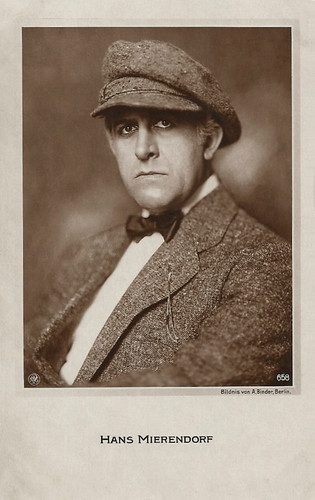
German postcard by NPG, no. 658. Photo: Alex Binder, Berlin.
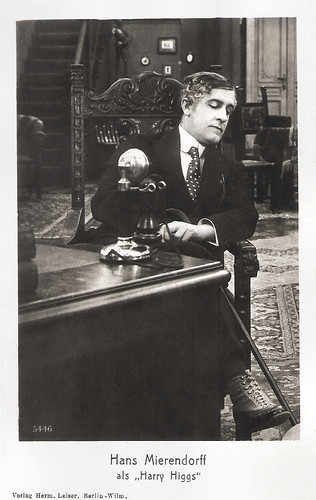
German postcard by Verlag Hermann Leiser, Berlin-Wilm., no. 5446. Hans Mierendorff as Harry Higgs.
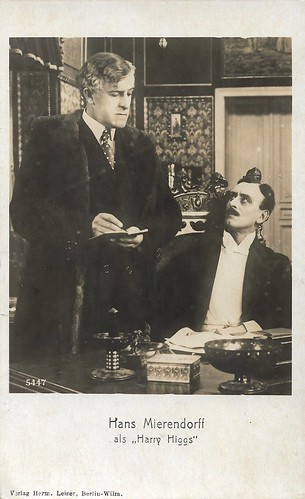
German postcard by Verlag Hermann Leiser, Berlin-Wilm., no. 5447. Hans Mierendorff as Harry Higgs.
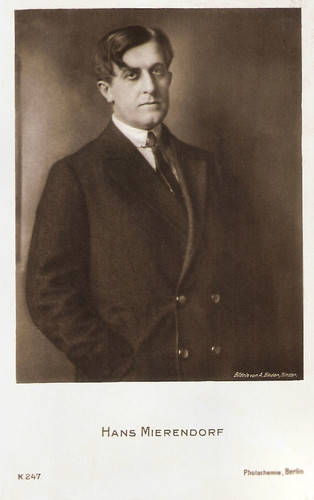
German postcard by Photochemie, Berlin, no. K. 247 Photo: Alex Binder.
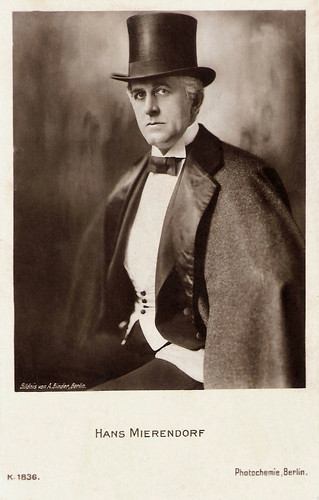
German postcard by Photochemie, Berlin, no. K. 1836. Photo: A. Binder, Berlin.
Tonbilder
Hans Mierendorff was born Johannes Reinhold Mierendorff in Rostock, Germany in 1882, as the son of the merchant Carl Mierendorff and painter Johanna Reinke. He frequented the Oberschule in Rostock and the grandducal gymnasium in Doberan.
After an initial career as a bookshop seller in Schwerin, he had acting lessons at the Hoftheater in Schwerin and soon switched to a stage career, performing in Hamburg, Halle, and Breslau. Between 1911 and 1919 he worked in Berlin on various stages: at the Residenztheater, the Lessingtheater, the Deutsche Künstlertheater, and the Meinhard-Bernauer-Bühnen.
From 1909 on, Mierendorff was also appearing in the so-called 'Tonbilder' or early sound films by Franz Porten. Thanks to the mediation of Henny Porten ’s husband, director/actor Curt Stark, Mierendorff’s real first performance in a silent fiction film was in the Henny Porten -Film Das Adoptivkind/The adoptive child (Rudolf Biebrach, 1911).
In the same year, he played next to Asta Nielsen as her father in Der fremde Vogel/The strange bird (Urban Gad, 1911). Often Mierendorff performed as the elegant, distinguished gentleman.
From 1916 his career took a new turn when he started to perform as the gentlemen-detective Harry Higgs, cashing in on the popular trend of German detective films at the time. The films were scripted by E.A. Dupont, later by Rudolf Meinert.
Mierendorff was also successful as Baron Murphy in the eight-part adventure-serial Die Herrin der Welt/Mistress of the World (1919), produced and partly directed by Joe May and starring Mia May .
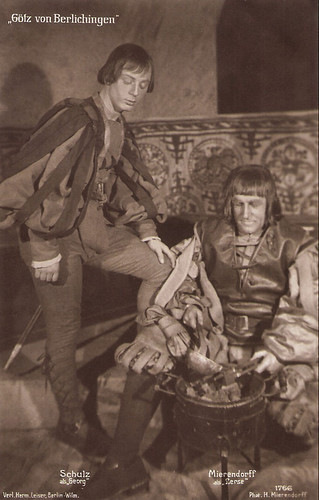
German postcard by Hermann Leiser, Berlin, no. 1766. Photo: Hans Mierendorff. Fritz Schulz as Georg and Hans Mierendorff as Lerse in the stage play 'Götz von Berlichingen', a successful 1773 drama by Johann Wolfgang von Goethe, based on the memoirs of the historical adventurer-poet Gottfried or Götz von Berlichingen.
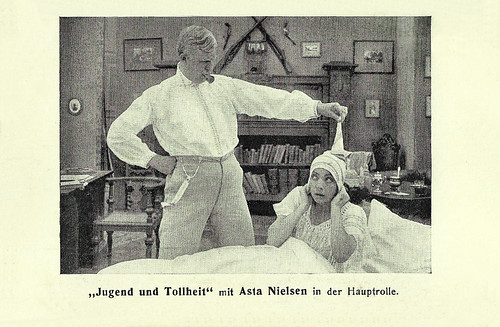
German postcard. Asta Nielsen and Hans Mierendorff in Jugend und Tollheit/Lady Madcap's Way (Urban Gad, 1913).
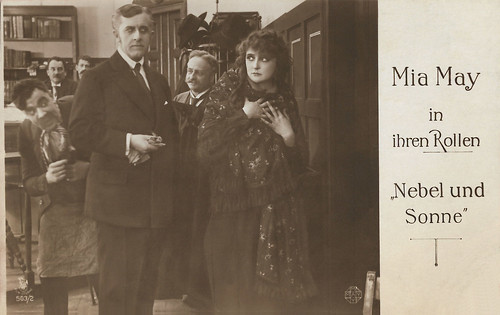
German postcard in the Film-Sterne series by Rotophot, no. 503/2. Photo: May Film. Mia May and Hans Mierendorff in Nebel und Sonne (Joe May, 1916). The film narrates about the martyrdom of a mother.
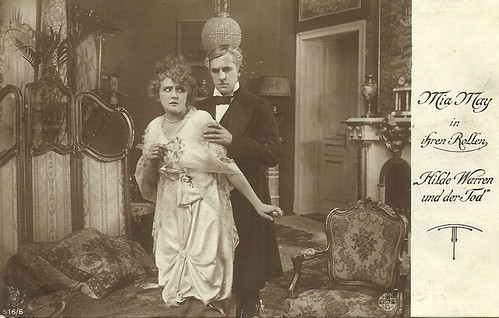
German postcard in the Film-Sterne series by Rotophot, no. 516/6. Photo: May Film. Mia May and Hans Mierendorff in Hilde Warren und der Tod (Joe May, 1917), scripted by Fritz Lang.
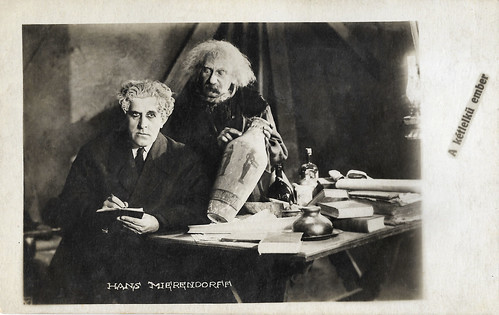
Hungarian postcard, no. 72. Photo: Hans Mierendorff in Ich bin Du/I am you (Hans Mierendorff, Urban Gad, 1921).
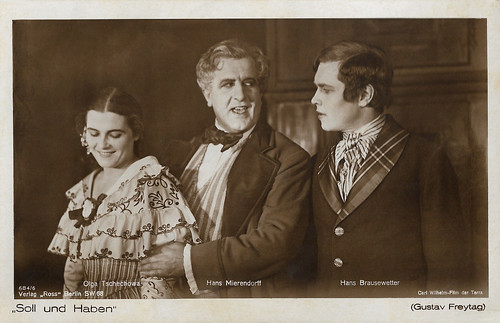
German postcard by Verlag Ross, Berlin, no. 684/6. Photo: Carl-Wilhelm-Film / Terra Film. Olga Tschechova , Hans Mierendorff, and Hans Brausewetter in Soll und Haben/Debit and Credit (Carl Wilhelm, 1924). This German silent film, adapted from the novel by Gustav Freytag, had anti-Semitic and anti-Polish tendencies.
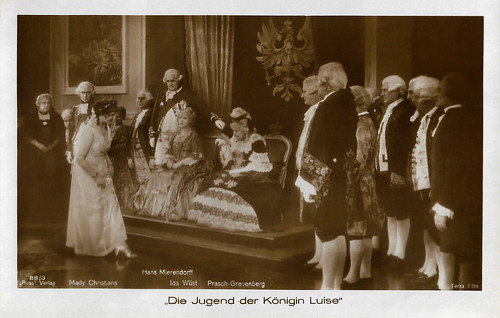
German postcard by Ross Verlag, no. 88/3. Photo: Terra Film. Mady Christians as Louise, Hans Mierendorff, Ida Wüst , and Auguste Prasch-Grevenberg in Königin Luise, 1. Teil - Die Jugend der Königin Luise/Queen Louise (Karl Grune, 1927).
Lucifer
Hans Mierendorff’s detective films were so successful, that he could found his own film company Lucifer-Film GmbH in 1919. He managed Lucifer-Film until its sellout in 1923. He directed some of the films as well, while others were directed by James Bauer.
In his own productions, mostly adventure and crime films, he often played the leads, as in Teufelskirche/The Devil's Church (Hans Mierendorff, 1919). In this film, Mierendorff plays a priest who is seduced by a farmer’s wife (Agnes Straub), who acts on behalf of the devil (Paul Rehkopf) who wants to found a devil’s church on the place of German village chapel. In the end, it proves to be just somebody’s nightmare.
Remarkable were Mierendorff’s dual role in Ich bin Du/I am you (Hans Mierendorff, Urban Gad, 1921), and his role of Fiesco in Die Verschwörung zu Genua/The Genoa Conspiracy (Paul Leni, 1921), co-starring Erna Morena and Fritz Kortner .
In the mid-1920s, Mierendorff was often cast as a banker, industrialist, consul, manager, or lawyer. Examples are his parts as Lee Parry ’s father in Die Motorbraut/The Motor Bride (Richard Eichberg, 1925), and the industrial in Der Mann der sich verkauft/The man who sells himself (Hanns Steinhoff, 1925), co-starring Vivian Gibson and Olaf Fjord .
In the sound film era, Mierendorff only performed as a supporting actor in such films as the historical drama Die Tänzerin von Sans Souci/The Dancer of Sanssouci (Friedrich Zelnik, 1932). Set at the court of Frederick the Great the film is part of a group of Prussian films made during the era. In 1945 Mierndorff completely withdrew from film acting. Subsequently, he ran a pension at the Ostseebad Scharbeutz.
Since 1903 he was married to animal painter Gertrud Schmidt. In 1923 he remarried with singer and actress Auguste Herta Katsch. From this marriage, their son Klaus (1923-1966) stemmed. In 1940 Mierendorff married for the third time with Auguste’s sister Antonie Katsch.
Hans Mierendorff died in 1955 in Eutin, Germany. He was 73. Although he played in more than 100 films during his active career, the name Hans Mierendorff belongs to the forgotten names in film history.
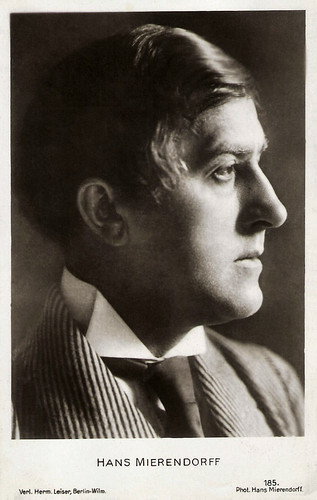
German postcard by Verlag Hermann Leiser, Berlin-Wilm., no. 185. Photo: Hans Mierendorff.
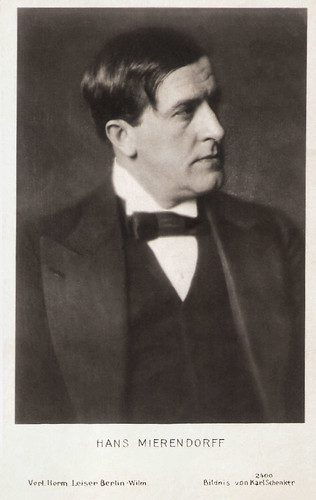
German postcard by Verlag Hermann Leiser, Berlin-Wilm., no. 2400. Photo: Karl Schenker.
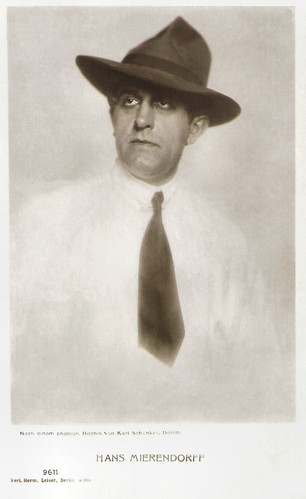
German postcard by Verlag Hermann Leiser, Berlin-Wilm., no. 9611. Photo: Karl Schenker, Berlin.
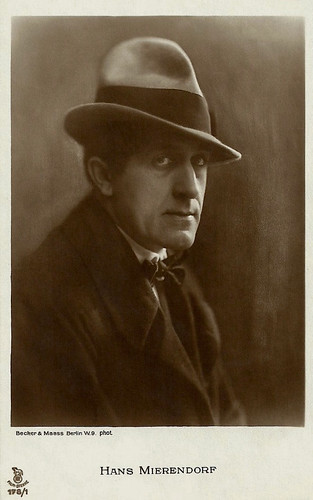
German postcard in the Film Sterne series by Rotophot., no. 178/1. Photo: Becker & Maass, Berlin.
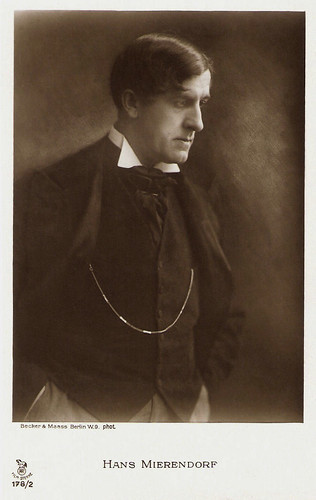
German postcard in the Film Sterne series by Rotophot., no. 178/2. Photo: Becker & Maass, Berlin.
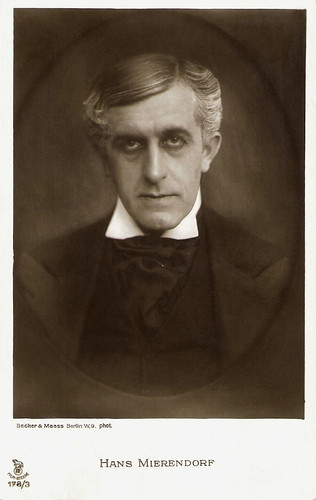
German postcard in the Film Sterne series by Rotophot., no. 178/3. Photo: Becker & Maass, Berlin.
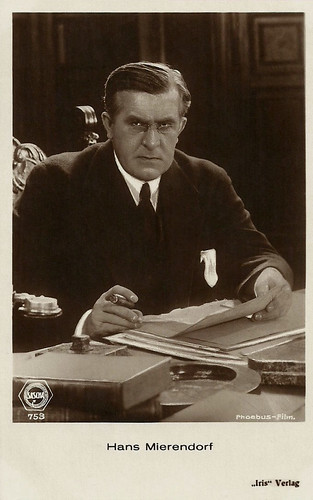
Austrian postcard by Iris-Verlag, no. 753. Photo: Sascha Film / Phoebus-Film.
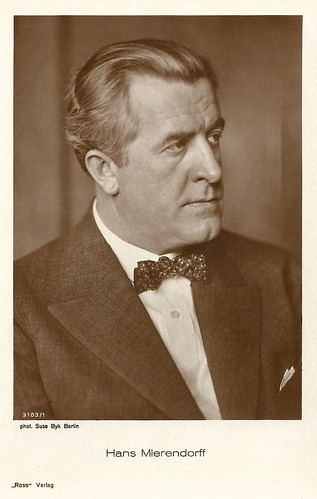
German postcard by Ross Verlag, no. 3103/1. Photo: Suse Byk, Berlin.
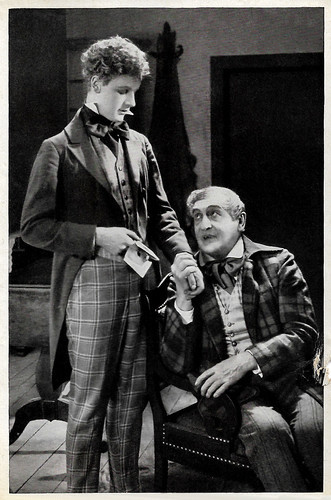
German collectors card in the series 'Vom Werden deutscher Filmkunst - Der Tonfilm', album no. 11, picture no. 130. Photo: Ufa / Ross Verlag. Walter Slezak and Hans Mierendorff in Mein Leopold/My Leopold (Hans Steinhoff, 1931).
Sources: Thomas Staedeli (Cyranos), Film-zeit.de (German- now off-line), Filmportal.de (German), Wikipedia (German), and .

German postcard by NPG, no. 658. Photo: Alex Binder, Berlin.

German postcard by Verlag Hermann Leiser, Berlin-Wilm., no. 5446. Hans Mierendorff as Harry Higgs.

German postcard by Verlag Hermann Leiser, Berlin-Wilm., no. 5447. Hans Mierendorff as Harry Higgs.

German postcard by Photochemie, Berlin, no. K. 247 Photo: Alex Binder.

German postcard by Photochemie, Berlin, no. K. 1836. Photo: A. Binder, Berlin.
Tonbilder
Hans Mierendorff was born Johannes Reinhold Mierendorff in Rostock, Germany in 1882, as the son of the merchant Carl Mierendorff and painter Johanna Reinke. He frequented the Oberschule in Rostock and the grandducal gymnasium in Doberan.
After an initial career as a bookshop seller in Schwerin, he had acting lessons at the Hoftheater in Schwerin and soon switched to a stage career, performing in Hamburg, Halle, and Breslau. Between 1911 and 1919 he worked in Berlin on various stages: at the Residenztheater, the Lessingtheater, the Deutsche Künstlertheater, and the Meinhard-Bernauer-Bühnen.
From 1909 on, Mierendorff was also appearing in the so-called 'Tonbilder' or early sound films by Franz Porten. Thanks to the mediation of Henny Porten ’s husband, director/actor Curt Stark, Mierendorff’s real first performance in a silent fiction film was in the Henny Porten -Film Das Adoptivkind/The adoptive child (Rudolf Biebrach, 1911).
In the same year, he played next to Asta Nielsen as her father in Der fremde Vogel/The strange bird (Urban Gad, 1911). Often Mierendorff performed as the elegant, distinguished gentleman.
From 1916 his career took a new turn when he started to perform as the gentlemen-detective Harry Higgs, cashing in on the popular trend of German detective films at the time. The films were scripted by E.A. Dupont, later by Rudolf Meinert.
Mierendorff was also successful as Baron Murphy in the eight-part adventure-serial Die Herrin der Welt/Mistress of the World (1919), produced and partly directed by Joe May and starring Mia May .

German postcard by Hermann Leiser, Berlin, no. 1766. Photo: Hans Mierendorff. Fritz Schulz as Georg and Hans Mierendorff as Lerse in the stage play 'Götz von Berlichingen', a successful 1773 drama by Johann Wolfgang von Goethe, based on the memoirs of the historical adventurer-poet Gottfried or Götz von Berlichingen.

German postcard. Asta Nielsen and Hans Mierendorff in Jugend und Tollheit/Lady Madcap's Way (Urban Gad, 1913).

German postcard in the Film-Sterne series by Rotophot, no. 503/2. Photo: May Film. Mia May and Hans Mierendorff in Nebel und Sonne (Joe May, 1916). The film narrates about the martyrdom of a mother.

German postcard in the Film-Sterne series by Rotophot, no. 516/6. Photo: May Film. Mia May and Hans Mierendorff in Hilde Warren und der Tod (Joe May, 1917), scripted by Fritz Lang.

Hungarian postcard, no. 72. Photo: Hans Mierendorff in Ich bin Du/I am you (Hans Mierendorff, Urban Gad, 1921).

German postcard by Verlag Ross, Berlin, no. 684/6. Photo: Carl-Wilhelm-Film / Terra Film. Olga Tschechova , Hans Mierendorff, and Hans Brausewetter in Soll und Haben/Debit and Credit (Carl Wilhelm, 1924). This German silent film, adapted from the novel by Gustav Freytag, had anti-Semitic and anti-Polish tendencies.

German postcard by Ross Verlag, no. 88/3. Photo: Terra Film. Mady Christians as Louise, Hans Mierendorff, Ida Wüst , and Auguste Prasch-Grevenberg in Königin Luise, 1. Teil - Die Jugend der Königin Luise/Queen Louise (Karl Grune, 1927).
Lucifer
Hans Mierendorff’s detective films were so successful, that he could found his own film company Lucifer-Film GmbH in 1919. He managed Lucifer-Film until its sellout in 1923. He directed some of the films as well, while others were directed by James Bauer.
In his own productions, mostly adventure and crime films, he often played the leads, as in Teufelskirche/The Devil's Church (Hans Mierendorff, 1919). In this film, Mierendorff plays a priest who is seduced by a farmer’s wife (Agnes Straub), who acts on behalf of the devil (Paul Rehkopf) who wants to found a devil’s church on the place of German village chapel. In the end, it proves to be just somebody’s nightmare.
Remarkable were Mierendorff’s dual role in Ich bin Du/I am you (Hans Mierendorff, Urban Gad, 1921), and his role of Fiesco in Die Verschwörung zu Genua/The Genoa Conspiracy (Paul Leni, 1921), co-starring Erna Morena and Fritz Kortner .
In the mid-1920s, Mierendorff was often cast as a banker, industrialist, consul, manager, or lawyer. Examples are his parts as Lee Parry ’s father in Die Motorbraut/The Motor Bride (Richard Eichberg, 1925), and the industrial in Der Mann der sich verkauft/The man who sells himself (Hanns Steinhoff, 1925), co-starring Vivian Gibson and Olaf Fjord .
In the sound film era, Mierendorff only performed as a supporting actor in such films as the historical drama Die Tänzerin von Sans Souci/The Dancer of Sanssouci (Friedrich Zelnik, 1932). Set at the court of Frederick the Great the film is part of a group of Prussian films made during the era. In 1945 Mierndorff completely withdrew from film acting. Subsequently, he ran a pension at the Ostseebad Scharbeutz.
Since 1903 he was married to animal painter Gertrud Schmidt. In 1923 he remarried with singer and actress Auguste Herta Katsch. From this marriage, their son Klaus (1923-1966) stemmed. In 1940 Mierendorff married for the third time with Auguste’s sister Antonie Katsch.
Hans Mierendorff died in 1955 in Eutin, Germany. He was 73. Although he played in more than 100 films during his active career, the name Hans Mierendorff belongs to the forgotten names in film history.

German postcard by Verlag Hermann Leiser, Berlin-Wilm., no. 185. Photo: Hans Mierendorff.

German postcard by Verlag Hermann Leiser, Berlin-Wilm., no. 2400. Photo: Karl Schenker.

German postcard by Verlag Hermann Leiser, Berlin-Wilm., no. 9611. Photo: Karl Schenker, Berlin.

German postcard in the Film Sterne series by Rotophot., no. 178/1. Photo: Becker & Maass, Berlin.

German postcard in the Film Sterne series by Rotophot., no. 178/2. Photo: Becker & Maass, Berlin.

German postcard in the Film Sterne series by Rotophot., no. 178/3. Photo: Becker & Maass, Berlin.

Austrian postcard by Iris-Verlag, no. 753. Photo: Sascha Film / Phoebus-Film.

German postcard by Ross Verlag, no. 3103/1. Photo: Suse Byk, Berlin.

German collectors card in the series 'Vom Werden deutscher Filmkunst - Der Tonfilm', album no. 11, picture no. 130. Photo: Ufa / Ross Verlag. Walter Slezak and Hans Mierendorff in Mein Leopold/My Leopold (Hans Steinhoff, 1931).
Sources: Thomas Staedeli (Cyranos), Film-zeit.de (German- now off-line), Filmportal.de (German), Wikipedia (German), and .
Published on July 05, 2020 22:00
July 4, 2020
Fay Wray
Canadian-born American actress Fay Wray (1907-2004) attained international recognition as the first 'scream queen' in a series of horror films during the early 1930s. Through an acting career that spanned nearly six decades, Wray is best known as Ann Darrow, the girl held in the hand of King Kong (1933). Two days after her death, the lights of the Empire State Building, the location of King Kong's climax scene, were dimmed for 15 minutes in memory of the "beauty who charmed the beast".
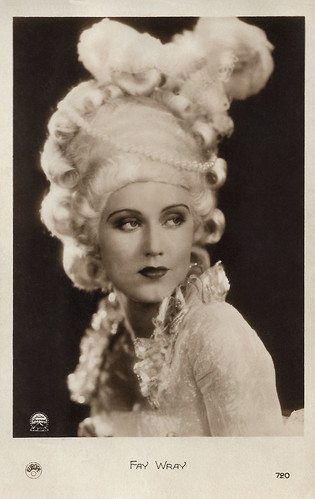
French postcard by Europe, no. 720. Photo: Paramount. Fay Wray in Pointed Heels (A. Edward Sutherland, 1929).
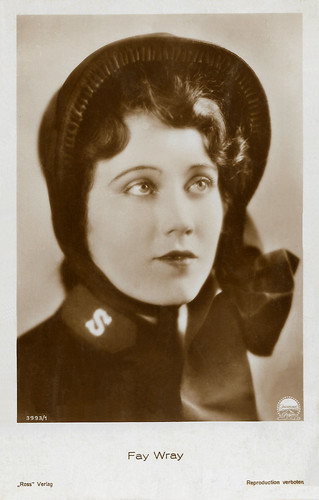
German postcard by Ross Verlag, no. 3993/1, 1928-1929. Photo: Paramount. Fay Wray in Street of Sin (Mauritz Stiller, 1928).
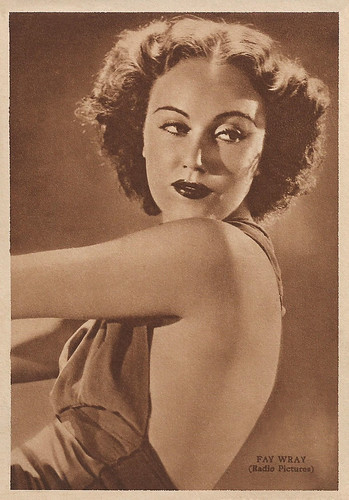
Italian postcard by Rizzoli & C., Milano, 1940. Photo: Radio Pictures.
One of the WAMPAS Baby Stars of 1926
Vina Fay Wray was born in 1907 on a ranch near Cardston in the province of Alberta, Canada. Her American parents, Elvina Marguerite Jones and Joseph Heber Wray, were members of The Church of Jesus Christ of Latter-day Saints. She was one of six children.
Her family returned to the United States a few years after she was born, in order for her father to find better work than what was offered in Alberta. They moved to Salt Lake City in 1912, and later they relocated to Los Angeles, where Fay attended Hollywood High School. Her parents divorced, which put the rest of the family in hard times.
Being in entertainment-rich Los Angeles, there was ample opportunity to take advantage of the chances that might come her way in the entertainment industry. At the age of 16, Wray made her film debut, when she landed a role in a short historical film, Gasoline Love (1923), sponsored by a local newspaper. The film was not a hit, nor was it a launching vehicle for her career.
It would be two more years before she ever got another chance. Wray landed a major role in the silent film The Coast Patrol (Bud Barsky, 1925), as well as uncredited bit parts at the Hal Roach Studios. In 1926, the Western Association of Motion Picture Advertisers selected Wray, along with Janet Gaynor and Mary Astor, as one of the 'WAMPAS Baby Stars', a group of thirteen starlets whom they believed to be on the threshold of movie stardom. She was at the time under contract to Universal Studios, mostly co-starring in low-budget Westerns opposite Buck Jones.
The following year, Wray was signed to a contract with Paramount Pictures. In 1926, director Erich von Stroheim cast her as the main female lead in his film The Wedding March (Erich von Stroheim, 1928), released by Paramount two years later. Over the six months of filming, Stroheim shot over 200,000 feet of film. The film's original budget was estimated at $300,000 ($4,333,000 today). By the time film producer Pat Powers shut down production, the budget had risen to $1,250,000 ($18,398,000 today). While the film was noted for its production values, it was a financial failure.
After her first lead role, Wray stayed with Paramount to make more than a dozen films, including Thunderbolt (Josef von Sternberg, 1929) with George Bancroft , and made the transition from silent films to 'talkies'.
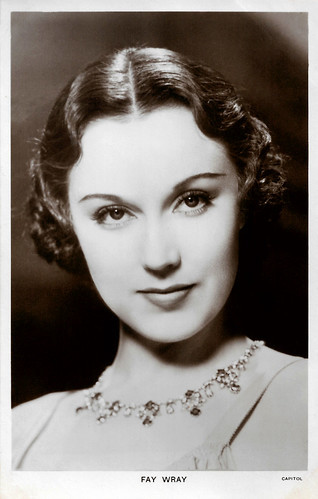
British postcard in the Picturegoer Series, no. 1169. Photo: Capitol.
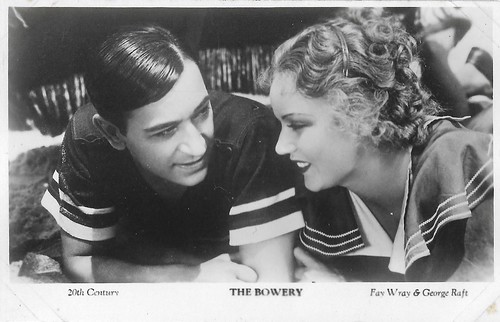
British postcard in the Film Shots series by Film Weekly. Photo: 20th Century. Fay Wray and George Raft on the beach in the pre-Code movie The Bowery (Raoul Walsh, 1933).
A giant gorilla as her 'tall, dark leading man'
After leaving Paramount, Fay Wray signed to various film companies. Under these deals, Wray was cast in various horror films, including Doctor X (Michael Curtiz, 1932), The Vampire Bat (Frank R. Strayer, 1933), and Mystery of the Wax Museum (Michael Curtiz, 1933), all starring Lionel Atwill.
In addition, she appeared in many other types of roles, including in The Bowery (Raoul Walsh, 1933) and Viva Villa (Jack Conway, 1934), both of which starred Wallace Beery.
However, her best-known films were produced under her deal with RKO Radio Pictures, Inc. Her first film under RKO was The Most Dangerous Game (Irving Pichel, Ernest B. Schoedsack, 1932), co-starring Joel McCrea.
It was followed by Wray's most memorable film, King Kong (Merian C. Cooper, Ernest B. Schoedsack, 1933) with Bruce Cabot. The Most Dangerous Game was shot at night on the same jungle sets that were being used for King Kong during the day, with Wray and Robert Armstrong starring in both films.
When first-choice Jean Harlow proved to unavailable, Wray was approached by director Merian C. Cooper to play the role of Ann Darrow, the blonde captive of King Kong. Cooper told her that he had a part for her in a picture in which she would be working with a tall, dark leading man. What he didn't tell her was that her "tall, dark leading man" was a giant gorilla. Wray was paid $10,000 ($200,000 in 2020 dollars) to play the role.
Tony Fontana at IMDb : "Perhaps no one in the history of pictures could scream more dramatically than Fay, and she really put on a show in "Kong". Her character provided a combination of sex appeal, vulnerability, and lung capacity as she was stalked by the giant beast all the way to the top of the Empire State Building."
The film was a commercial success and Wray was reportedly proud that the film saved RKO from bankruptcy. Ann Darrow became the role with which Wray was most associated. In 1933, Fay Wray also became a naturalised citizen of the United States.
She continued to star in various films, including the romantic comedy The Richest Girl in the World (William A. Seiter, 1934), a second film with Joel McCrea, but by the early 1940s, her appearances became less frequent. She retired from acting in 1942 after her second marriage but due to financial exigencies soon resumed her acting career.
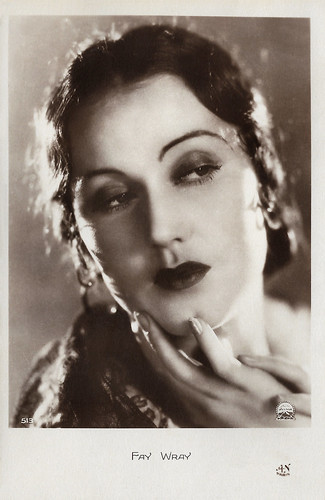
French postcard by A.N., Paris, no. 513. Photo: Paramount.
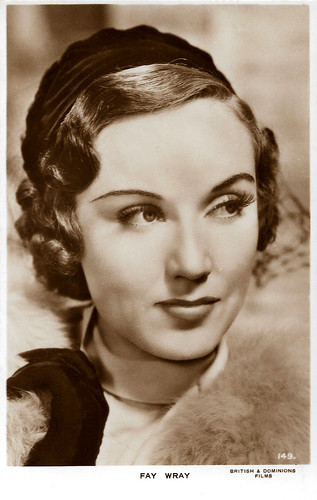
British postcard by Milton, no. 149. Photo: British & Dominions Films.
Turning the Titanic down
Over the next three decades, Fray Wray appeared in several films and she was also frequently seen on television. Wray was cast in the sitcom The Pride of the Family (1953-1954) as Catherine Morrison. Paul Hartman played her husband, Albie Morrison. Natalie Wood and Robert Hyatt played their children, Ann and Junior Morrison, respectively.
Wray appeared with fellow WAMPAS Baby Star Joan Crawford in the Film Noir drama Queen Bee (Ranald MacDougall, 1955). Wray appeared in three episodes of Perry Mason: The Case Of The Prodigal Parent (1958); The Case of the Watery Witness (1959), as murder victim Lorna Thomas; and The Case of the Fatal Fetish (1965), as voodoo practitioner Mignon Germaine.
Other roles around this time were in the episodes Dip in the Pool (1958) and The Morning After of Alfred Hitchcock Presents. In 1960, she appeared as Clara in an episode of 77 Sunset Strip, Who Killed Cock Robin?
She ended her acting career in the made-for-television film Gideon's Trumpet (Robert Collins, 1980), starring Henry Fonda .
In 1988, she published her autobiography 'On the Other Hand'. In her later years, Wray continued to make public appearances. In 1991, she was crowned Queen of the Beaux-Arts Ball presiding with King Herbert Huncke.
She was approached by James Cameron to play the part of Rose Dawson Calvert for his blockbuster Titanic (James Cameron, 1997) with Kate Winslet to play her younger self, but she turned down the role, which was played by Gloria Stuart.
In 1998, King Kong wound up being named one of the 100 greatest films of all time by the American Film Institute. On the 70th Annual Academy Awards (1998), Billy Crystal introduced a clip of her in King Kong (1933) and then came offstage and stood next to Miss Wray in the audience, and introduced her as the "Beauty who charmed the Beast, the Legendary Fay Wray".
In 2003, the 95-year-old Wray appeared at the 2003 Palm Beach International Film Festival to celebrate the documentary film Broadway: The Golden Age, by the Legends Who Were There (Rick McKay, 2003), which she also appeared in. She was honored with a 'Legend in Film' award.
In 2004, Wray was approached by director Peter Jackson to appear in a small cameo for his remake of King Kong (Peter Jackson, 2005). Jackson wanted Fay to say the closing line of the film. She met with Naomi Watts, who was to play the role of Ann Darrow, but she politely declined the cameo and claimed the original "Kong" to be the true "King".
Before the filming of the remake commenced, Wray died in her sleep of natural causes on 8 August 2004, in her apartment in Manhattan, five weeks before her 97th birthday. Wray is interred at the Hollywood Forever Cemetery in Hollywood, California.
Fay Wray married three times. Her husbands were the authors John Monk Saunders (1928-1939; divorce) and Robert Riskin (1942-1955; his death), and the neurosurgeon Sanford Rothenberg (1971-1991; his death). She had three children: Susan Saunders, Victoria Riskin, and Robert Riskin Jr.
Denny Jackson at IMDb : "She was an excellent actress who never was given a chance to live up to her potential, especially after being cast in a number of horror films in the '30s. Given the right role, Fay could have had her star up alongside the great actresses of the day. No matter. She remains a bright star from cinema's golden era."
Trailer The Most Dangerous Game (Irving Pichel, Ernest B. Schoedsack, 1932). Source: WKAJ Entertainment (YouTube).
Trailer King Kong (Merian C. Cooper, Ernest B. Schoedsack, 1933). Source: Warner Bros (YouTube).
Sources: (IMDb), (IMDb), Wikipedia, and .

French postcard by Europe, no. 720. Photo: Paramount. Fay Wray in Pointed Heels (A. Edward Sutherland, 1929).

German postcard by Ross Verlag, no. 3993/1, 1928-1929. Photo: Paramount. Fay Wray in Street of Sin (Mauritz Stiller, 1928).

Italian postcard by Rizzoli & C., Milano, 1940. Photo: Radio Pictures.
One of the WAMPAS Baby Stars of 1926
Vina Fay Wray was born in 1907 on a ranch near Cardston in the province of Alberta, Canada. Her American parents, Elvina Marguerite Jones and Joseph Heber Wray, were members of The Church of Jesus Christ of Latter-day Saints. She was one of six children.
Her family returned to the United States a few years after she was born, in order for her father to find better work than what was offered in Alberta. They moved to Salt Lake City in 1912, and later they relocated to Los Angeles, where Fay attended Hollywood High School. Her parents divorced, which put the rest of the family in hard times.
Being in entertainment-rich Los Angeles, there was ample opportunity to take advantage of the chances that might come her way in the entertainment industry. At the age of 16, Wray made her film debut, when she landed a role in a short historical film, Gasoline Love (1923), sponsored by a local newspaper. The film was not a hit, nor was it a launching vehicle for her career.
It would be two more years before she ever got another chance. Wray landed a major role in the silent film The Coast Patrol (Bud Barsky, 1925), as well as uncredited bit parts at the Hal Roach Studios. In 1926, the Western Association of Motion Picture Advertisers selected Wray, along with Janet Gaynor and Mary Astor, as one of the 'WAMPAS Baby Stars', a group of thirteen starlets whom they believed to be on the threshold of movie stardom. She was at the time under contract to Universal Studios, mostly co-starring in low-budget Westerns opposite Buck Jones.
The following year, Wray was signed to a contract with Paramount Pictures. In 1926, director Erich von Stroheim cast her as the main female lead in his film The Wedding March (Erich von Stroheim, 1928), released by Paramount two years later. Over the six months of filming, Stroheim shot over 200,000 feet of film. The film's original budget was estimated at $300,000 ($4,333,000 today). By the time film producer Pat Powers shut down production, the budget had risen to $1,250,000 ($18,398,000 today). While the film was noted for its production values, it was a financial failure.
After her first lead role, Wray stayed with Paramount to make more than a dozen films, including Thunderbolt (Josef von Sternberg, 1929) with George Bancroft , and made the transition from silent films to 'talkies'.

British postcard in the Picturegoer Series, no. 1169. Photo: Capitol.

British postcard in the Film Shots series by Film Weekly. Photo: 20th Century. Fay Wray and George Raft on the beach in the pre-Code movie The Bowery (Raoul Walsh, 1933).
A giant gorilla as her 'tall, dark leading man'
After leaving Paramount, Fay Wray signed to various film companies. Under these deals, Wray was cast in various horror films, including Doctor X (Michael Curtiz, 1932), The Vampire Bat (Frank R. Strayer, 1933), and Mystery of the Wax Museum (Michael Curtiz, 1933), all starring Lionel Atwill.
In addition, she appeared in many other types of roles, including in The Bowery (Raoul Walsh, 1933) and Viva Villa (Jack Conway, 1934), both of which starred Wallace Beery.
However, her best-known films were produced under her deal with RKO Radio Pictures, Inc. Her first film under RKO was The Most Dangerous Game (Irving Pichel, Ernest B. Schoedsack, 1932), co-starring Joel McCrea.
It was followed by Wray's most memorable film, King Kong (Merian C. Cooper, Ernest B. Schoedsack, 1933) with Bruce Cabot. The Most Dangerous Game was shot at night on the same jungle sets that were being used for King Kong during the day, with Wray and Robert Armstrong starring in both films.
When first-choice Jean Harlow proved to unavailable, Wray was approached by director Merian C. Cooper to play the role of Ann Darrow, the blonde captive of King Kong. Cooper told her that he had a part for her in a picture in which she would be working with a tall, dark leading man. What he didn't tell her was that her "tall, dark leading man" was a giant gorilla. Wray was paid $10,000 ($200,000 in 2020 dollars) to play the role.
Tony Fontana at IMDb : "Perhaps no one in the history of pictures could scream more dramatically than Fay, and she really put on a show in "Kong". Her character provided a combination of sex appeal, vulnerability, and lung capacity as she was stalked by the giant beast all the way to the top of the Empire State Building."
The film was a commercial success and Wray was reportedly proud that the film saved RKO from bankruptcy. Ann Darrow became the role with which Wray was most associated. In 1933, Fay Wray also became a naturalised citizen of the United States.
She continued to star in various films, including the romantic comedy The Richest Girl in the World (William A. Seiter, 1934), a second film with Joel McCrea, but by the early 1940s, her appearances became less frequent. She retired from acting in 1942 after her second marriage but due to financial exigencies soon resumed her acting career.

French postcard by A.N., Paris, no. 513. Photo: Paramount.

British postcard by Milton, no. 149. Photo: British & Dominions Films.
Turning the Titanic down
Over the next three decades, Fray Wray appeared in several films and she was also frequently seen on television. Wray was cast in the sitcom The Pride of the Family (1953-1954) as Catherine Morrison. Paul Hartman played her husband, Albie Morrison. Natalie Wood and Robert Hyatt played their children, Ann and Junior Morrison, respectively.
Wray appeared with fellow WAMPAS Baby Star Joan Crawford in the Film Noir drama Queen Bee (Ranald MacDougall, 1955). Wray appeared in three episodes of Perry Mason: The Case Of The Prodigal Parent (1958); The Case of the Watery Witness (1959), as murder victim Lorna Thomas; and The Case of the Fatal Fetish (1965), as voodoo practitioner Mignon Germaine.
Other roles around this time were in the episodes Dip in the Pool (1958) and The Morning After of Alfred Hitchcock Presents. In 1960, she appeared as Clara in an episode of 77 Sunset Strip, Who Killed Cock Robin?
She ended her acting career in the made-for-television film Gideon's Trumpet (Robert Collins, 1980), starring Henry Fonda .
In 1988, she published her autobiography 'On the Other Hand'. In her later years, Wray continued to make public appearances. In 1991, she was crowned Queen of the Beaux-Arts Ball presiding with King Herbert Huncke.
She was approached by James Cameron to play the part of Rose Dawson Calvert for his blockbuster Titanic (James Cameron, 1997) with Kate Winslet to play her younger self, but she turned down the role, which was played by Gloria Stuart.
In 1998, King Kong wound up being named one of the 100 greatest films of all time by the American Film Institute. On the 70th Annual Academy Awards (1998), Billy Crystal introduced a clip of her in King Kong (1933) and then came offstage and stood next to Miss Wray in the audience, and introduced her as the "Beauty who charmed the Beast, the Legendary Fay Wray".
In 2003, the 95-year-old Wray appeared at the 2003 Palm Beach International Film Festival to celebrate the documentary film Broadway: The Golden Age, by the Legends Who Were There (Rick McKay, 2003), which she also appeared in. She was honored with a 'Legend in Film' award.
In 2004, Wray was approached by director Peter Jackson to appear in a small cameo for his remake of King Kong (Peter Jackson, 2005). Jackson wanted Fay to say the closing line of the film. She met with Naomi Watts, who was to play the role of Ann Darrow, but she politely declined the cameo and claimed the original "Kong" to be the true "King".
Before the filming of the remake commenced, Wray died in her sleep of natural causes on 8 August 2004, in her apartment in Manhattan, five weeks before her 97th birthday. Wray is interred at the Hollywood Forever Cemetery in Hollywood, California.
Fay Wray married three times. Her husbands were the authors John Monk Saunders (1928-1939; divorce) and Robert Riskin (1942-1955; his death), and the neurosurgeon Sanford Rothenberg (1971-1991; his death). She had three children: Susan Saunders, Victoria Riskin, and Robert Riskin Jr.
Denny Jackson at IMDb : "She was an excellent actress who never was given a chance to live up to her potential, especially after being cast in a number of horror films in the '30s. Given the right role, Fay could have had her star up alongside the great actresses of the day. No matter. She remains a bright star from cinema's golden era."
Trailer The Most Dangerous Game (Irving Pichel, Ernest B. Schoedsack, 1932). Source: WKAJ Entertainment (YouTube).
Trailer King Kong (Merian C. Cooper, Ernest B. Schoedsack, 1933). Source: Warner Bros (YouTube).
Sources: (IMDb), (IMDb), Wikipedia, and .
Published on July 04, 2020 22:00
July 3, 2020
What letter? THE letter
Long before WhatsApp, before e-mail, even before the telephone, there was... the letter. People wrote them by hand, with ink and in the early days even with a feather. In films, letters were mostly mysterious. Especially in the silent era, letters could carry secrets and lies, but also many love letters were written and read and discovered. Ivo and I searched through our collections and chose 21 film European star postcards with a letter.
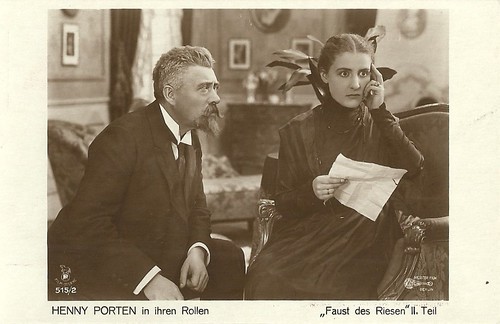
German postcard in the Film Sterne Series by Rotophot, no. 515/2. Photo: Messter Film, Berlin. Henny Porten in the German two-part silent film drama Die Faust des Riesen (Rudolf Biebrach, 1917).
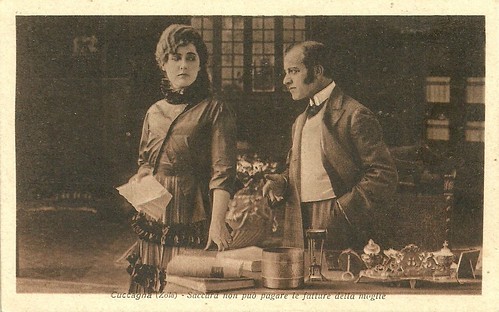
Italian postcard by IPA CT. V. Uff. Rev. St. - Terni, no. 5074. Photo: Tiber Film. Postcard for La Cuccagna (Baldassarre Negroni, 17 1917), starring Hesperia as Renata Beraud, here also with Claudio Nicola as Aristide Saccard. Caption: "Saccard cannot pay the bills of his wife anymore."
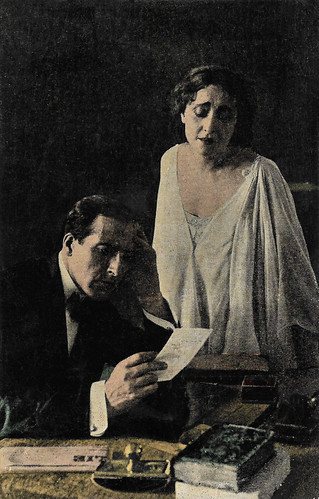
Spanish collectors card for Chocolat Imperiale by Imp. Bayer Hnos. y C.a. Chromophotography. Lyda Borelli in the Italian melodrama Il dramma di una notte/The Drama of One Night (Mario Caserini, 1918).
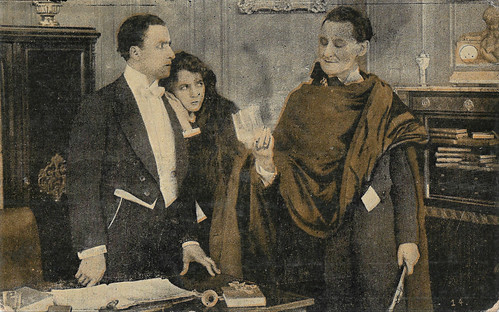
Spanish postcard by Amatller Marca Luna, Series 6, no. 14. Photo: Eclipse. Suzanne Grandais in the French drama Lorena (Georges Tréville, 1918).
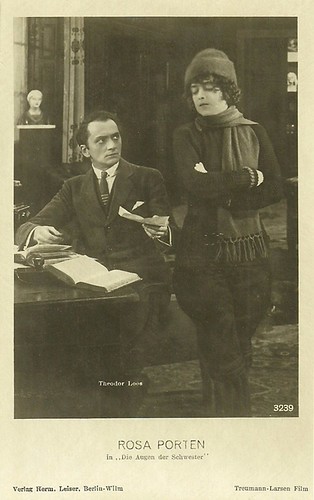
German postcard by Verlag Hermann Leiser, Berlin, no. 3239. Photo: Treumann-Larsen-Film. Rosa Porten and Theodor Loos in Die Augen der Schwester/The eyes of the sister (Franz Eckstein, 1918). Porten also scripted the film.
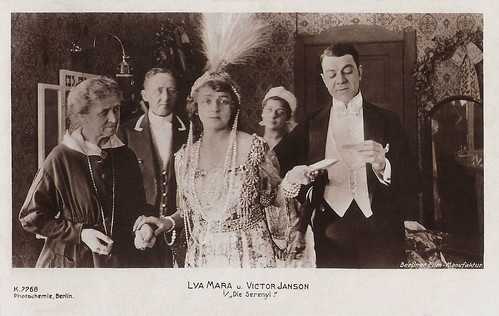
German postcard by Photochemie, Berlin, K. 2268. Photo: Berliner Film-Manufaktur. Lya Mara and Victor Janson in Die Serenyi (Alfred Halm, 1918).
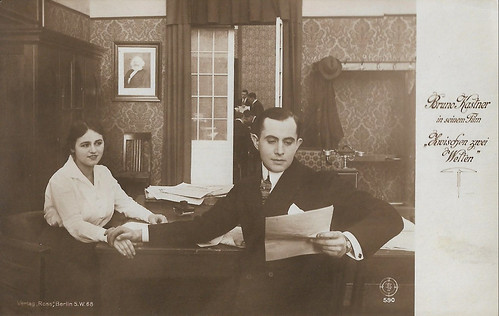
German postcard by Verlag Ross, no. 590. Photo: Ring-Film. Bruno Kastner and Hanni Weisse in the German silent film Zwischen zwei Welten/Between two worlds (Adolf Gärtner, 1919).
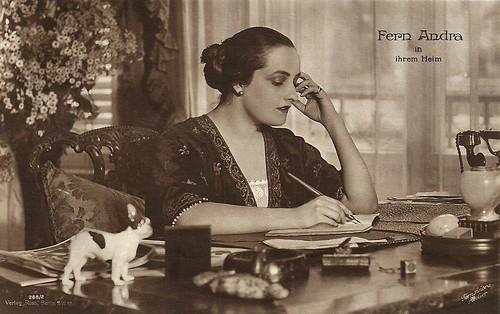
German postcard by Ross Verlag, Berlin, no. 288/2, 1919-1924. Fern Andra Atelier. Caption: Fern Andra in ihrem Heim (Fern Andra at her home).
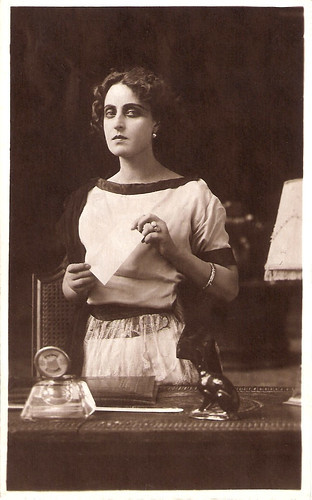
Italian postcard. Photo: Rinascimento Film, Roma. Pina Menichelli in La seconda moglie (Amleto Palermi, 1923). Caption: That monotonous and grey life awoke in the rebel a whole lost world.
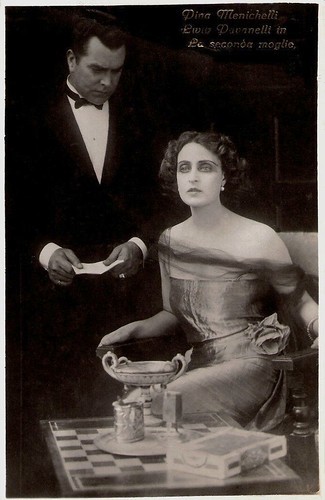
Italian postcard by G.B. Falci, Milano. Pina Menichelli and Livio Pavanelli in La seconda moglie (Amleto Palermi, 1923).
The rising gorge of the wicked woman
In her fascinating, ironic text, 'Short Manual for the Aspiring Scenario Writer', the French author Colette gave a typical description of the femme fatale in cinema, largely based on Pina Menichelli . Talking about the 'arms' of the femme fatale Colette indicates the hat and the rising gorge:
"The femme fatale's hat spares her the necessity, at the absolute apex of her wicked career, of having to expend herself in pantomime.
When the spectator sees the evil woman coiffing herself with a spread-winged owl, the head of a stuffed jaguar, a bifid aigrette, or a hairy spider, he no longer has any doubts; he knows just what she is capable of.
And the rising gorge? The rising gorge is the imposing and ultimate means by which the evil woman informs the audience that she is about to weep, that she is hesitating on the brink of crime, that she is struggling against steely necessity, or that the police have gotten their hands on the letter.
What letter? THE letter."

Ernst Rückert. Austrian postcard by Iris Verlag, no. 686. Photo: Naxos-Film / Verleih E. Weil & Co.
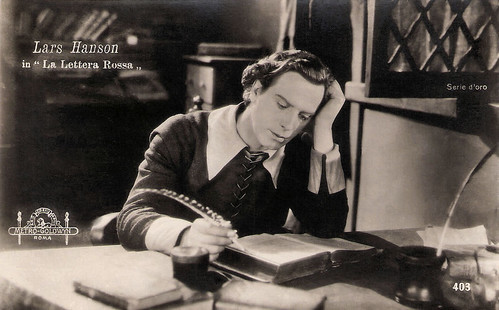
Italian postcard by Ballerini & Fratini, Firenze, no. 403. Photo: Metro-Goldwyn-Mayer, Roma. Lars Hanson as Reverend Arthur Dimmesdale in the period piece The Scarlet Letter (Victor Sjostrom, 1926), set in the era of the Puritans.

Corinne Griffith . Spanish postcard by La Novela Semanal Cinematografica, no. 87.
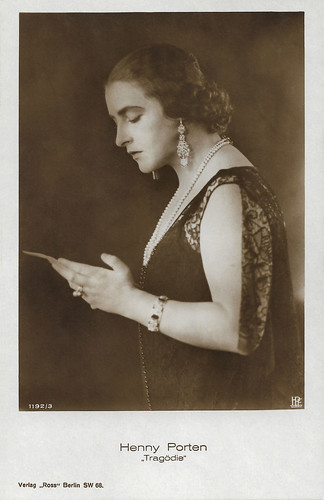
German postcard by Ross Verlag, no. 1192/3, 1927-1928. Photo: Henny-Porten-Film. Henny Porten in the German silent drama Tragödie/Tragedy (Carl Froelich, 1925).
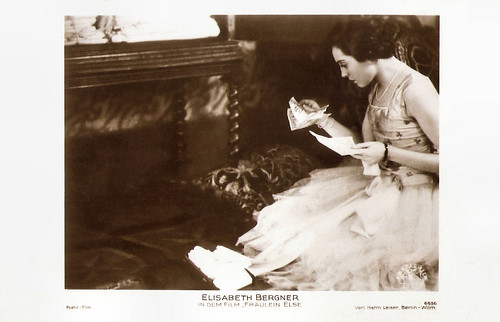
German postcard by Verlag Herm. Leiser, Berlin-Wilm, no. 6656. Photo: Poetic-Film. Elisabeth Bergner in Fräulein Else/Miss Else (Paul Czinner, 1929), based on the play by Arthur Schnitzler.
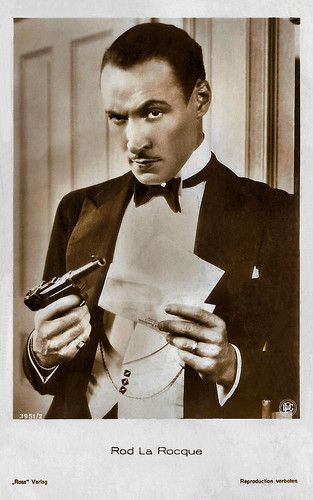
German postcard by Ross Verlag, no. 3851/2, 1928-1929. Photo: PDC. Rod La Rocque in The Locked Door (George Fitzmaurice, 1929).
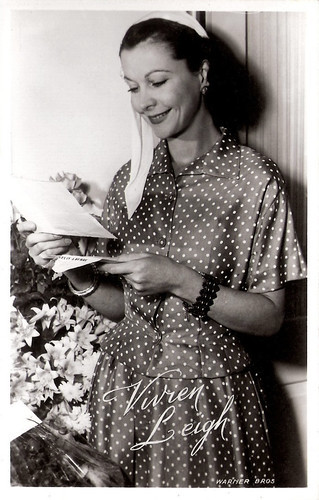
Vivien Leigh . Dutch postcard by Foto-archief Film en Toneel, no. AX 283. Photo: Warner Bros.
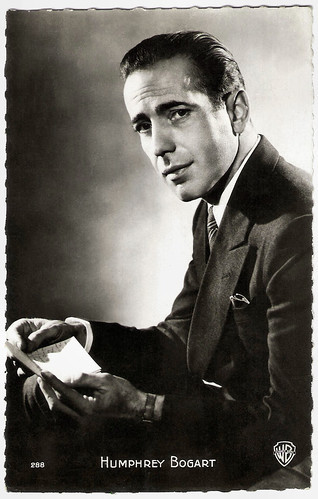
Humphrey Bogart. French postcard by Editions P.I., Paris, no. 288. Photo: Warner Bros.
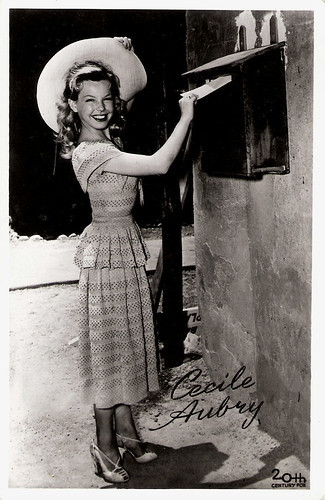
Cécile Aubry . Dutch postcard by Uitg. Takken, Utrecht, no. 377. Photo: 20th Century Fox.
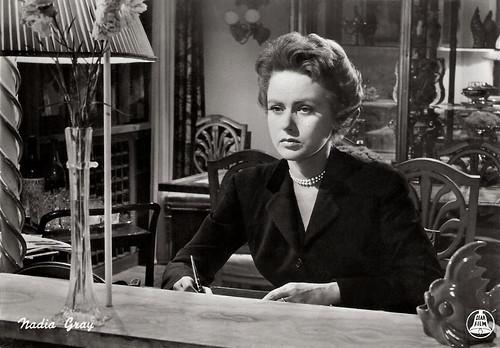
Italian postcard by Bromofoto, Milano, no. 135. Photo: Dear Film. Nadia Gray in Puccini (Carmine Gallone, 1953).
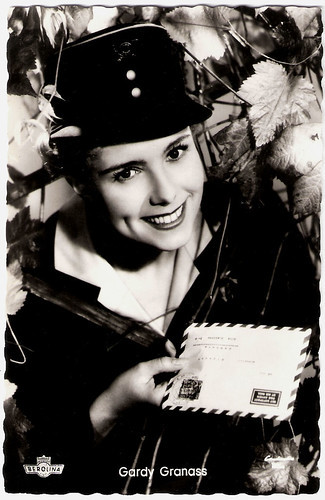
German postcard by Kolibri-Verlag, Minden/Westf., no 2323. Photo: Berolina / Constantin. Gardy Granass in Die Christel von der Post (Karl Anton, 1956).
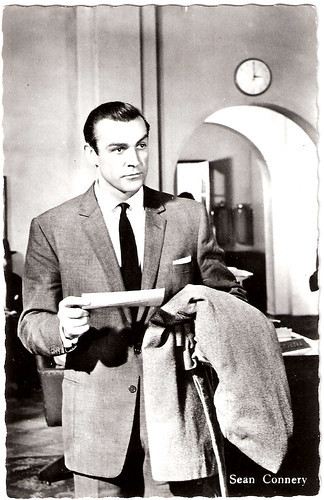
Dutch postcard. Sean Connery as James Bond in From Russia with Love (Terence Young, 1963).

German postcard in the Film Sterne Series by Rotophot, no. 515/2. Photo: Messter Film, Berlin. Henny Porten in the German two-part silent film drama Die Faust des Riesen (Rudolf Biebrach, 1917).

Italian postcard by IPA CT. V. Uff. Rev. St. - Terni, no. 5074. Photo: Tiber Film. Postcard for La Cuccagna (Baldassarre Negroni, 17 1917), starring Hesperia as Renata Beraud, here also with Claudio Nicola as Aristide Saccard. Caption: "Saccard cannot pay the bills of his wife anymore."

Spanish collectors card for Chocolat Imperiale by Imp. Bayer Hnos. y C.a. Chromophotography. Lyda Borelli in the Italian melodrama Il dramma di una notte/The Drama of One Night (Mario Caserini, 1918).

Spanish postcard by Amatller Marca Luna, Series 6, no. 14. Photo: Eclipse. Suzanne Grandais in the French drama Lorena (Georges Tréville, 1918).

German postcard by Verlag Hermann Leiser, Berlin, no. 3239. Photo: Treumann-Larsen-Film. Rosa Porten and Theodor Loos in Die Augen der Schwester/The eyes of the sister (Franz Eckstein, 1918). Porten also scripted the film.

German postcard by Photochemie, Berlin, K. 2268. Photo: Berliner Film-Manufaktur. Lya Mara and Victor Janson in Die Serenyi (Alfred Halm, 1918).

German postcard by Verlag Ross, no. 590. Photo: Ring-Film. Bruno Kastner and Hanni Weisse in the German silent film Zwischen zwei Welten/Between two worlds (Adolf Gärtner, 1919).

German postcard by Ross Verlag, Berlin, no. 288/2, 1919-1924. Fern Andra Atelier. Caption: Fern Andra in ihrem Heim (Fern Andra at her home).

Italian postcard. Photo: Rinascimento Film, Roma. Pina Menichelli in La seconda moglie (Amleto Palermi, 1923). Caption: That monotonous and grey life awoke in the rebel a whole lost world.

Italian postcard by G.B. Falci, Milano. Pina Menichelli and Livio Pavanelli in La seconda moglie (Amleto Palermi, 1923).
The rising gorge of the wicked woman
In her fascinating, ironic text, 'Short Manual for the Aspiring Scenario Writer', the French author Colette gave a typical description of the femme fatale in cinema, largely based on Pina Menichelli . Talking about the 'arms' of the femme fatale Colette indicates the hat and the rising gorge:
"The femme fatale's hat spares her the necessity, at the absolute apex of her wicked career, of having to expend herself in pantomime.
When the spectator sees the evil woman coiffing herself with a spread-winged owl, the head of a stuffed jaguar, a bifid aigrette, or a hairy spider, he no longer has any doubts; he knows just what she is capable of.
And the rising gorge? The rising gorge is the imposing and ultimate means by which the evil woman informs the audience that she is about to weep, that she is hesitating on the brink of crime, that she is struggling against steely necessity, or that the police have gotten their hands on the letter.
What letter? THE letter."

Ernst Rückert. Austrian postcard by Iris Verlag, no. 686. Photo: Naxos-Film / Verleih E. Weil & Co.

Italian postcard by Ballerini & Fratini, Firenze, no. 403. Photo: Metro-Goldwyn-Mayer, Roma. Lars Hanson as Reverend Arthur Dimmesdale in the period piece The Scarlet Letter (Victor Sjostrom, 1926), set in the era of the Puritans.

Corinne Griffith . Spanish postcard by La Novela Semanal Cinematografica, no. 87.

German postcard by Ross Verlag, no. 1192/3, 1927-1928. Photo: Henny-Porten-Film. Henny Porten in the German silent drama Tragödie/Tragedy (Carl Froelich, 1925).

German postcard by Verlag Herm. Leiser, Berlin-Wilm, no. 6656. Photo: Poetic-Film. Elisabeth Bergner in Fräulein Else/Miss Else (Paul Czinner, 1929), based on the play by Arthur Schnitzler.

German postcard by Ross Verlag, no. 3851/2, 1928-1929. Photo: PDC. Rod La Rocque in The Locked Door (George Fitzmaurice, 1929).

Vivien Leigh . Dutch postcard by Foto-archief Film en Toneel, no. AX 283. Photo: Warner Bros.

Humphrey Bogart. French postcard by Editions P.I., Paris, no. 288. Photo: Warner Bros.

Cécile Aubry . Dutch postcard by Uitg. Takken, Utrecht, no. 377. Photo: 20th Century Fox.

Italian postcard by Bromofoto, Milano, no. 135. Photo: Dear Film. Nadia Gray in Puccini (Carmine Gallone, 1953).

German postcard by Kolibri-Verlag, Minden/Westf., no 2323. Photo: Berolina / Constantin. Gardy Granass in Die Christel von der Post (Karl Anton, 1956).

Dutch postcard. Sean Connery as James Bond in From Russia with Love (Terence Young, 1963).
Published on July 03, 2020 22:00
Paul van Yperen's Blog
- Paul van Yperen's profile
- 13 followers
Paul van Yperen isn't a Goodreads Author
(yet),
but they
do have a blog,
so here are some recent posts imported from
their feed.



